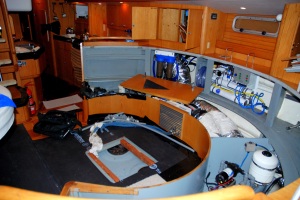 A ring tailed lemur
A ring tailed lemur
Reunion to Durban – Part 1
Tuesday 30th October 2018
The Indian Ocean continues to challenge us. The exit from Reunion, last Wednesday, was even more lively than expected, with high winds and horribly rough sea. In our rather rushed departure I had forgotten to take a seasick pill and I rapidly became unwell. Even my trusty tablets that I put under my top lip couldn’t stop the waves of dreadful nausea.
Having been told we couldn’t stay in the marina we had decided to leave quickly so that we could sail with the Oyster Rally boats who had very kindly invited us, and Atem the Blue Swan, to join their SSB radio net. With such a tricky crossing in front of us there is comfort in numbers and the pooling of knowledge means we would be very well informed.
Thankfully during the first night things calmed down and my queasiness gradually wore off. The wind dropped right back and on came our engine. Unfortunately, looking forward a week, with the help of our weather router, conditions for our arrival in Durban, still looked difficult. As the forecasts firmed up, it became clear to us that a stop in Madagascar to wait for things to improve might be the solution. So it was therefore that just 3 days into our journey we found ourselves anchored, with four other Oysters that made the same call, in Fort Dauphin on the SE corner of Madagascar.
Madagascar had never even been on our radar, we knew very little about it. Whales breaching and fin slapping greeted us at the entrance to the bay, which we were surprised to find, with its backdrop of mountains and several European influenced villas above the beach, looked from a distance, a bit like an Alpine lake resort.
 Fort Dauphin
Fort Dauphin
The view from the deck proved to be deceptive, ashore, the smells, the slightly beaten up buildings, the rutted roads, the lovely wooden canoes and the smiling faces of the people, were all very African. We were met at the beach by an excited gang of youngsters and a few adults, all keen to help bring the dingy up the beach and look after it for us. The women and children persistently offered cheap jewellery for sale, the men waved taxi keys or offered to be our guide. The throng was a bit intense but all very friendly.
 Local wooden canoes
Local wooden canoes
We were shown the way to the immigration office where much filling of forms and enthusiastic stamping took place before a fee of over £100 was demanded. There was slight suspicion amongst the crews that this amount was fairly arbitrary and set to fit how much they thought we would pay. Barring Galapagos, with its National Park fees, I think it must be the highest amount we have paid to enter any country, but we were stuck here, we had to pay up.
A few trips to the ATM were in order and after a data sim was purchased we returned to Raya to rest, and, what else, to study the weather forecasts. We assured ourselves we had made the best decision, we would be here a couple of days. Heck, we were in Madagascar, time to find the lemurs.
Our taxi drivers car, a bright blue, tiny ancient Renault, was only just big enough for us and our guide, who, reassuringly, wore a sign saying ‘Official Guide’ in big letters around his neck. They told us they would take us to a private reserve where we could get close to the lemurs, but to be honest they could have been taking us anywhere, our normal careful research not done, we were in their hands. We wound our way through the crowded, narrow streets and through the bustling market area, stopping at yet another ATM to get more tens of thousands of Madagascan Rand, even after our time in Indonesia, we were struggling to get our head around all those zeros.
Leaving the town behind we turned onto a smooth wide dual carriage way, rice paddies and other crops filling the narrow strip of land between the mountains and the coast. Our comfort and speed was, however, short lived, as within minutes we took an unmade road towards the mountains. It had rained heavily all night and our driver was quickly confronted by deep puddles that filled the bumpy track.
 Overnight rain made the roads almost impassable.
Overnight rain made the roads almost impassable.
He’d obviously tackled this before as he torturously wound his way between them, his little car manfully battling on. Villages lay every few miles, consisting of collections of huts constructed totally from the bamboo that grows everywhere here, the walls from the stiff stems, the roofs from the fronds. We passed a gash in the mountain, shockingly rock was being hewn from its sides by hand, carried to the nearest village and made into square bricks.
 Yes that’s a duck wandering past stone bricks, hand made straight from the mountain
Yes that’s a duck wandering past stone bricks, hand made straight from the mountain
A continuous stream of people walked between the villages, mostly carrying goods either strung from bamboo sticks, or in the case of the women in baskets miraculously balanced on their heads. A man driving four head of cattle squeezed to the side of the road to let us pass, we stared out of the window wide eyed, this truly was, another place, a world away from our comfortable European lives.
 Everyone uses the one road through the villages
Everyone uses the one road through the villages
Eventually we reached the reserve and found our lemurs. They are really lovely creatures with expressive human like faces, their bodies covered in lush soft hair and their long bushy tails used skilfully, almost like an extra limb. We saw tiny Bamboo lemurs sat high amongst the shade of the dense foliage at the top of 30ft bamboo clumps, brown lemurs athletically leaping from impossibly spindly branches in the very tops of the trees and ring tailed lemurs that peered at us from crooks in the tree trunks.
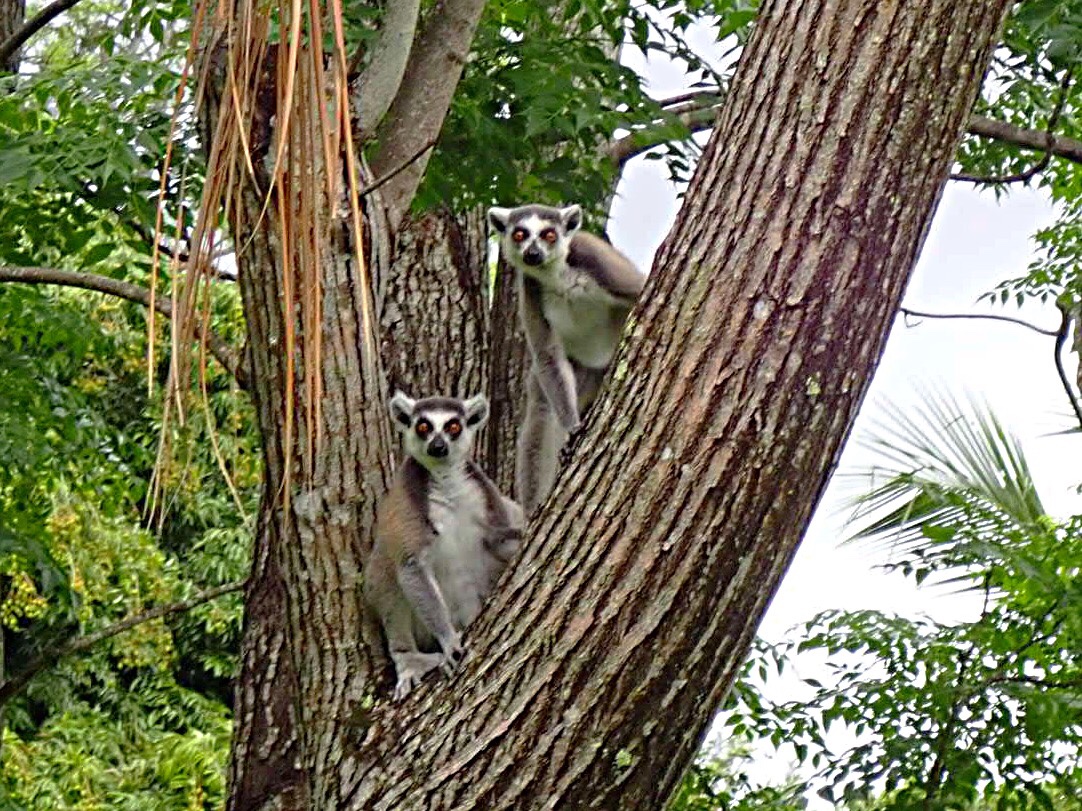 Ring tailed lemurs
Ring tailed lemurs
But the friendliest were the white lemurs, nick named dancing lemurs they nimbly swang from branch to branch, ran up and down the tree trunks and came right up to us looking for food.
 White lemur
White lemur
What an amazing morning. Praying for no more rain we followed the rough road back to the bay, ran the gauntlet of locals on the beach and returned to the boat. The days weather report had arrived, it was time to move on, our unscheduled stop had turned out to be so much more than a safe place to wait for the weather systems to get in line. Despite our fears this little corner of Madagascar, at least, is delightful.
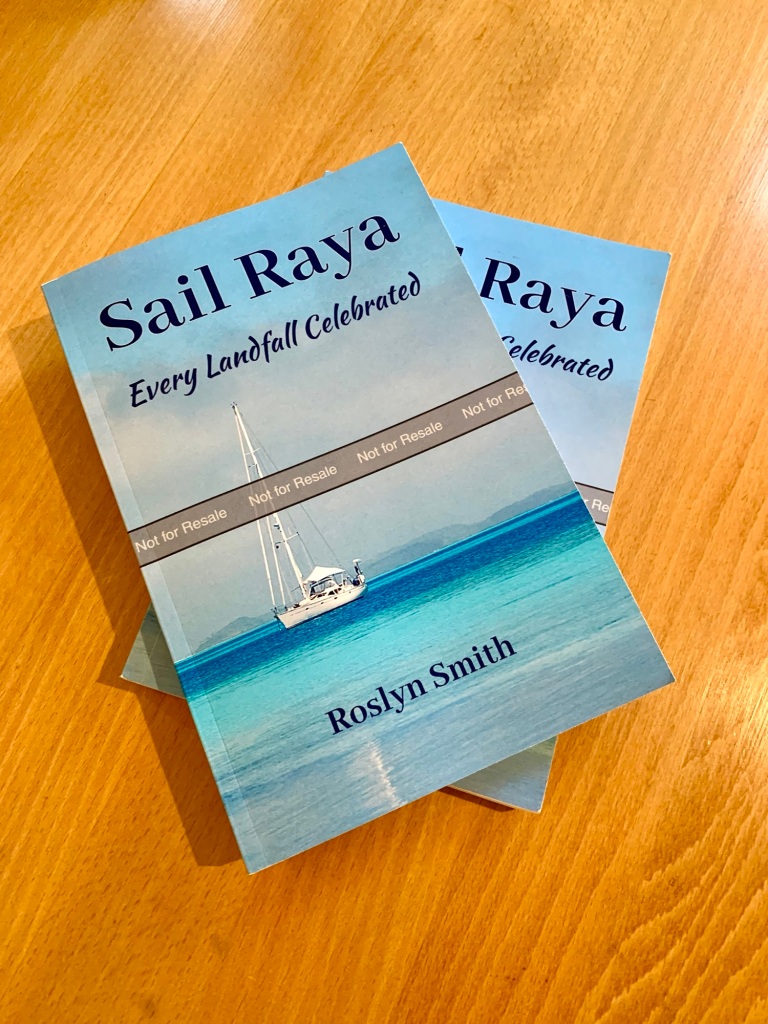



 Gradually putting on more clothes
Gradually putting on more clothes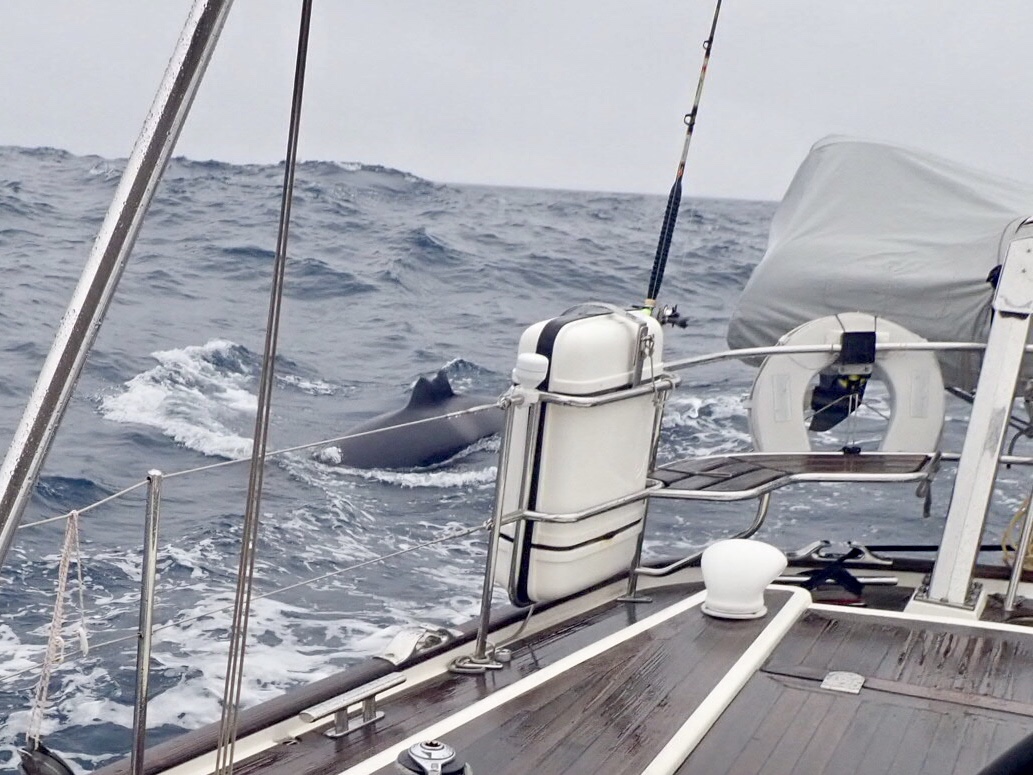 Killer whales swam right next to the boat, this one seems to have a rather big chunk out of his fin.
Killer whales swam right next to the boat, this one seems to have a rather big chunk out of his fin. UK coast on the chart plotter for the first time in four years
UK coast on the chart plotter for the first time in four years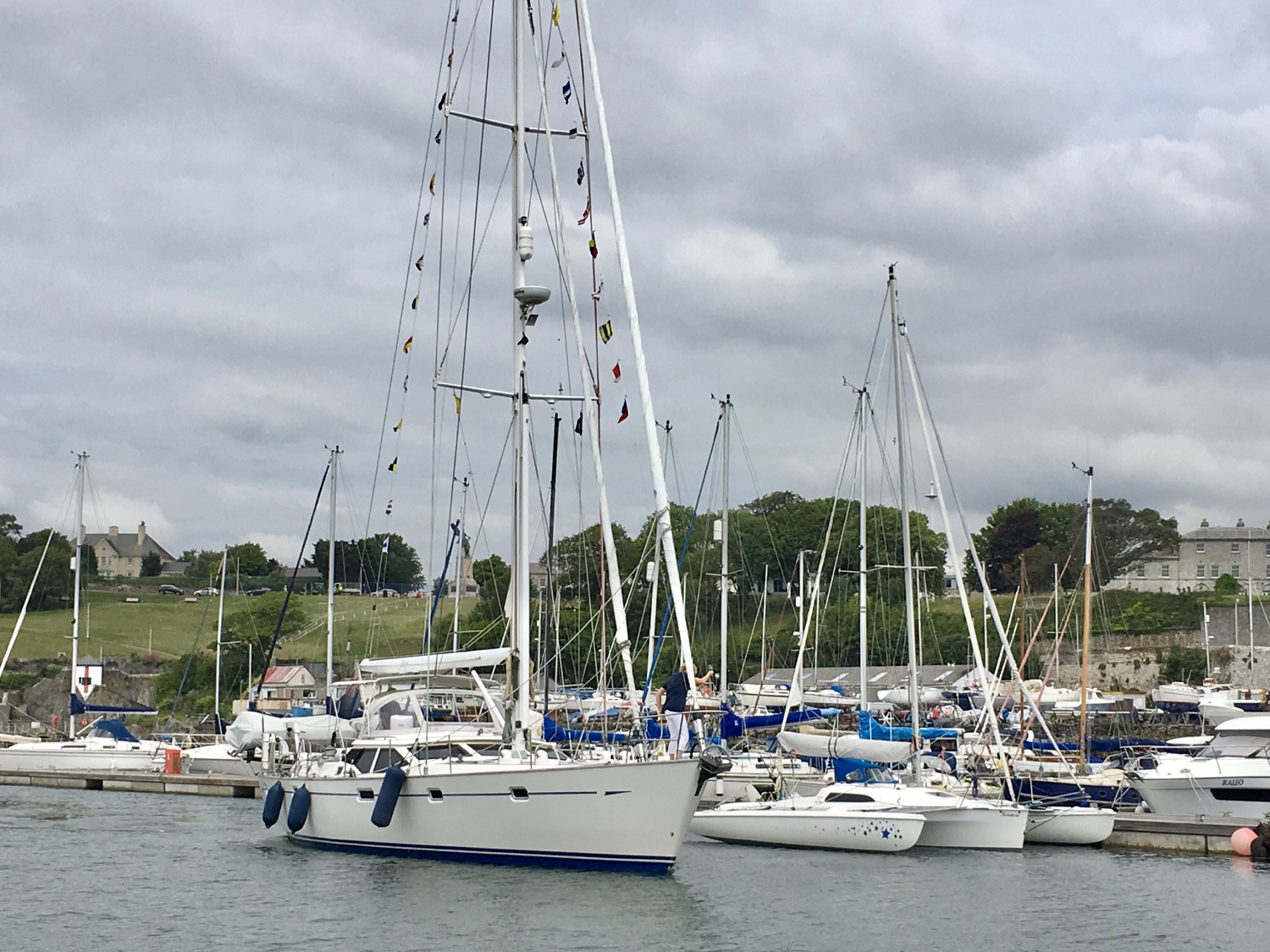 Raya arrives back in the UK
Raya arrives back in the UK

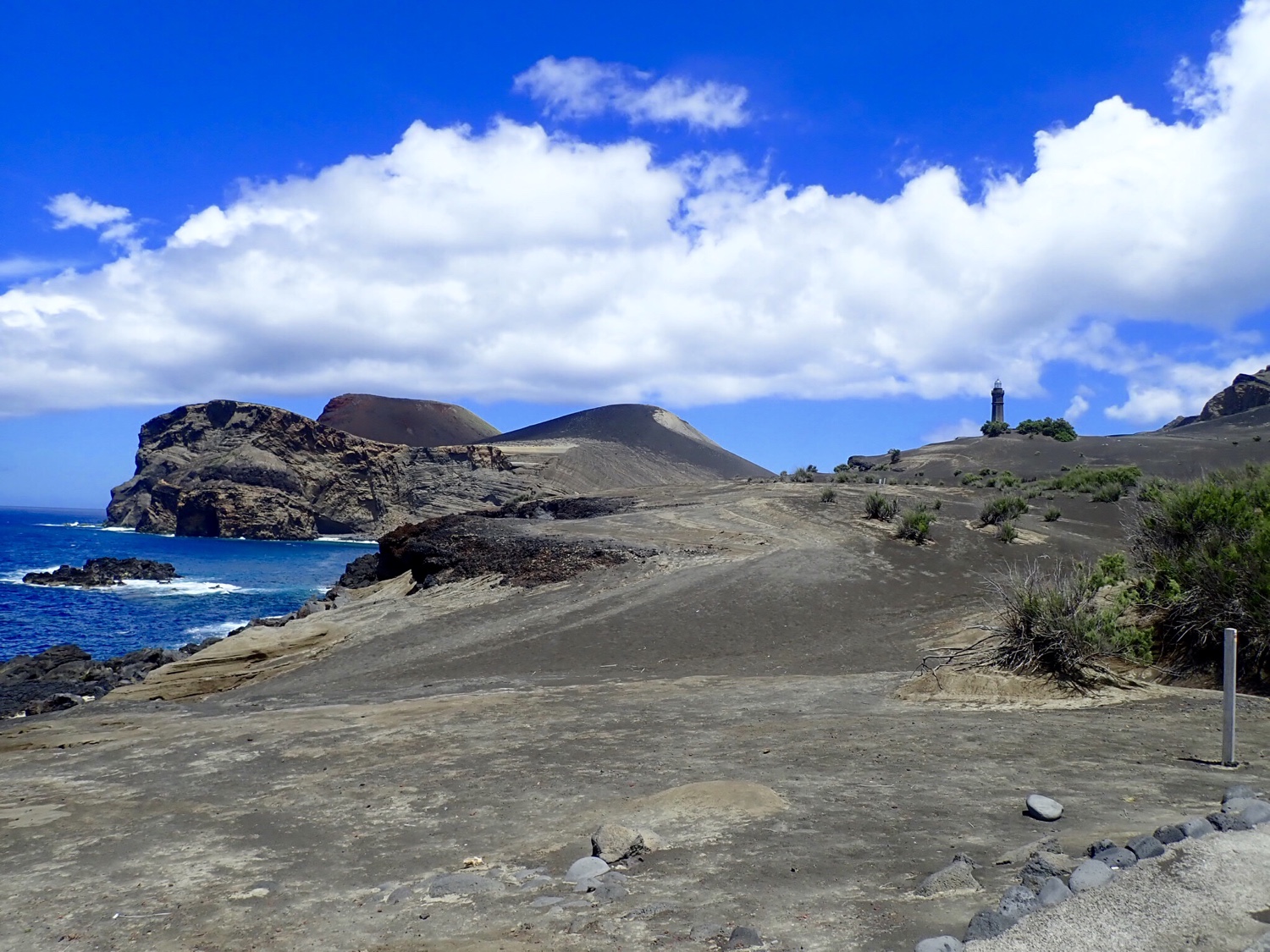

 ‘Got here beer’ in Horta
‘Got here beer’ in Horta A clump of a dozen sailing jelly fish
A clump of a dozen sailing jelly fish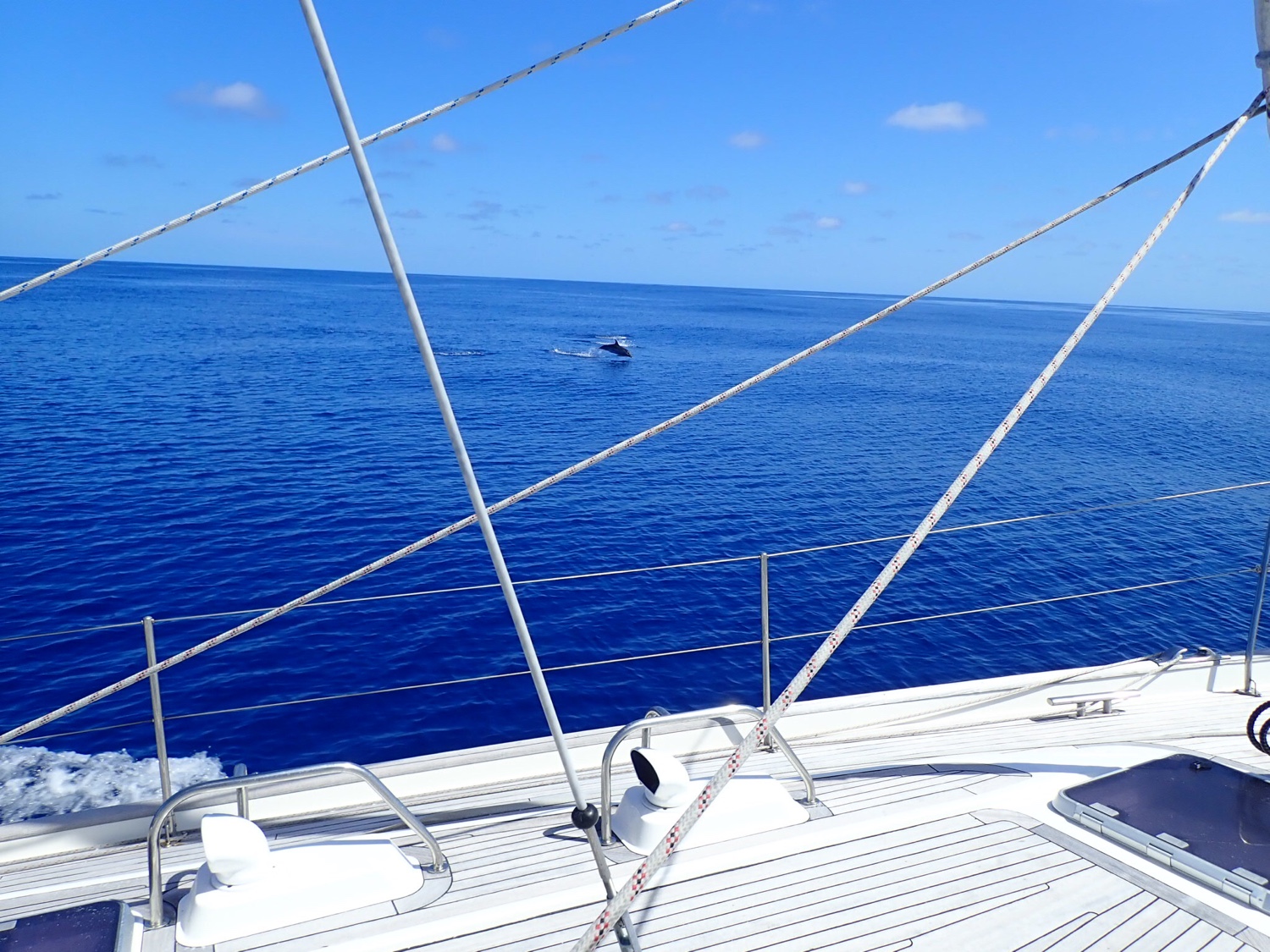 A pod of dolphins charging in to swim at our bows
A pod of dolphins charging in to swim at our bows Sun rising over a silky sea
Sun rising over a silky sea


 Preparations in full swing, Rick scrubbing a very furry prop
Preparations in full swing, Rick scrubbing a very furry prop Stunning tropical colours in the BVI
Stunning tropical colours in the BVI Not sure who this chap is but his home is a colourful mini reef
Not sure who this chap is but his home is a colourful mini reef Thursdays sunset
Thursdays sunset It might be rolly but the views pretty good
It might be rolly but the views pretty good A slightly clumsy take off but he made it.
A slightly clumsy take off but he made it. The cave was full of thousands of fish, tiny and huge (see bottom right corner)
The cave was full of thousands of fish, tiny and huge (see bottom right corner) Tarpons carolling their supper
Tarpons carolling their supper Final walk along the beach at Trellis Bay
Final walk along the beach at Trellis Bay Fruit Salad Beach, Gorda Sound
Fruit Salad Beach, Gorda Sound Fan corals in Gorda Sound
Fan corals in Gorda Sound Robyn exploring the Baths
Robyn exploring the Baths Hawksbill turtle with a couple of small remora hitching a lift
Hawksbill turtle with a couple of small remora hitching a lift Hills of Tortola in the morning light
Hills of Tortola in the morning light Mangroves stripped bare but the Atlantic forces its way into the lagoon just the same.
Mangroves stripped bare but the Atlantic forces its way into the lagoon just the same.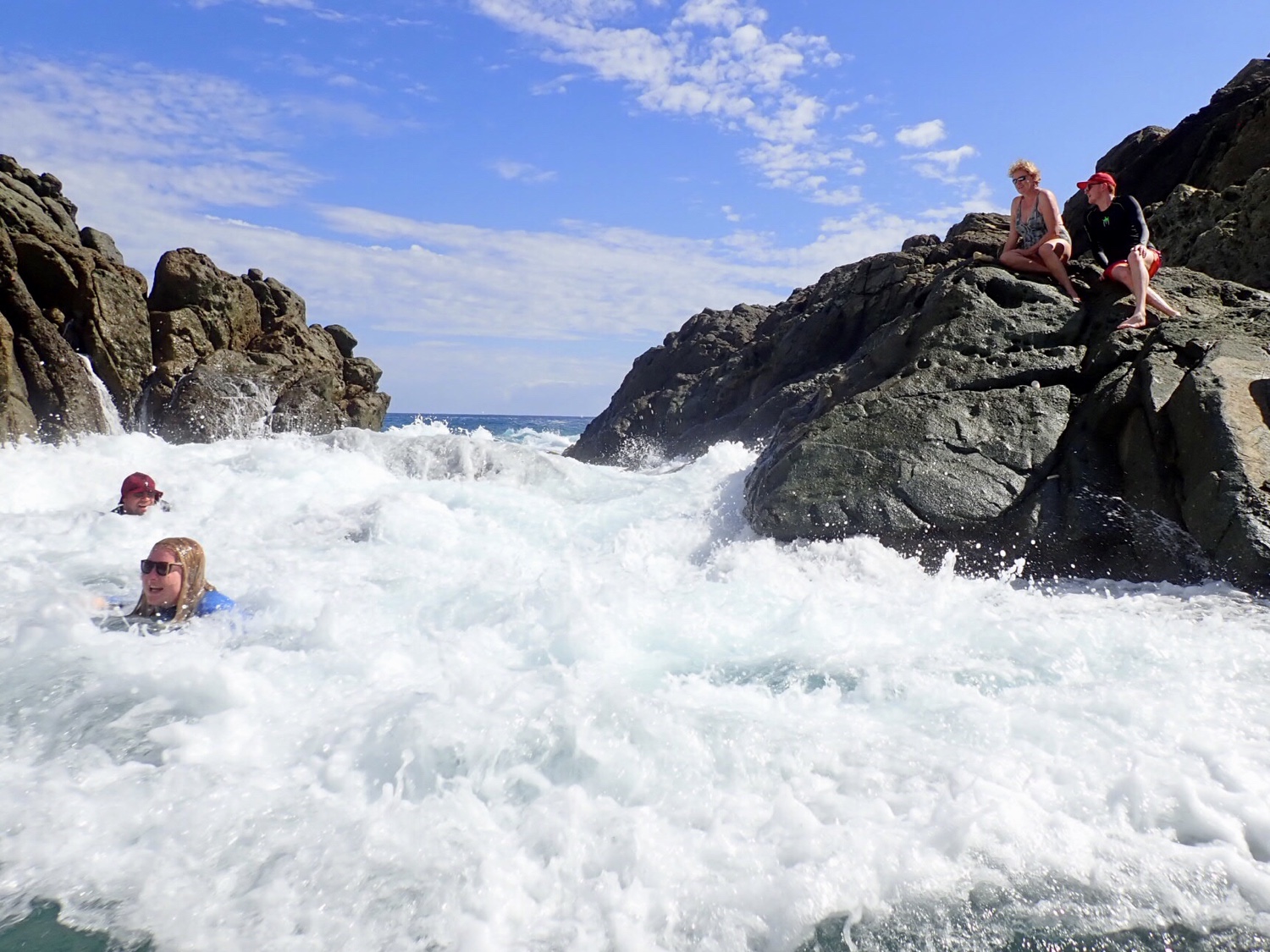 Having fun at the Bubbly Pool, Diamond Cay
Having fun at the Bubbly Pool, Diamond Cay A queen trigger fish snapped by Matt and a perfect Parrot fish caught by Rick
A queen trigger fish snapped by Matt and a perfect Parrot fish caught by Rick Wrecks still litter Trellis Bay
Wrecks still litter Trellis Bay Readying to snorkel around Monkey Point
Readying to snorkel around Monkey Point Cane Garden Bay
Cane Garden Bay Crew earning their keep
Crew earning their keep Just plain greedy
Just plain greedy Lunch time view
Lunch time view Pretty streets in Gustavia
Pretty streets in Gustavia Racing Yacht Sorcha setting out for a sail
Racing Yacht Sorcha setting out for a sail The stunning 200ft schooner Athos joins us in Hermitage Bay.
The stunning 200ft schooner Athos joins us in Hermitage Bay. The old dockyard buildings although converted to commercial use still overlook large sailing boats
The old dockyard buildings although converted to commercial use still overlook large sailing boats Nightscape created by dozens of mega yachts.
Nightscape created by dozens of mega yachts.
 Large spotted porcupine fish
Large spotted porcupine fish Beautiful Indian River
Beautiful Indian River Amazing roots of the Mangrove trees
Amazing roots of the Mangrove trees Iguana sunning himself in the early morning warmth.
Iguana sunning himself in the early morning warmth. Pretty Town of Desharies
Pretty Town of Desharies Marigot Bay from the cliff top
Marigot Bay from the cliff top The Pitons with the roof tops of Soufriere lying in the valley
The Pitons with the roof tops of Soufriere lying in the valley

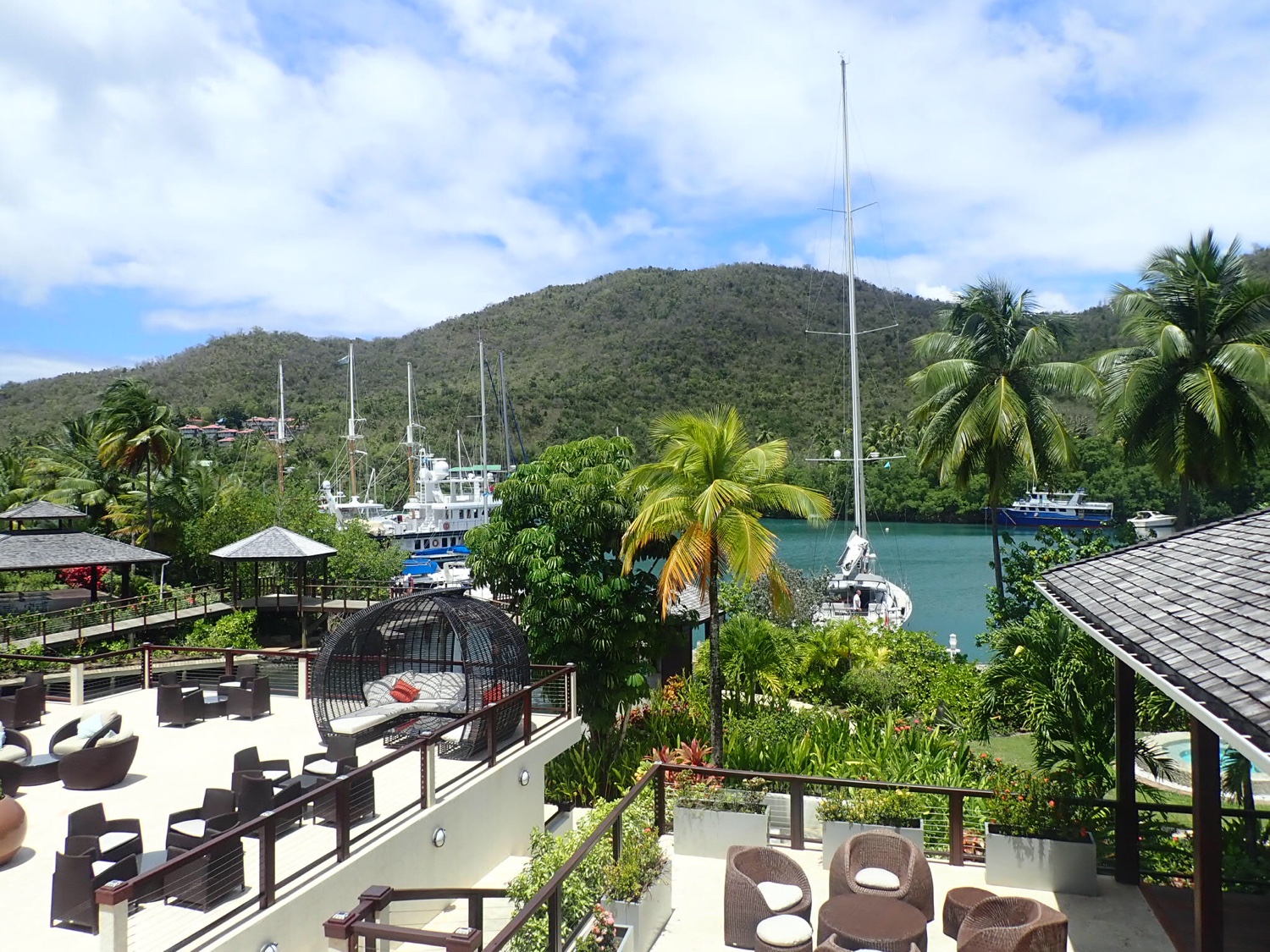 View of Marigot Bay from the resort
View of Marigot Bay from the resort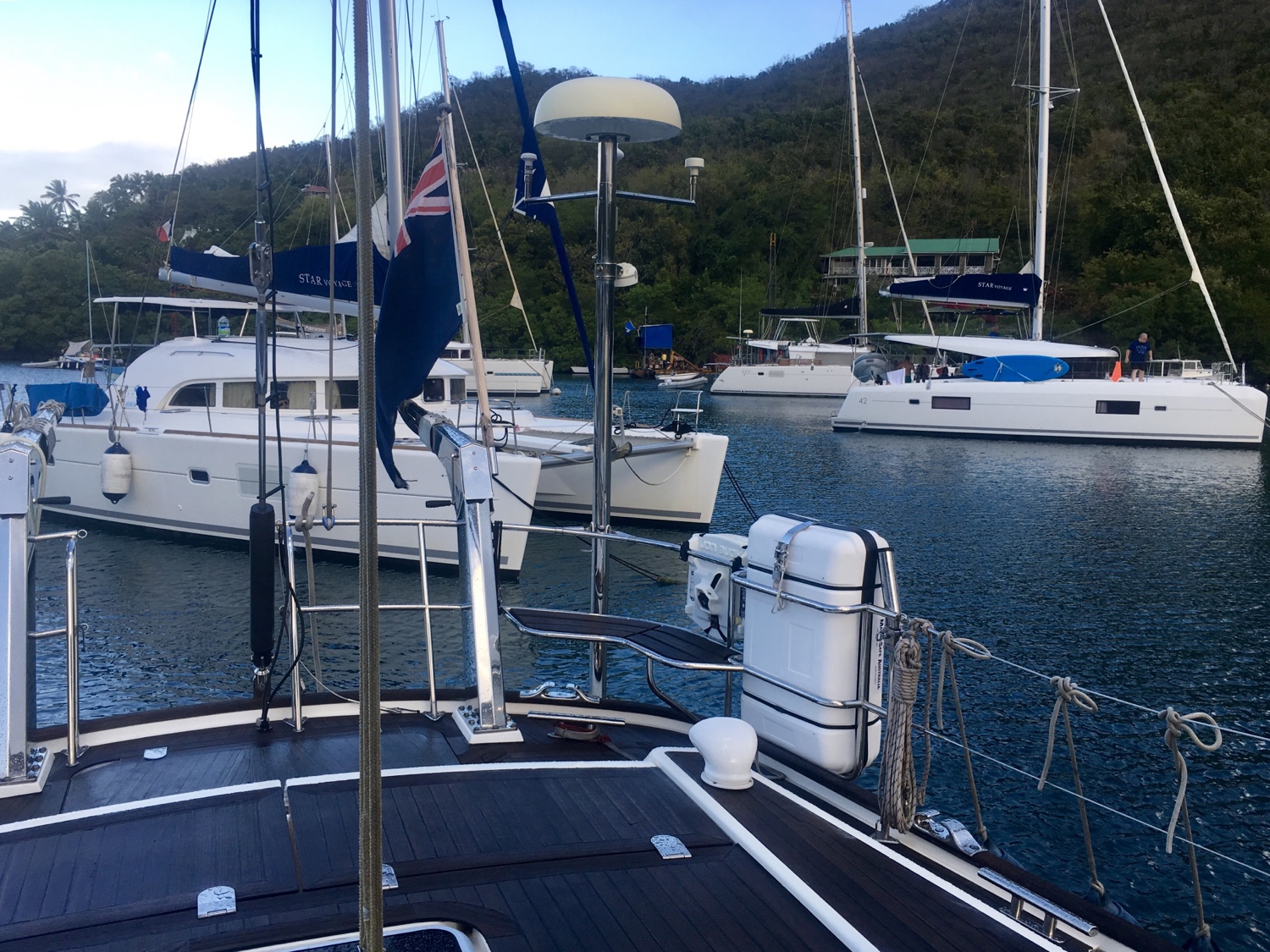 Crowded mooring field at Marigot Bay
Crowded mooring field at Marigot Bay Lovely beach on Sandy Island
Lovely beach on Sandy Island Busy Bay at a Port Elizabeth, Bequia
Busy Bay at a Port Elizabeth, Bequia A shower threatens over the stunning Mountains of St Vincent
A shower threatens over the stunning Mountains of St Vincent Today’s view from the cockpit.
Today’s view from the cockpit. Raya being lifted out of the water by the Hulk, a huge lift in Grenada.
Raya being lifted out of the water by the Hulk, a huge lift in Grenada. Mount Carmel Falls
Mount Carmel Falls Girls taking a cooling dip
Girls taking a cooling dip The pool at our lovely villa in Grenada
The pool at our lovely villa in Grenada Successful fishing day
Successful fishing day Masses of Sargassum seaweed covered the ocean
Masses of Sargassum seaweed covered the ocean Got here beer Grenada
Got here beer Grenada South Atlantic sunrise
South Atlantic sunrise Capturing the moment
Capturing the moment Another squall comes through
Another squall comes through Georgetown and Long beach
Georgetown and Long beach Stunning beaches
Stunning beaches Shark warnngs
Shark warnngs Turtle laying her legs
Turtle laying her legs Walking on a Green Mountain
Walking on a Green Mountain Only customers at the petrol station
Only customers at the petrol station Stunning views all around St Helena
Stunning views all around St Helena James Town
James Town St Helena Ladder
St Helena Ladder Wow! Swimming with Whale Sharks
Wow! Swimming with Whale Sharks Napoleon’s residence while in St Helena
Napoleon’s residence while in St Helena Dodgy fuel dock, Cape Town
Dodgy fuel dock, Cape Town Pontoon wars
Pontoon wars It was a chilly first few days
It was a chilly first few days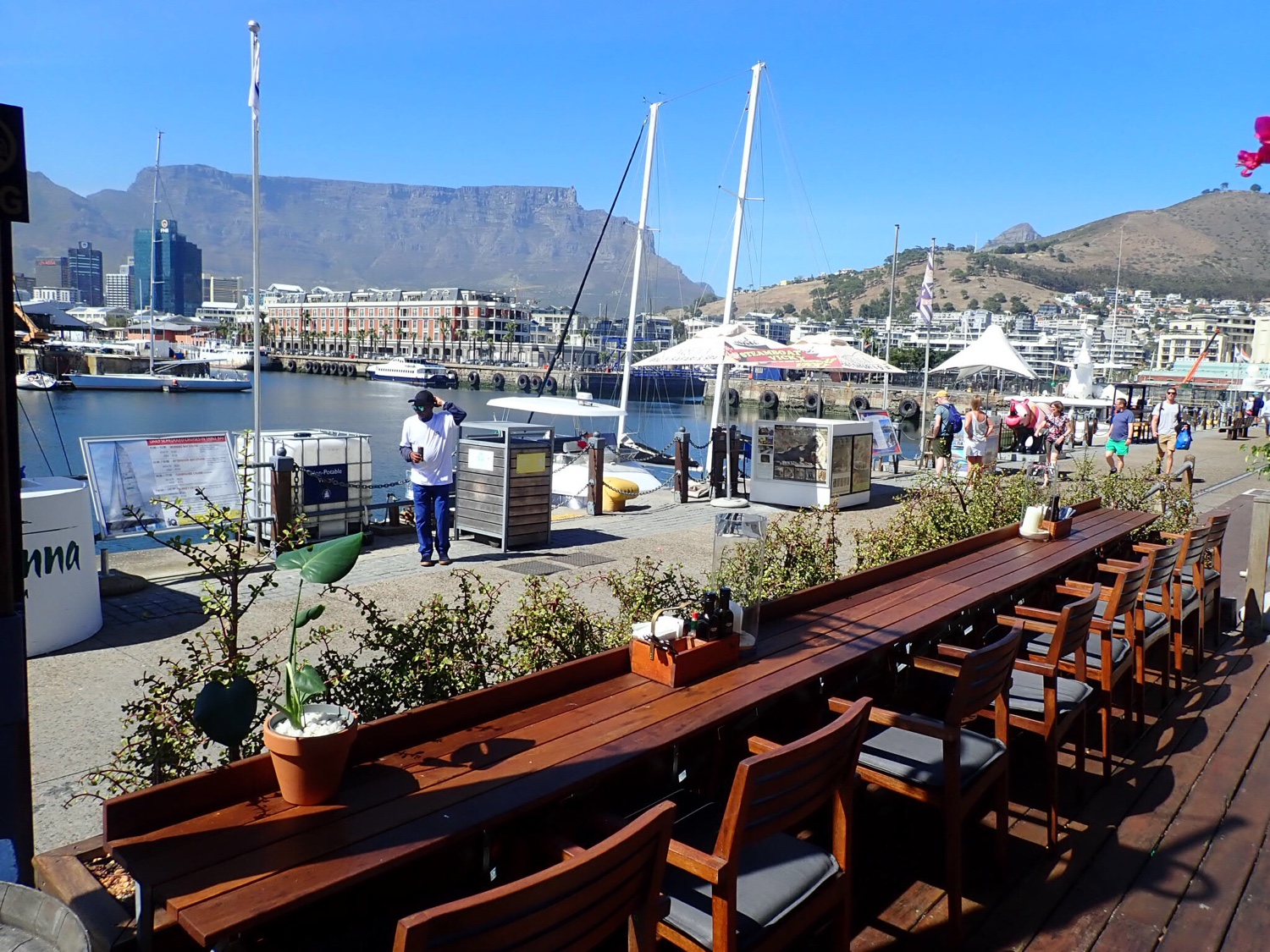 Table mountain from the V&A Watefront.
Table mountain from the V&A Watefront. Signal Hill and Cape Town City
Signal Hill and Cape Town City Taking a break and enjoying the view out to the Cape.
Taking a break and enjoying the view out to the Cape. A bit cold for a swim
A bit cold for a swim Groot Constantia
Groot Constantia Rather rickety pontoons in Port Elizabeth Marina
Rather rickety pontoons in Port Elizabeth Marina Large waves pounding the coast
Large waves pounding the coast The small beach at Storms River Mouth
The small beach at Storms River Mouth The suspension bridges at Storms River mouth.
The suspension bridges at Storms River mouth. Welcome sight as we entered Cape Town
Welcome sight as we entered Cape Town Passing through the bridges to get into the V&A Marina.
Passing through the bridges to get into the V&A Marina. Finally all hands on deck, but too late for a quick get away.
Finally all hands on deck, but too late for a quick get away. A large pod of dolphins joined us and gave a fine display of leaping their antics
A large pod of dolphins joined us and gave a fine display of leaping their antics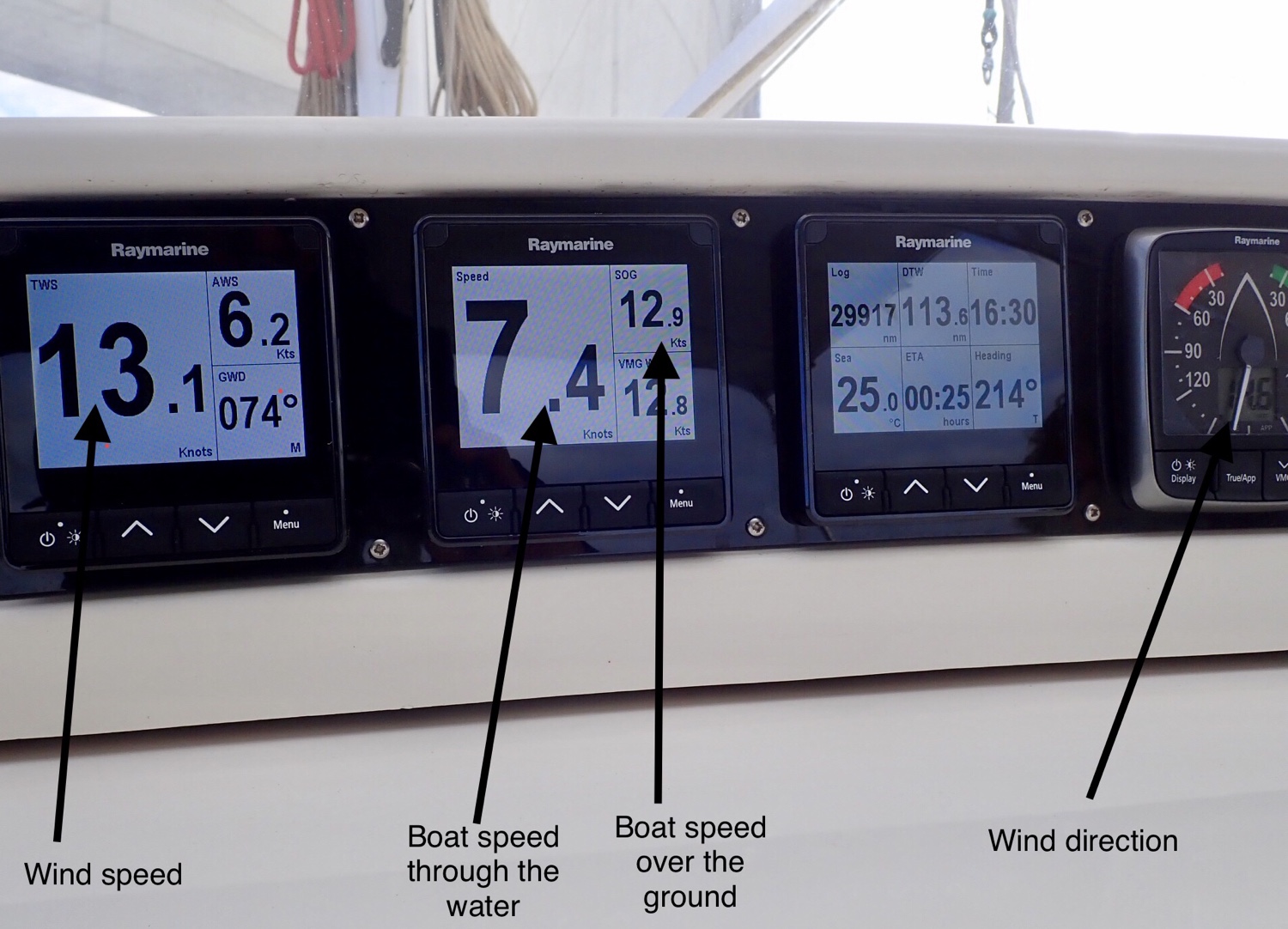 A very odd set of readings as we sped along in 5.5kts of current.
A very odd set of readings as we sped along in 5.5kts of current. We have some very large neighbours.
We have some very large neighbours.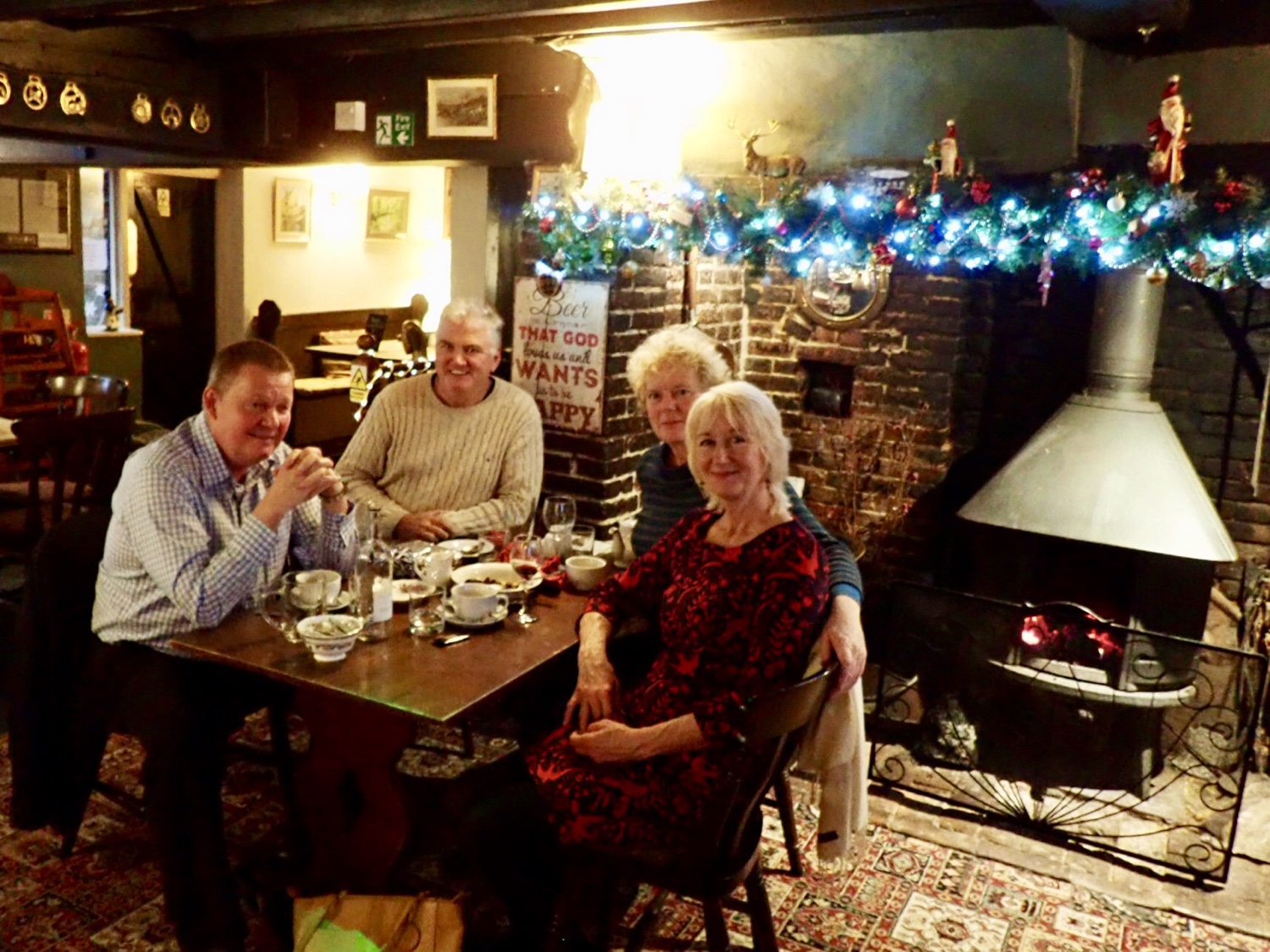 Traditional pub lunch with Tony and Gilly
Traditional pub lunch with Tony and Gilly An abundance of presents
An abundance of presents Dash and Stormi
Dash and Stormi Umhlanga Rocks beach and lighthouse.
Umhlanga Rocks beach and lighthouse.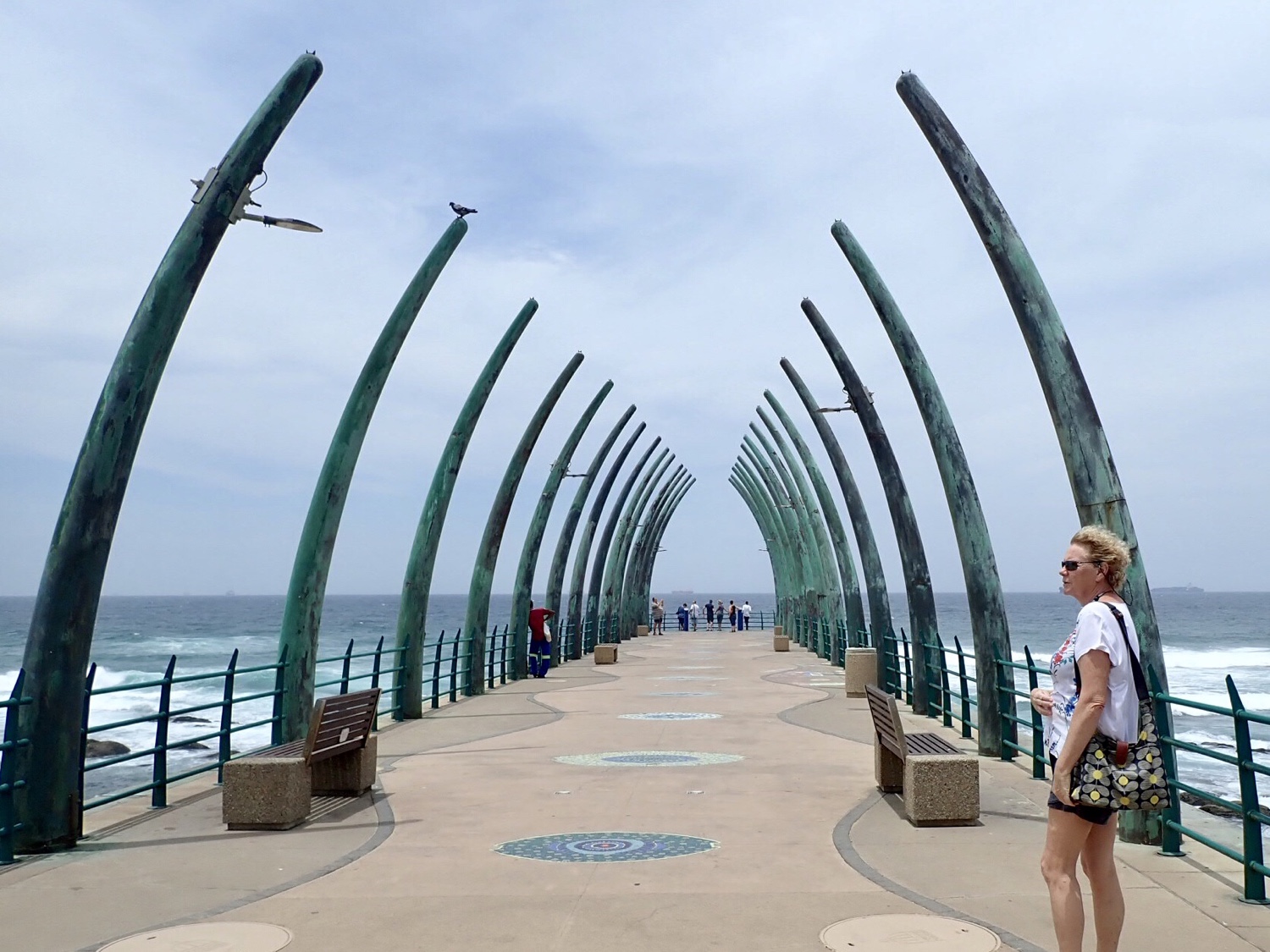 Umhlanga Pier
Umhlanga Pier It’s cold outside!
It’s cold outside! Taking a reflective moment in the cockpit, late afternoon in Durban Marina
Taking a reflective moment in the cockpit, late afternoon in Durban Marina Barbed wire at the yacht club parking gate.
Barbed wire at the yacht club parking gate. Goodbye to the steak and kidney pies.
Goodbye to the steak and kidney pies. Nambiti Game Reserve, in the incredible dawn light
Nambiti Game Reserve, in the incredible dawn light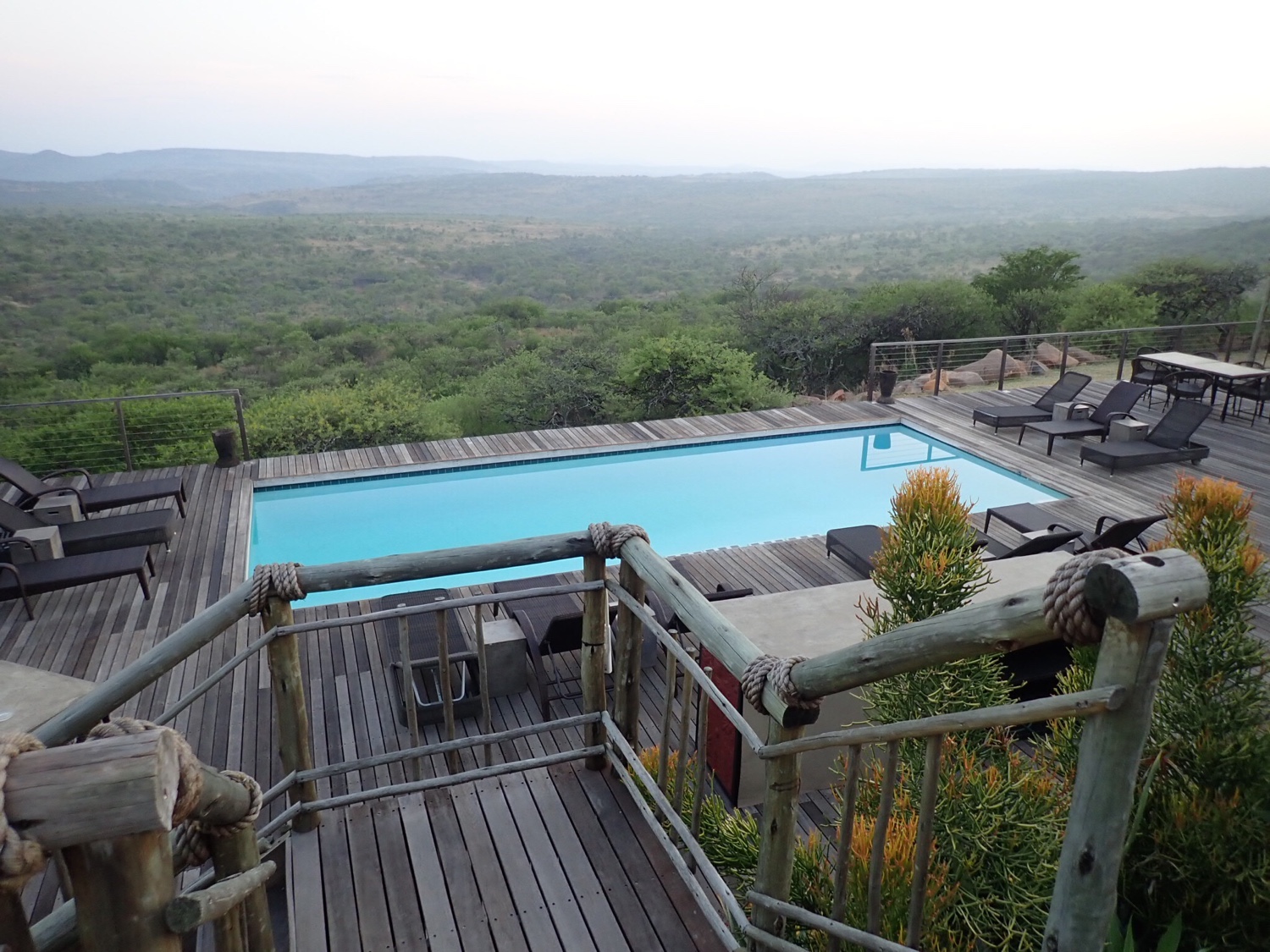 The lodge had a fabulous pool and terrace area
The lodge had a fabulous pool and terrace area The park cuts down the rhino’s horns to make them worthless to the poachers
The park cuts down the rhino’s horns to make them worthless to the poachers Up close and personal with the lions
Up close and personal with the lions A real privilege to be so near to these mighty beasts
A real privilege to be so near to these mighty beasts A young secretarybird takes flight
A young secretarybird takes flight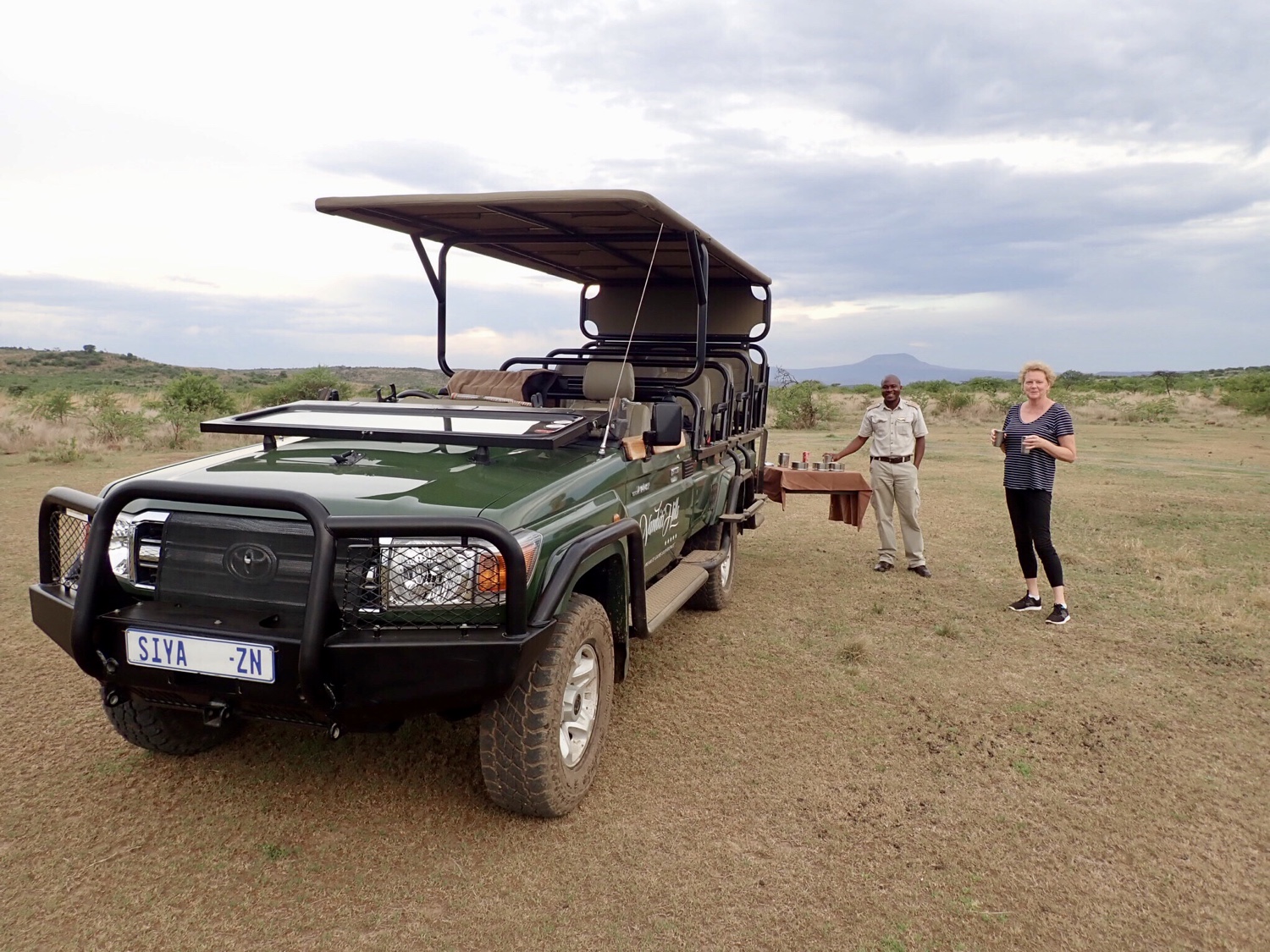 Enjoying the quiet of the Bush with a gin and tonic
Enjoying the quiet of the Bush with a gin and tonic Amazing ears of the female Kudu
Amazing ears of the female Kudu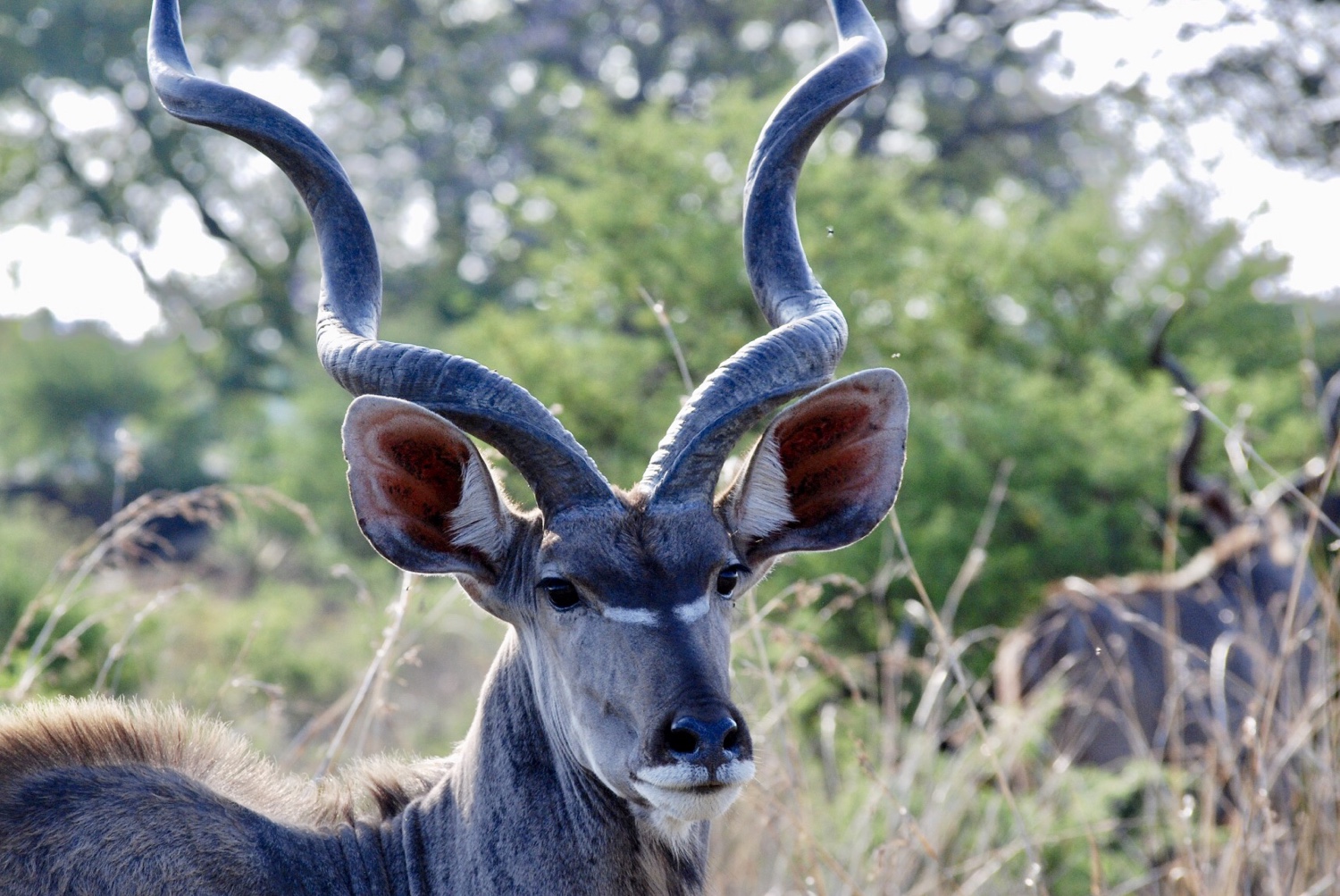 And the curly horns of the males
And the curly horns of the males Delightful legs of the African Wattled Plovers
Delightful legs of the African Wattled Plovers And the priceless expressions on the faces of the giraffes
And the priceless expressions on the faces of the giraffes Whales everywhere between Madagascar and Durban
Whales everywhere between Madagascar and Durban Whale watching off Madagascar
Whale watching off Madagascar Durban ‘got here’ beers
Durban ‘got here’ beers View from the yacht club lawn across Durban Harbour at spring low tide
View from the yacht club lawn across Durban Harbour at spring low tide Art Deco architecture overlooking the harbour
Art Deco architecture overlooking the harbour Tied up with Vella in Richards Bay small craft harbour.
Tied up with Vella in Richards Bay small craft harbour. Crossing the Agulhas Current
Crossing the Agulhas Current Lightening was a bit close for comfort
Lightening was a bit close for comfort Occupants of the St Lucia River
Occupants of the St Lucia River A ring tailed lemur
A ring tailed lemur Fort Dauphin
Fort Dauphin Local wooden canoes
Local wooden canoes Overnight rain made the roads almost impassable.
Overnight rain made the roads almost impassable. Yes that’s a duck wandering past stone bricks, hand made straight from the mountain
Yes that’s a duck wandering past stone bricks, hand made straight from the mountain Everyone uses the one road through the villages
Everyone uses the one road through the villages Ring tailed lemurs
Ring tailed lemurs White lemur
White lemur Magnificent landscape around Reunion Island
Magnificent landscape around Reunion Island Raya rafted in Le Port, the Oyster fleet behind us, all waiting for a weather window
Raya rafted in Le Port, the Oyster fleet behind us, all waiting for a weather window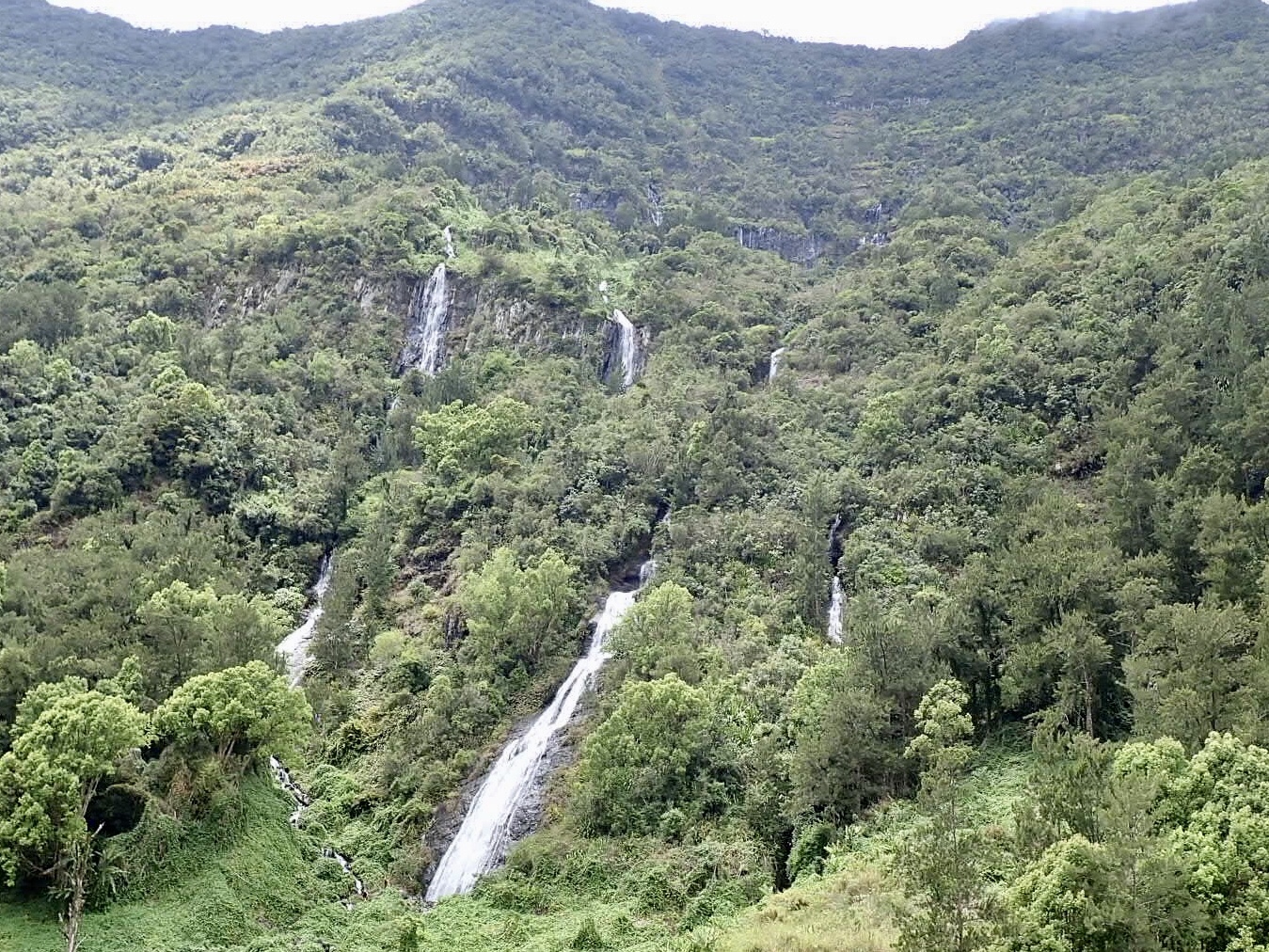 Waterfalls streaked the hillside
Waterfalls streaked the hillside Nice spot to watch the sun go down
Nice spot to watch the sun go down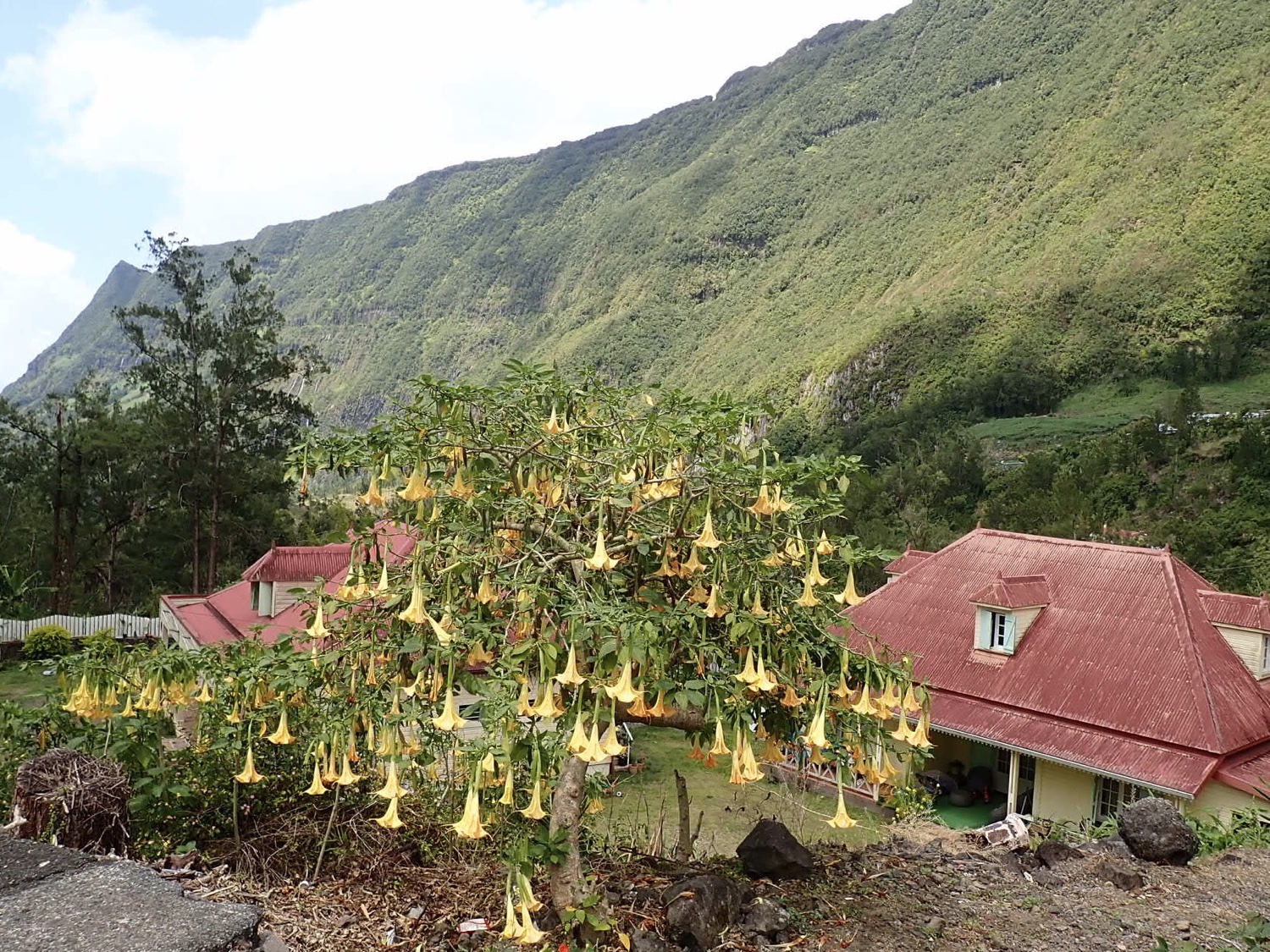 Angel trumpet shrubs brighten the mountain villages
Angel trumpet shrubs brighten the mountain villages Sailing into Port Louis
Sailing into Port Louis Victoria Amazonia Lilies and Lotus flowers and seed pods.
Victoria Amazonia Lilies and Lotus flowers and seed pods. Ganesh the elephant deity
Ganesh the elephant deity Monkeys high up in the Black River National Park
Monkeys high up in the Black River National Park The Seven Coloured Earth
The Seven Coloured Earth Waves up to five meters high persisted for most of the passage.
Waves up to five meters high persisted for most of the passage. A pink sunrise
A pink sunrise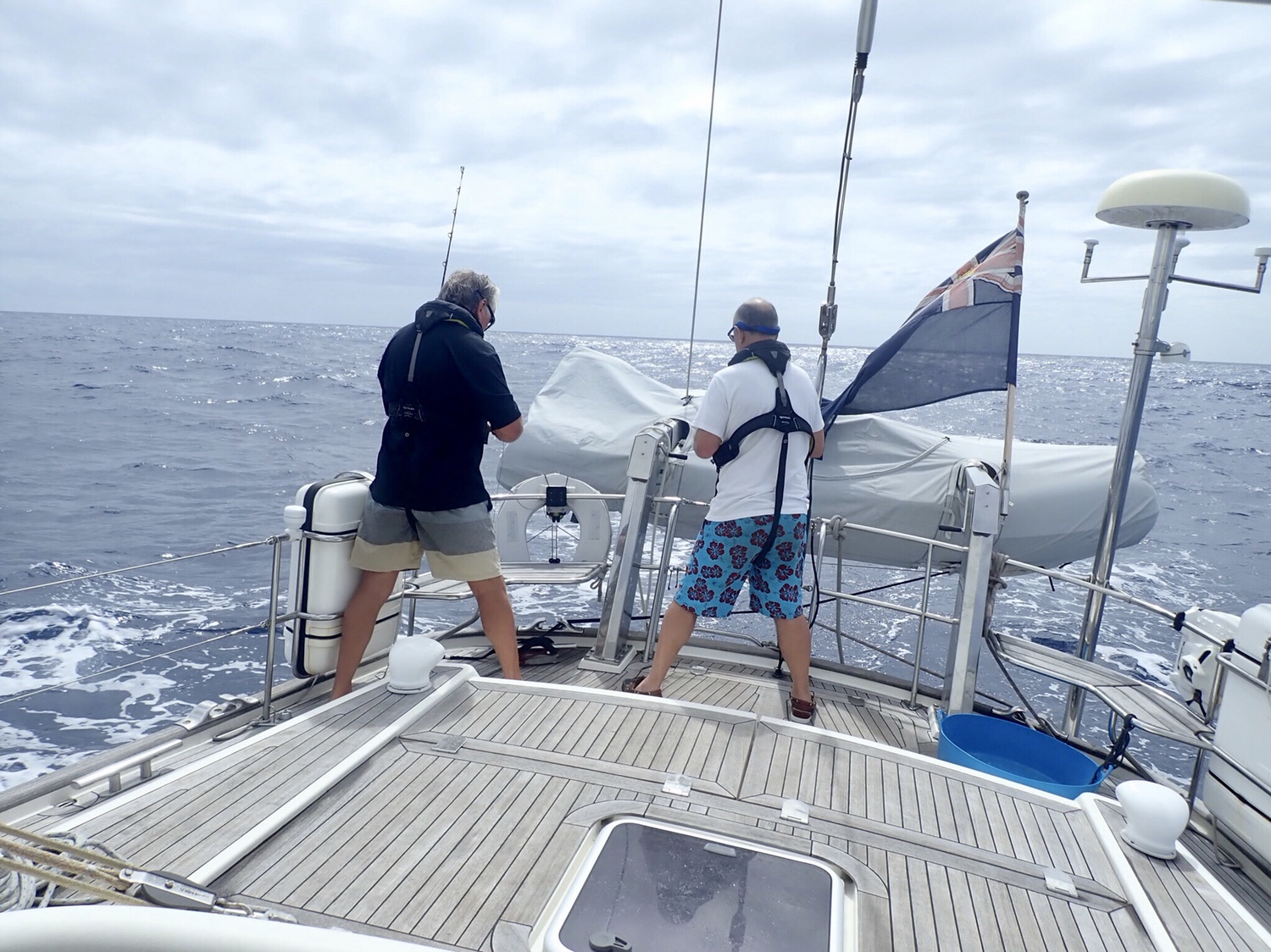 Boys putting out the fishing rod, no bites this trip sadly.
Boys putting out the fishing rod, no bites this trip sadly. Squalls rolling in over the Indian Ocean
Squalls rolling in over the Indian Ocean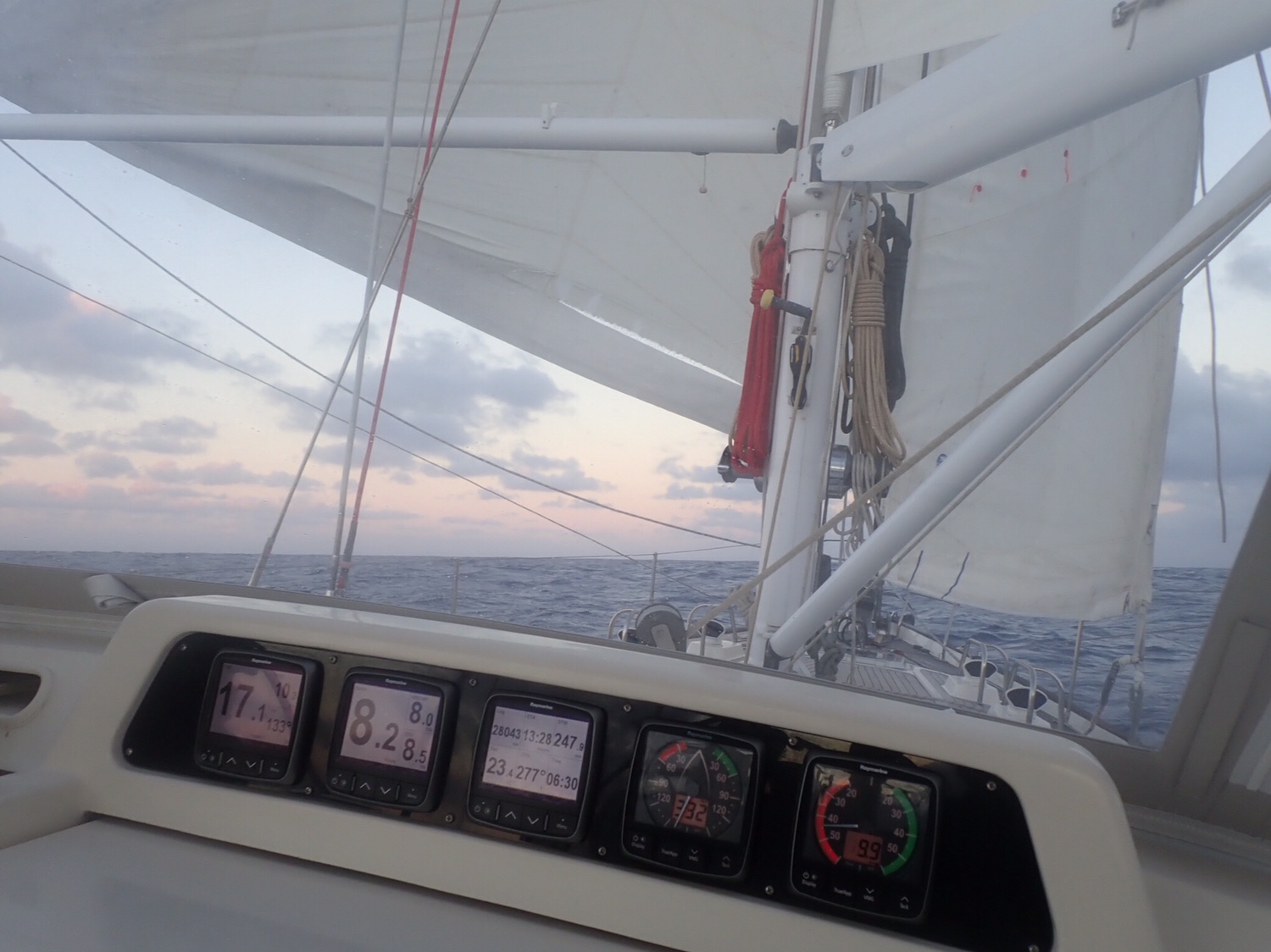 A split in the Genoa
A split in the Genoa Second ‘got here beer’
Second ‘got here beer’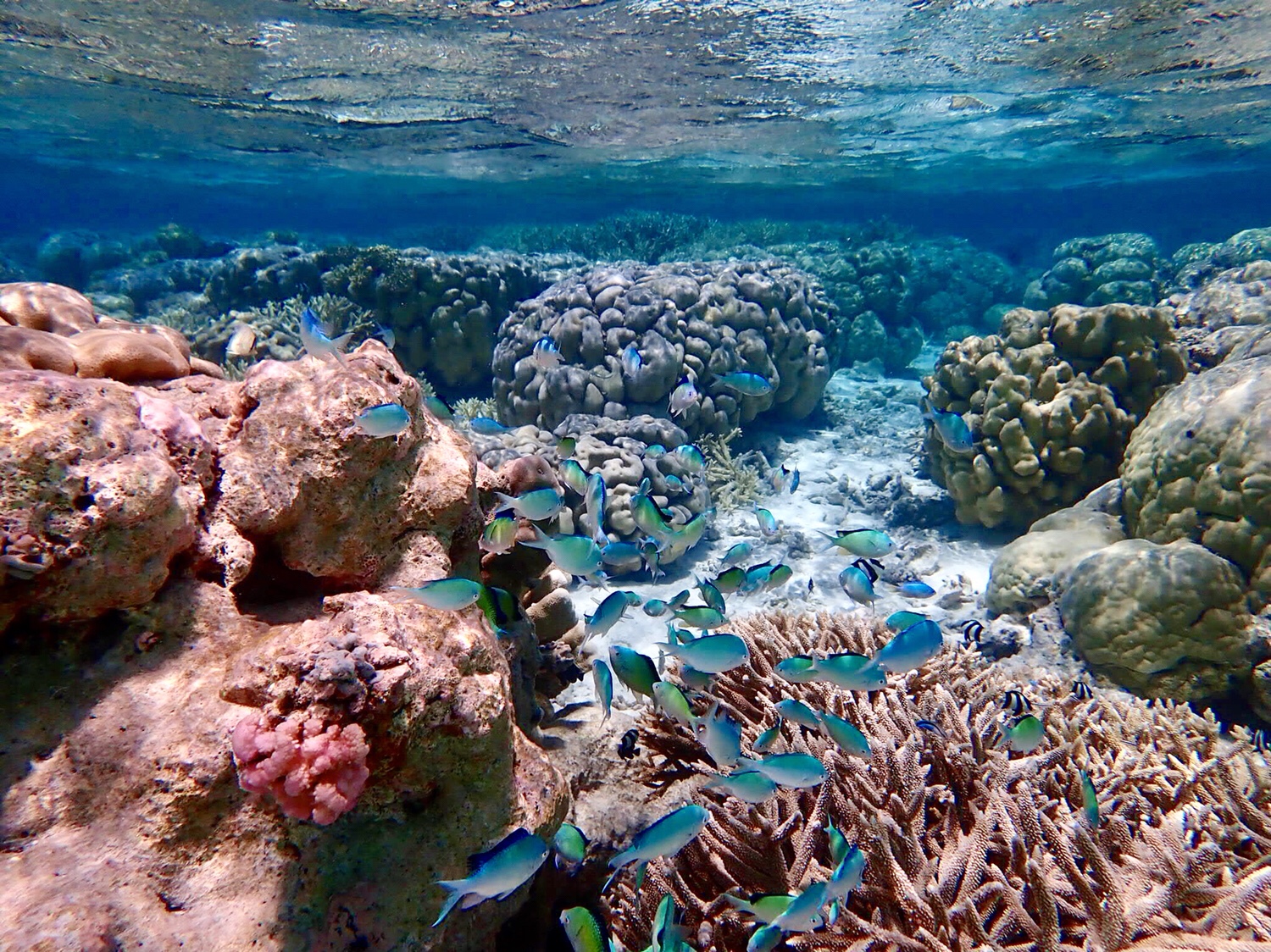 Coral garden Cocos Keeling
Coral garden Cocos Keeling The anchorage off Direction Island
The anchorage off Direction Island Connecting with the rest of the world
Connecting with the rest of the world Inhabitants of the Rip
Inhabitants of the Rip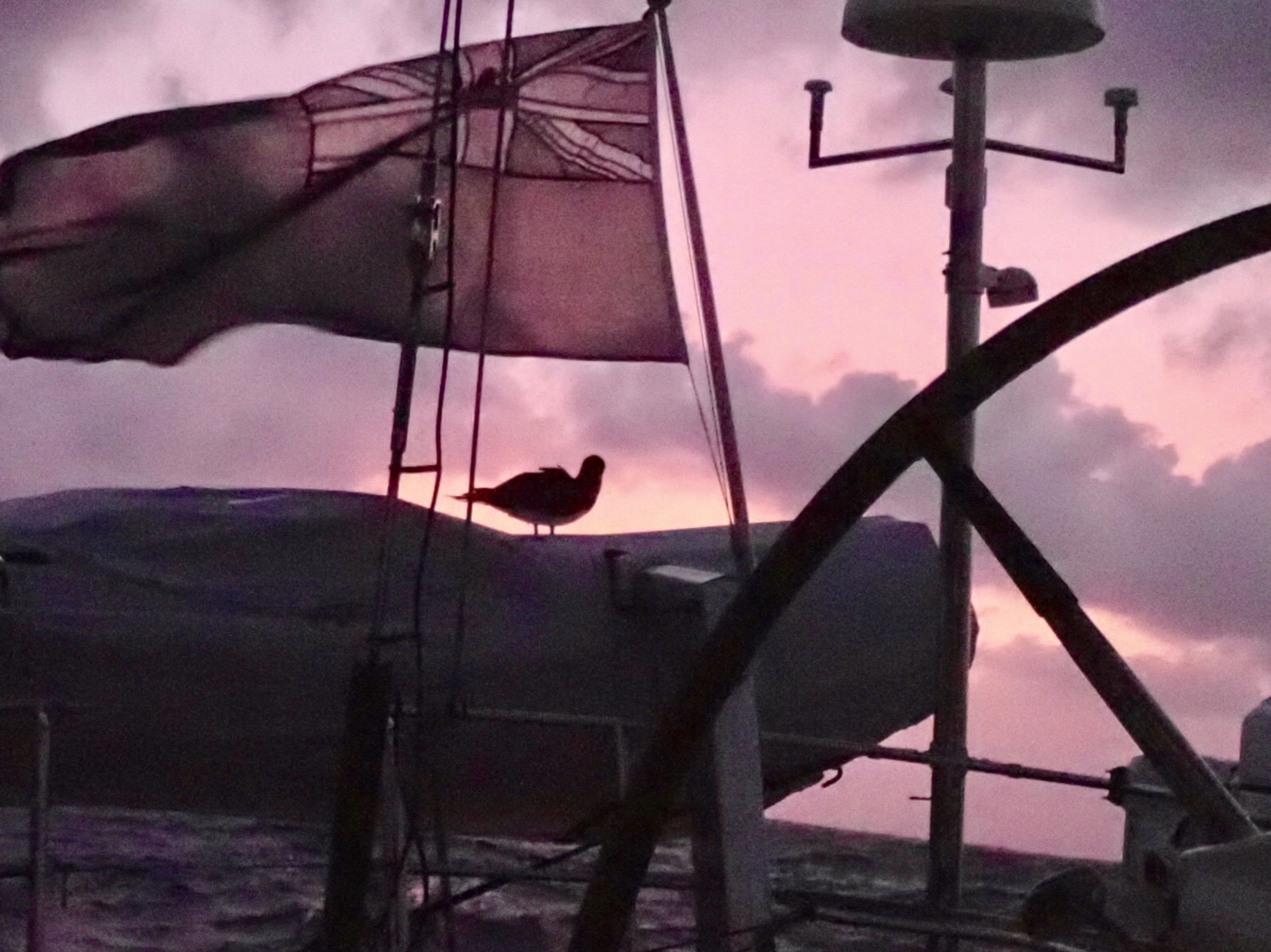 Masked Bobbie resting on the dingy
Masked Bobbie resting on the dingy The captain clinging on while he catches up on some sleep
The captain clinging on while he catches up on some sleep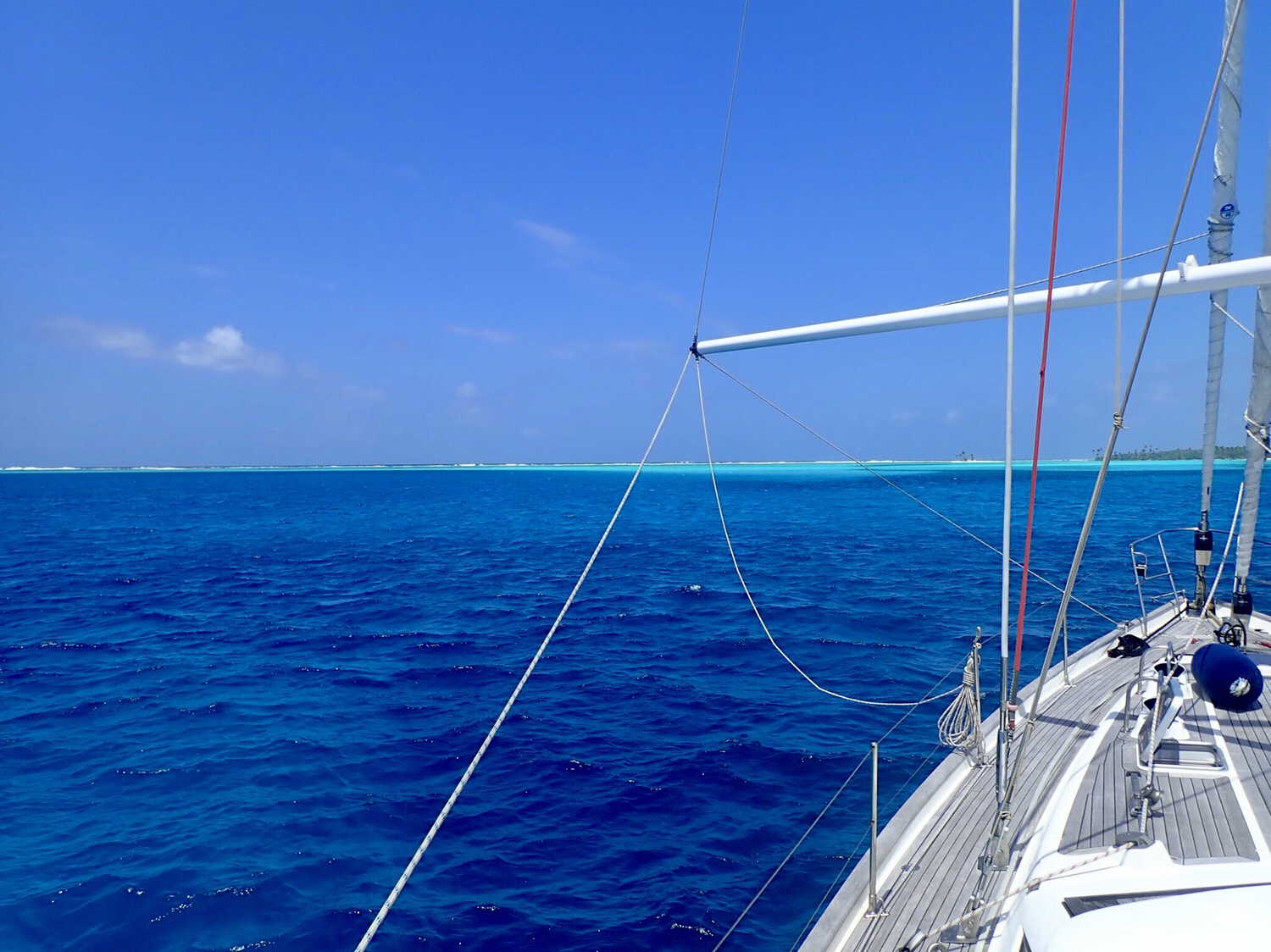 Motoring in to the lagoon off Direction Island
Motoring in to the lagoon off Direction Island Raya and 20 World ARC yachts.
Raya and 20 World ARC yachts. Farm buildings for cattle and goats
Farm buildings for cattle and goats Schools out, half days on Saturday
Schools out, half days on Saturday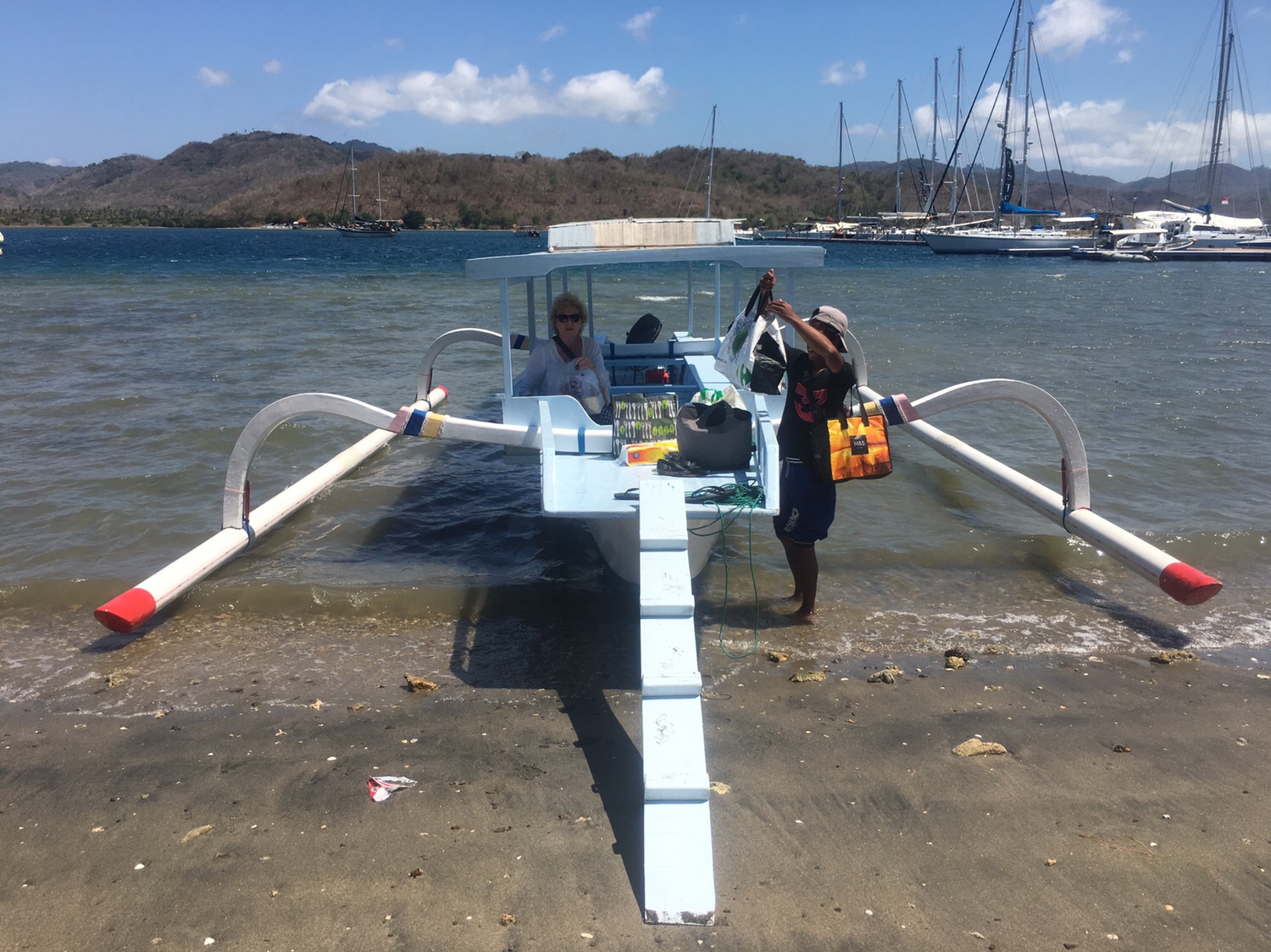 Water taxi delivered us and our shopping back to the marina
Water taxi delivered us and our shopping back to the marina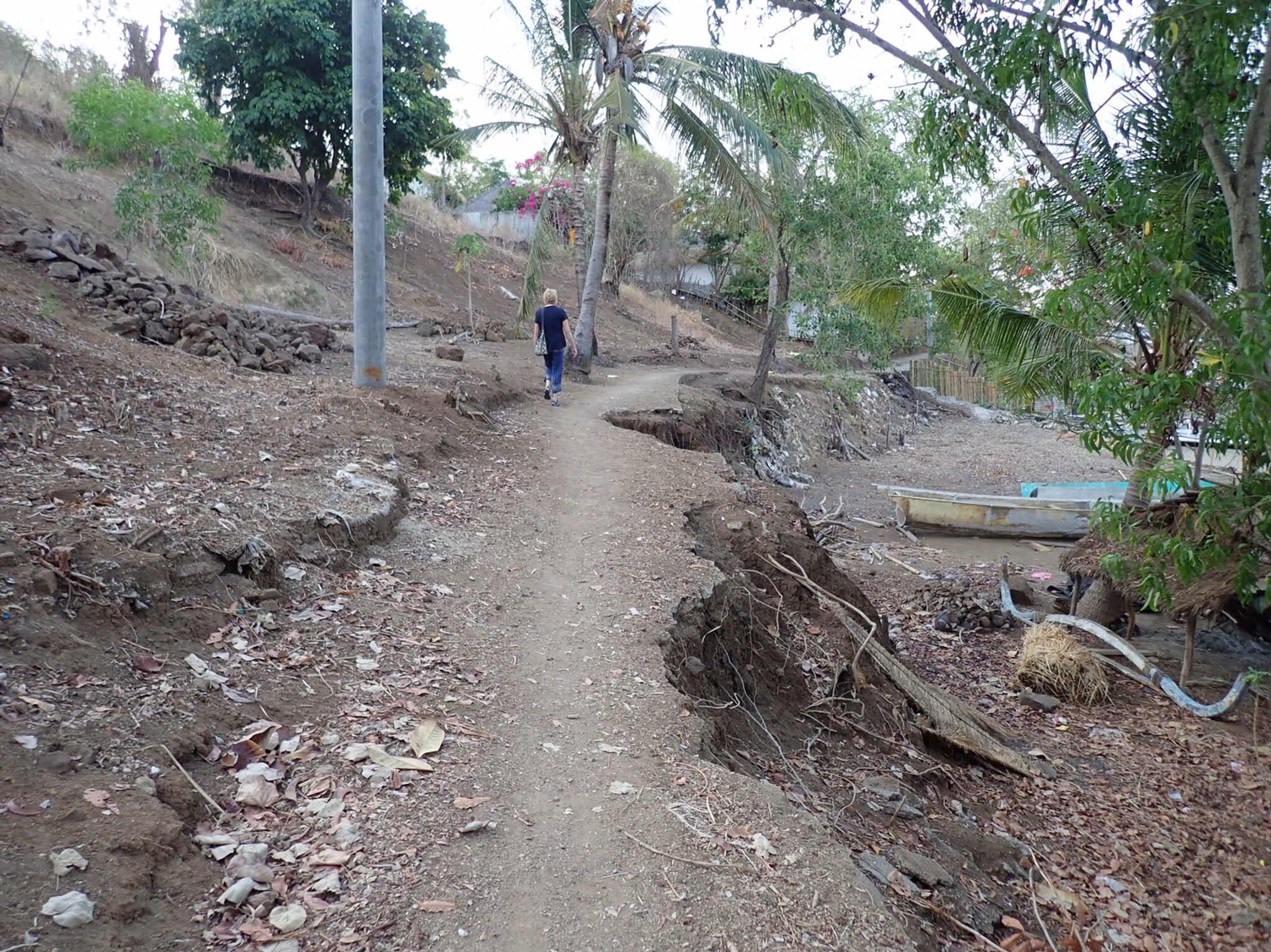 Crumbling path to the restaurant
Crumbling path to the restaurant pBrightly painted wooden boats sit underneath the volcanoes on the dark black sand
pBrightly painted wooden boats sit underneath the volcanoes on the dark black sand Gunung Sangeang
Gunung Sangeang Traditional boat being built in Wera
Traditional boat being built in Wera Raya anchored in the calm of Potapaddu Bay
Raya anchored in the calm of Potapaddu Bay Heaven Beach, Ekas, Lombok
Heaven Beach, Ekas, Lombok Male Komodo dragons collected around the Rangers housing
Male Komodo dragons collected around the Rangers housing Tourist boats fill every available space
Tourist boats fill every available space Penny and Stephen on the parched hills of Rinca Island
Penny and Stephen on the parched hills of Rinca Island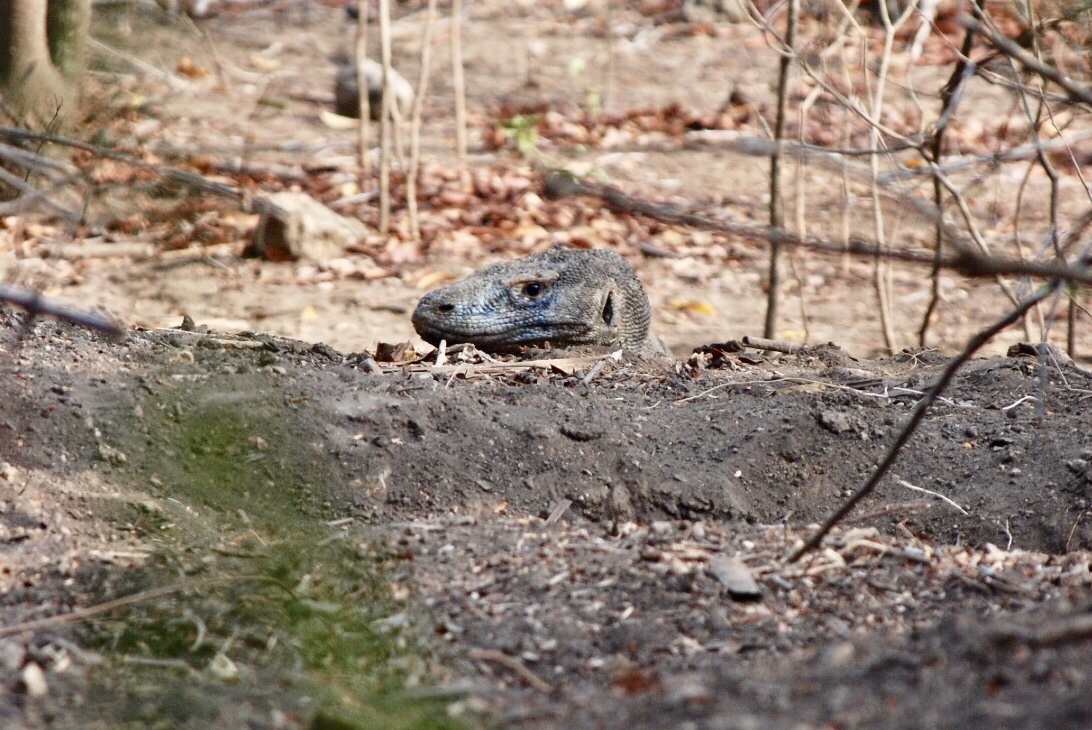 Female dragon guarding her nest
Female dragon guarding her nest Coral gardens off Banta aisland
Coral gardens off Banta aisland Traditional style phinisi awaiting the next group of tourists.
Traditional style phinisi awaiting the next group of tourists. Raya anchored in Wae Cicu Bay
Raya anchored in Wae Cicu Bay Downtown Labuan Bajo
Downtown Labuan Bajo An unwelcome and determined visitor
An unwelcome and determined visitor Balancing precariously, replacing the rusting SSB aerial connector
Balancing precariously, replacing the rusting SSB aerial connector 6ft high bamboo FAD
6ft high bamboo FAD The kids from Bari Village loved the caps we gave them
The kids from Bari Village loved the caps we gave them Anchored off Gili Bodo
Anchored off Gili Bodo Flames spreading across the hill side
Flames spreading across the hill side Colourful feather stars
Colourful feather stars The edge of the reef – Hoga Island
The edge of the reef – Hoga Island Innards of the windlass motor and gearbox
Innards of the windlass motor and gearbox Not the most comfortable place to work
Not the most comfortable place to work The edge of the reef clearly visible
The edge of the reef clearly visible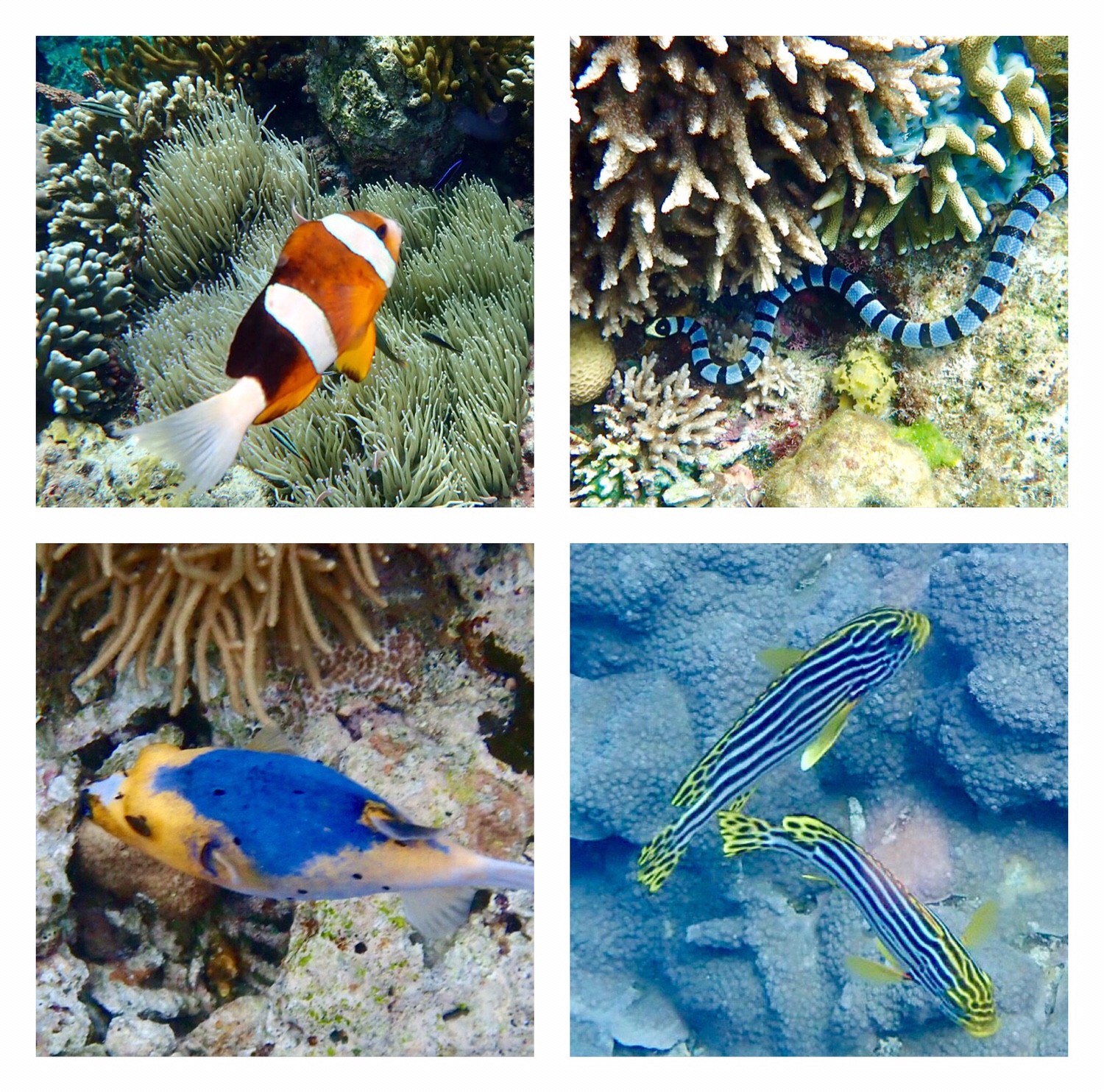 A clown fish, the sea snake, a colourful puffer and two sweet lips.
A clown fish, the sea snake, a colourful puffer and two sweet lips. Api volcano dominates the view
Api volcano dominates the view Not a normal dingy dock, we are having to use this old cannon as a cleat.
Not a normal dingy dock, we are having to use this old cannon as a cleat. Fruits of the forest, a cut nutmeg fruit with an almond on the side
Fruits of the forest, a cut nutmeg fruit with an almond on the side Ancient almond trees cast shade over the nutmeg forest.
Ancient almond trees cast shade over the nutmeg forest. One for the dodgy dock collection
One for the dodgy dock collection
 Selaya Fishing Village
Selaya Fishing Village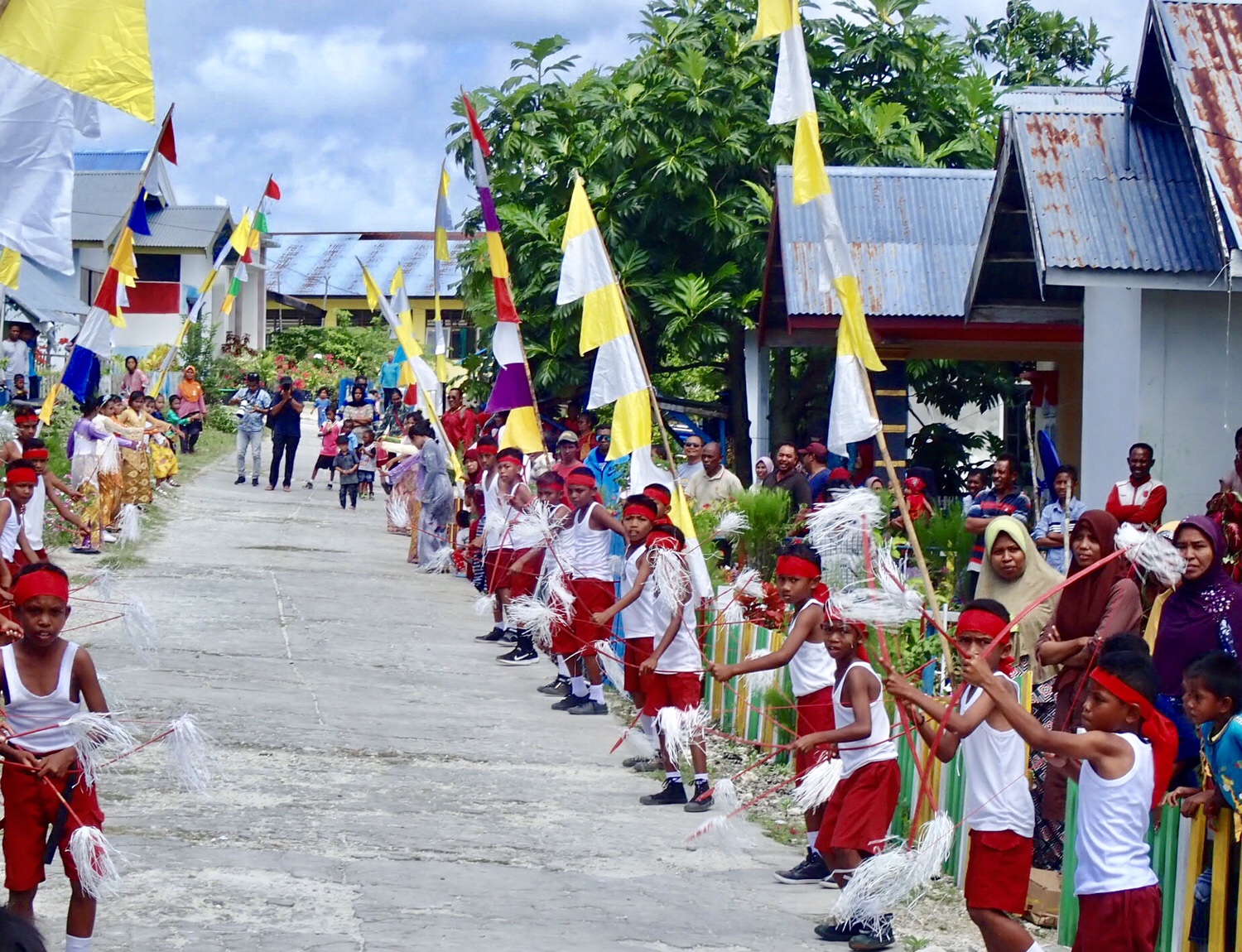 A right royal welcome to Selaya
A right royal welcome to Selaya An evening of entertainment at Wab Nagufur Beach
An evening of entertainment at Wab Nagufur Beach Hundreds of smiling faces
Hundreds of smiling faces Colourful beneath the water as above
Colourful beneath the water as above Traditional dug out canoe.
Traditional dug out canoe. Bamboo and wood fishing rig tied up in Debut
Bamboo and wood fishing rig tied up in Debut Fishing boat city
Fishing boat city Quarantine offers arriving by long boat
Quarantine offers arriving by long boat Main street down to the wharf at Debut
Main street down to the wharf at Debut Loved this local wooden boat in construction at the bottom of the garden.
Loved this local wooden boat in construction at the bottom of the garden. You can find our track at
You can find our track at  Getting the shopping into the dingy was a bit of a challenge for us and the guys on Alexandra.
Getting the shopping into the dingy was a bit of a challenge for us and the guys on Alexandra. Anchored in splendid isolation in Blackwood Bay, Adolphus Island
Anchored in splendid isolation in Blackwood Bay, Adolphus Island Anchored with the rally fleet off Horn Island
Anchored with the rally fleet off Horn Island Harry the local croc lounging on the banks of the anchorage
Harry the local croc lounging on the banks of the anchorage Flinders Islands
Flinders Islands Downwind sail rig whisking us at 8kts northwards
Downwind sail rig whisking us at 8kts northwards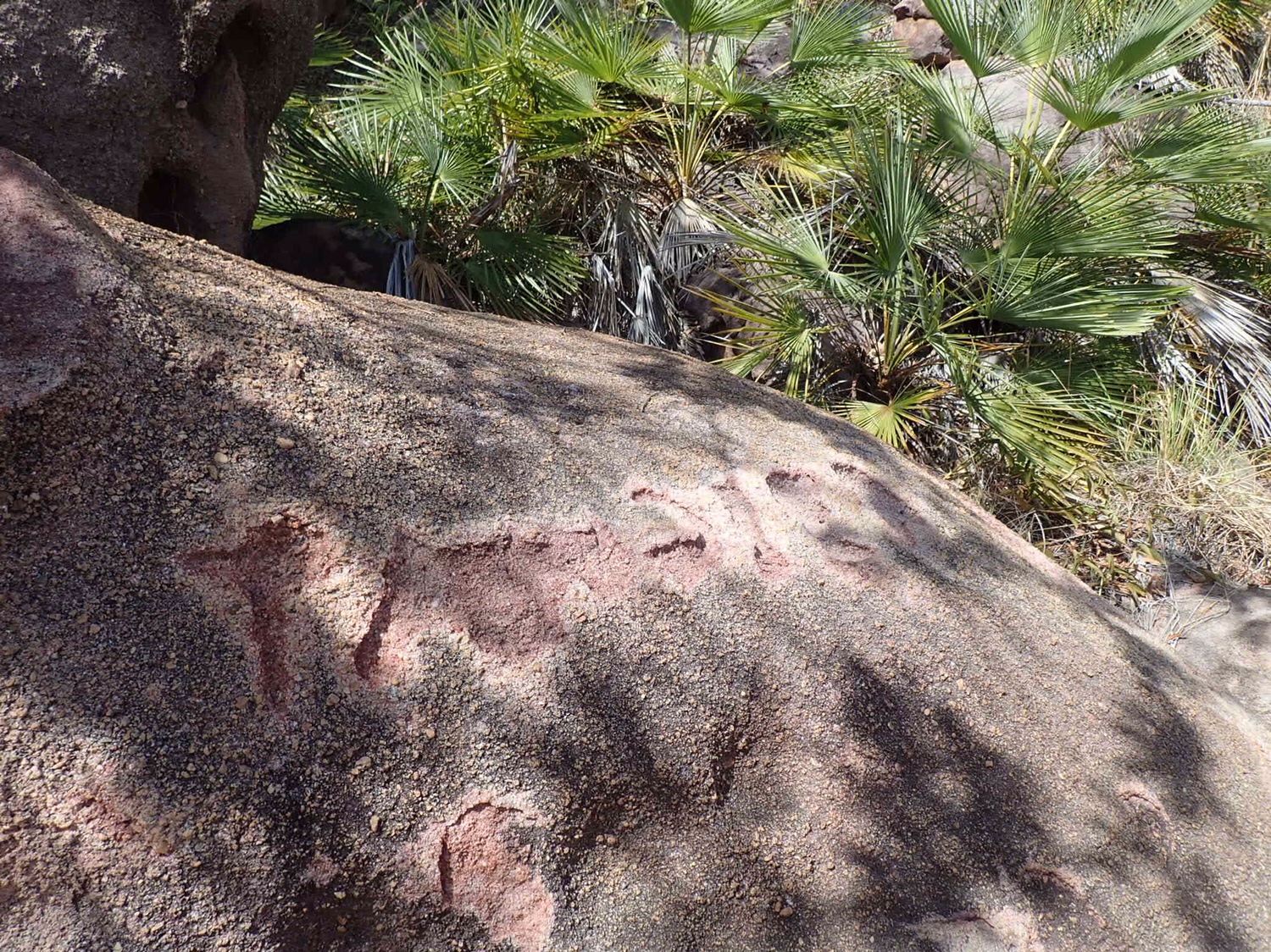 200 yr old graffiti, no luck deciphering it however
200 yr old graffiti, no luck deciphering it however Graffiti walk on Flinders Island
Graffiti walk on Flinders Island Beautiful flowering trees
Beautiful flowering trees Pelicans on a rainy Cairns beach
Pelicans on a rainy Cairns beach Mossman River
Mossman River At 4 1/2 m Scarface is possibly the largest Salty on the river
At 4 1/2 m Scarface is possibly the largest Salty on the river Aerial roots of the Mangrove trees
Aerial roots of the Mangrove trees A rather damp and ruffled giant billed heron
A rather damp and ruffled giant billed heron
 Looking back at the mainland from Orpheus Island.
Looking back at the mainland from Orpheus Island. Warming up in the sunshine as we continue to sail north
Warming up in the sunshine as we continue to sail north Street art in the rain, at the Lagoon on the Cairns waterfront
Street art in the rain, at the Lagoon on the Cairns waterfront Oyster World Rally arrive in Cairns
Oyster World Rally arrive in Cairns Splendid Isolation of Bona Bay
Splendid Isolation of Bona Bay Windless days and glassy seas
Windless days and glassy seas Pebble beach at Bona Bay
Pebble beach at Bona Bay A small creek entering Shark Bay
A small creek entering Shark Bay Enjoying the calm waters, exploring in the dingy.
Enjoying the calm waters, exploring in the dingy. A trail to nowhere
A trail to nowhere Super Yacht Felix , they had been polishing the hull all day
Super Yacht Felix , they had been polishing the hull all day The rocks at Stonehaven Beach
The rocks at Stonehaven Beach Our next stop was, for contrast, deep inside the 2.5nm long Nara inlet, at only half a km wide we were encased by the high green hills.We couldn’t have wanted for a more tranquil spot, in fact Rick took advantage of the calm conditions, and the extra hands onboard, to drop the main sail and inspect the inmast furler.
Our next stop was, for contrast, deep inside the 2.5nm long Nara inlet, at only half a km wide we were encased by the high green hills.We couldn’t have wanted for a more tranquil spot, in fact Rick took advantage of the calm conditions, and the extra hands onboard, to drop the main sail and inspect the inmast furler. Looking down the length of Nara Inlet
Looking down the length of Nara Inlet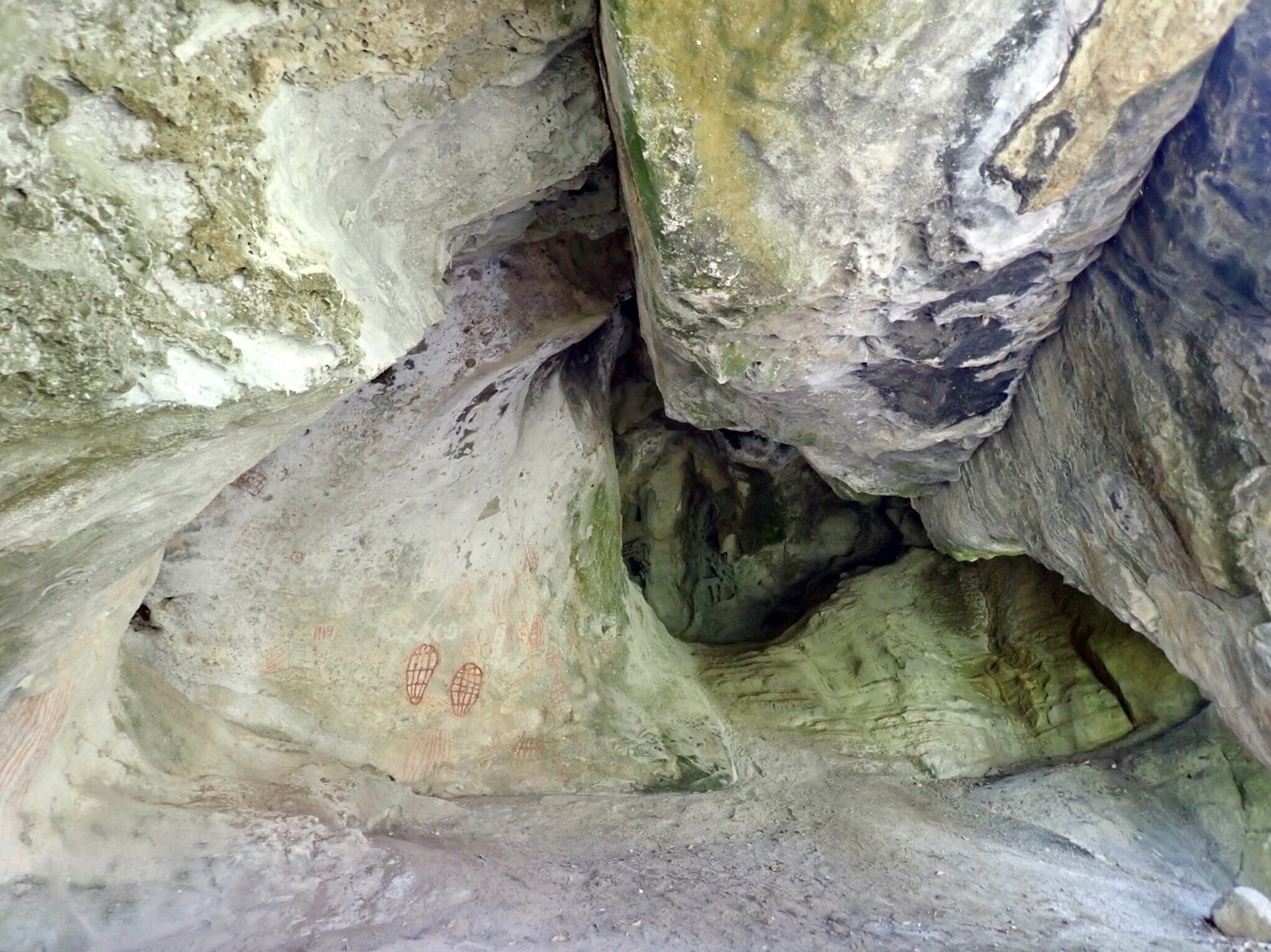 Aboriginal cave paintings in Nara Inlet.
Aboriginal cave paintings in Nara Inlet. Fossicking on Cateran Beach
Fossicking on Cateran Beach Fossicking Prizes
Fossicking Prizes Clambering on the rocks in Butterfly Bay
Clambering on the rocks in Butterfly Bay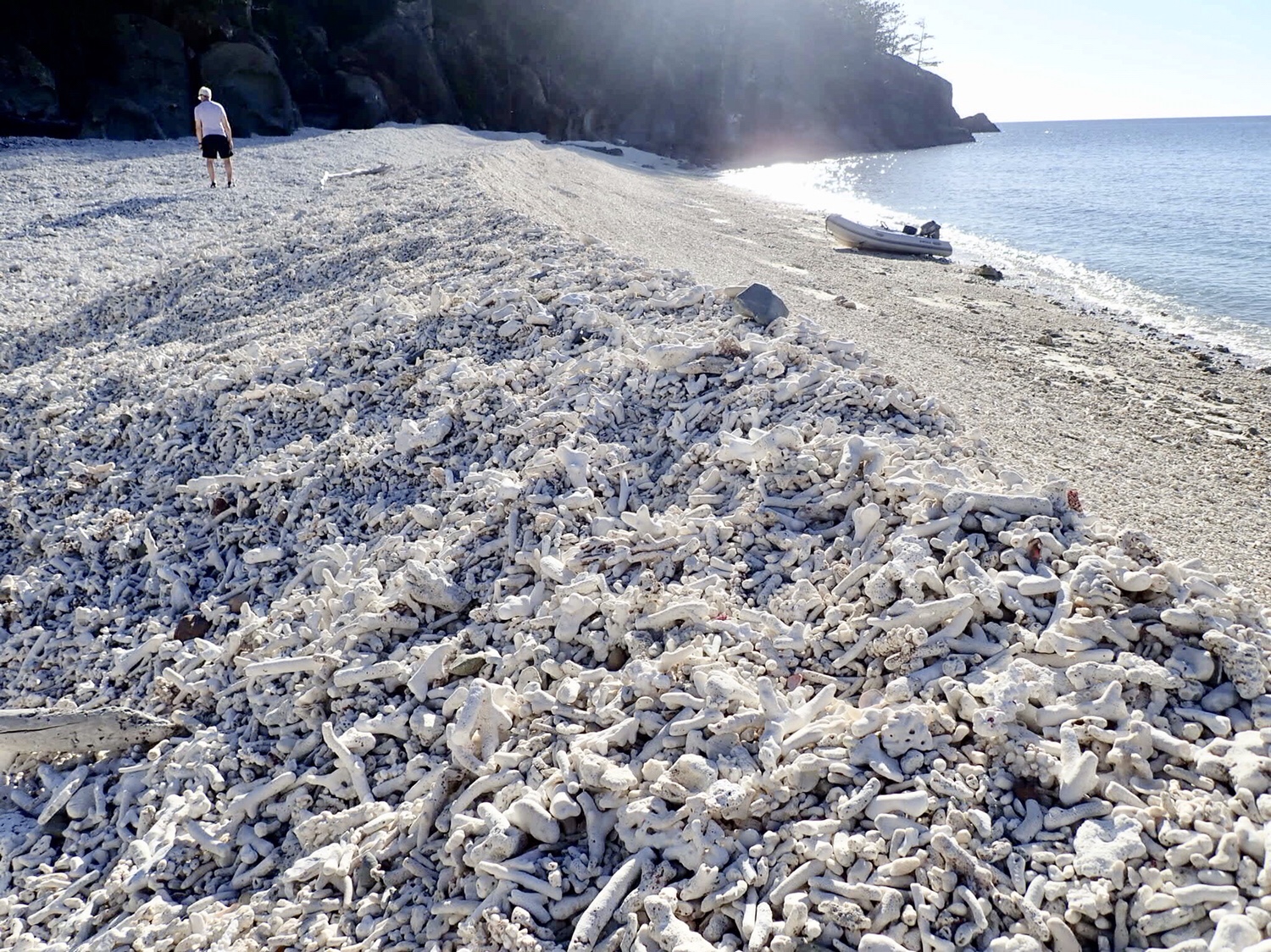 Beach at Luncheon Bay buried under tons of coral fragments.
Beach at Luncheon Bay buried under tons of coral fragments. Large bat fish in Luncheon Bay
Large bat fish in Luncheon Bay Roz admiring the view
Roz admiring the view Five miles of white sand on Whitehaven Beach
Five miles of white sand on Whitehaven Beach Piles of dead trees lined the top of the beach
Piles of dead trees lined the top of the beach Anchored in Cateran Bay, Border Island
Anchored in Cateran Bay, Border Island Anchor down in calm Sawmill Bay, Cid Harbour
Anchor down in calm Sawmill Bay, Cid Harbour Beautiful Cid Harbour
Beautiful Cid Harbour Bright orange fungi grow on the wood that litters the forest floor.
Bright orange fungi grow on the wood that litters the forest floor. Main pool at Hamilton Island Resort
Main pool at Hamilton Island Resort Cold wet arrival in the Whitsundays.
Cold wet arrival in the Whitsundays. Derelict Bampton Island Resort
Derelict Bampton Island Resort Kangeroo watching our every move
Kangeroo watching our every move A ray of sunshine creeps through the clouds highlighting Yellow Rock off Shaw Island
A ray of sunshine creeps through the clouds highlighting Yellow Rock off Shaw Island Every inch of Percy Island Yacht Club is covered in mementos from passing yachts.
Every inch of Percy Island Yacht Club is covered in mementos from passing yachts. Marking our stay in West Bay
Marking our stay in West Bay Homestead transport hidden within the protection of the West Bay Lagoon.
Homestead transport hidden within the protection of the West Bay Lagoon. Giant Golden Orb spider
Giant Golden Orb spider Pontoon ramp at low tide
Pontoon ramp at low tide Light blue soldier crab
Light blue soldier crab Rock climbing Second Beach, Keppel Island
Rock climbing Second Beach, Keppel Island A complete rainbow arched across the creek
A complete rainbow arched across the creek Sand banks Island Head Creek
Sand banks Island Head Creek Armies of light blue soldier crabs marching up the beach
Armies of light blue soldier crabs marching up the beach Looking out from Double Head across the marina to a Rosslyn Bay
Looking out from Double Head across the marina to a Rosslyn Bay Fan Rock
Fan Rock Deserted Kemp Beach
Deserted Kemp Beach Raya anchored in Lady Musgrave Lagoon
Raya anchored in Lady Musgrave Lagoon Fishcakes for supper for the next three weeks.
Fishcakes for supper for the next three weeks.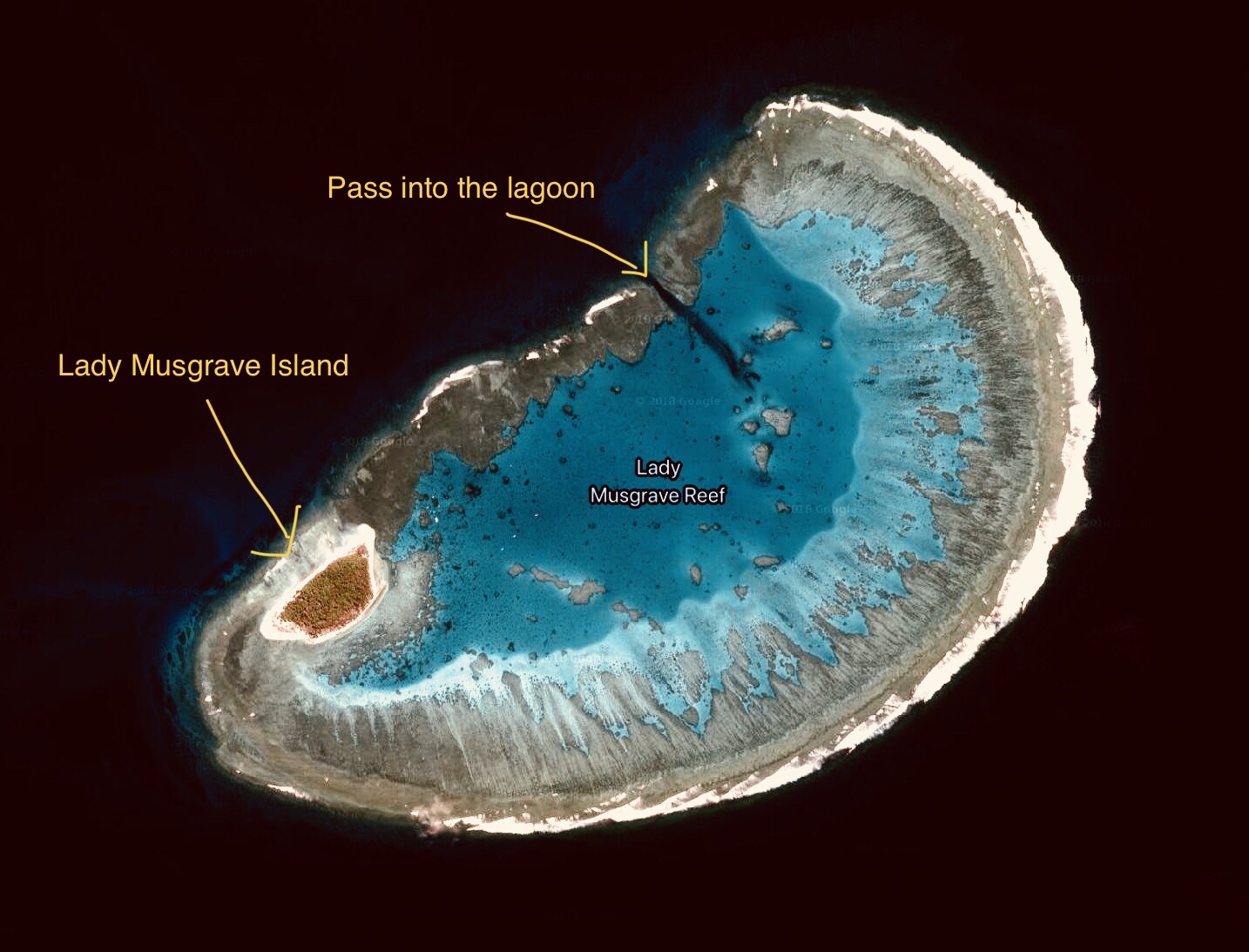 Lady Musgrave Reef on Google Earth, a jewel in the dark ocean
Lady Musgrave Reef on Google Earth, a jewel in the dark ocean Thousands of Black Noddies take to the air.
Thousands of Black Noddies take to the air. Even the tiny Damsel Fish added to the days turquoise colour scheme.
Even the tiny Damsel Fish added to the days turquoise colour scheme. Dramatic Bundaberg skies
Dramatic Bundaberg skies Paddling at Elliots Heads
Paddling at Elliots Heads
 That looks a bit better.
That looks a bit better.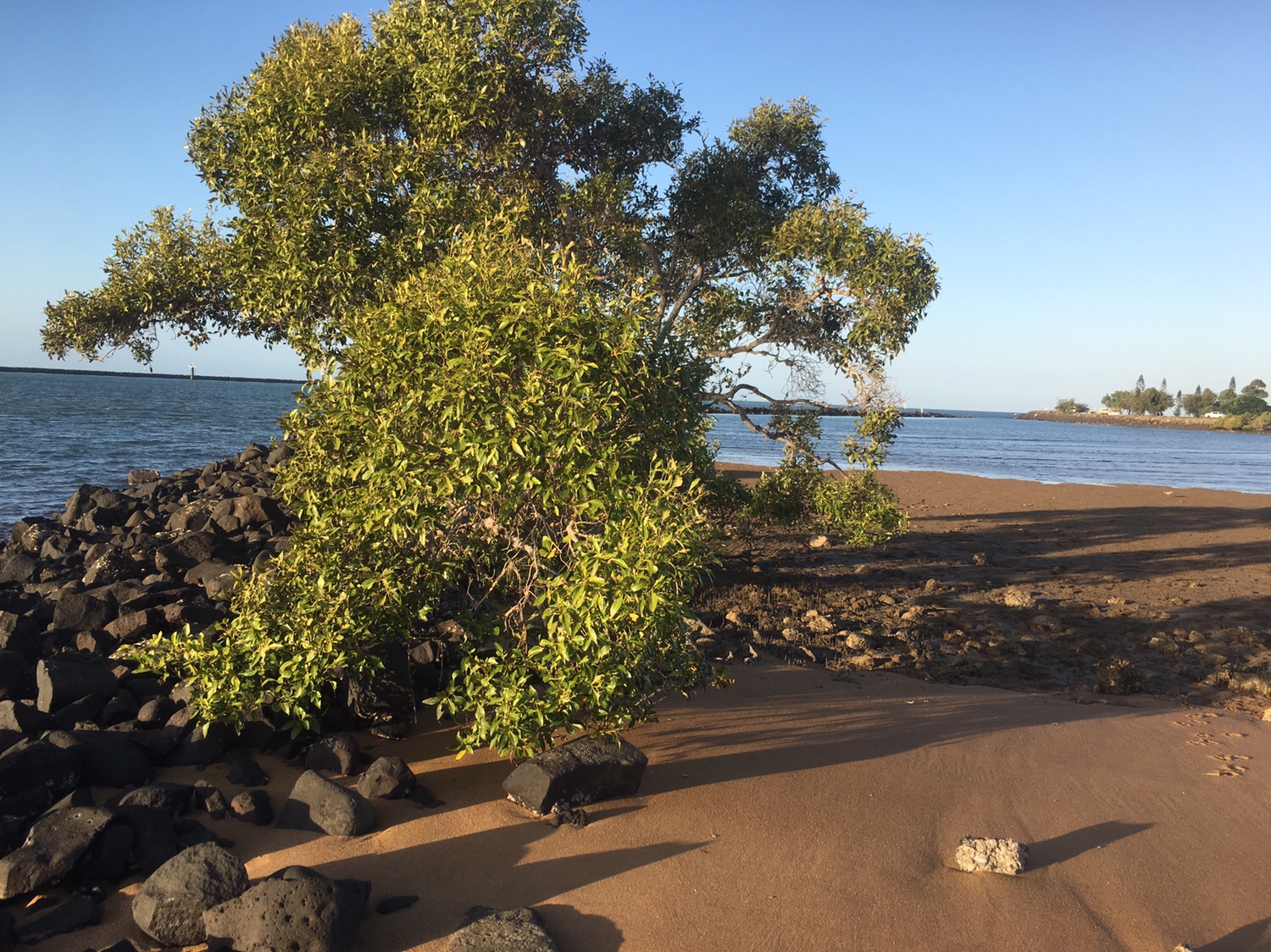 Dark beach at the mouth of the Burnett River
Dark beach at the mouth of the Burnett River A flock of Pelicans always remind us of pterodactyls.
A flock of Pelicans always remind us of pterodactyls. Still at last, lovely sunrise over Bundaberg marina
Still at last, lovely sunrise over Bundaberg marina It felt like a long trek north around Fraser Island
It felt like a long trek north around Fraser Island Freezer cold – hooray
Freezer cold – hooray Last weeks forecast for the Whitsunday Islands five hundred miles to our north
Last weeks forecast for the Whitsunday Islands five hundred miles to our north The beach at South Stradbroke Island with the Gold Coast high rises in the distance.
The beach at South Stradbroke Island with the Gold Coast high rises in the distance.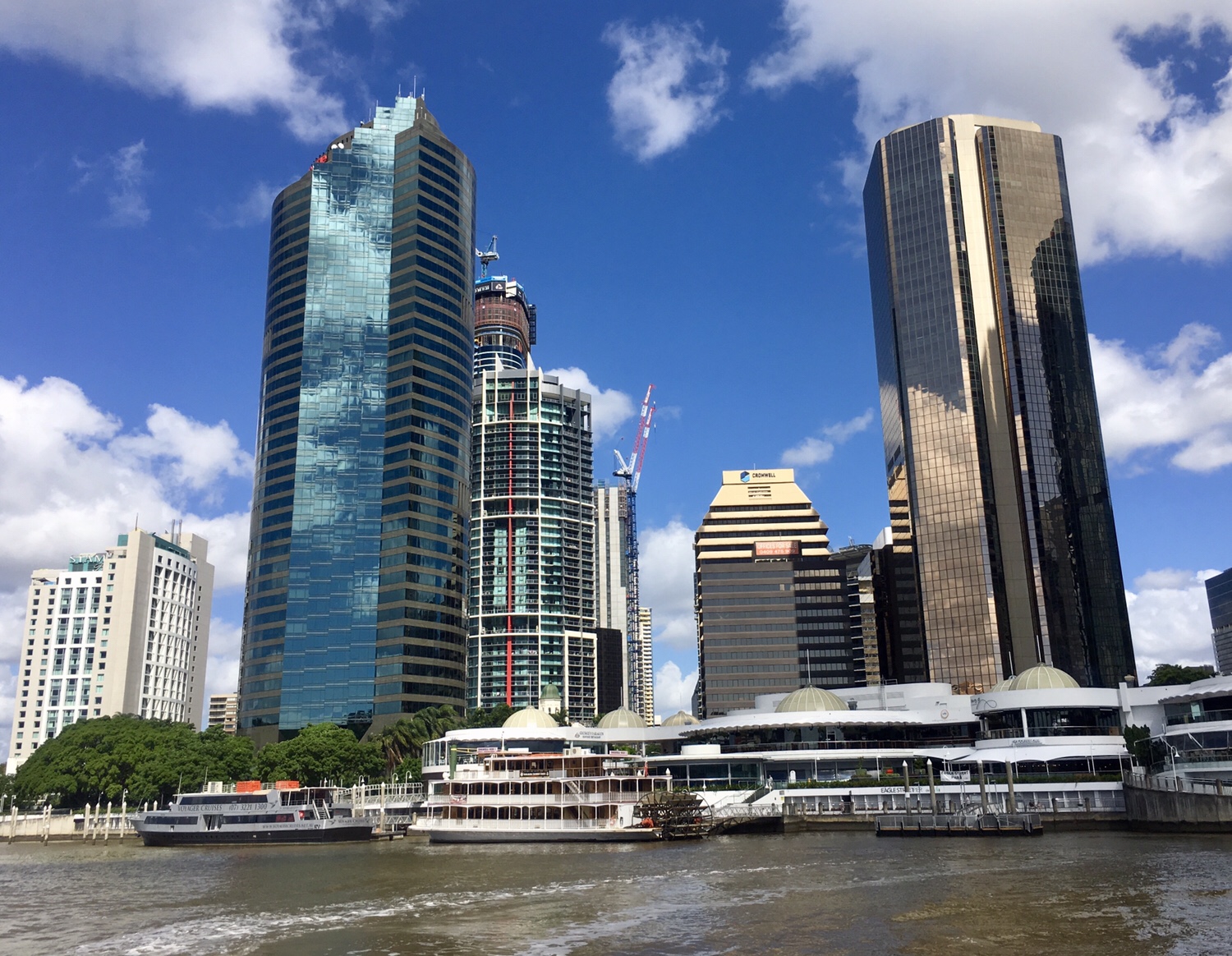 Brisbane ferries and Highrises.
Brisbane ferries and Highrises. Mad motor boat drivers coming from all directionsi
Mad motor boat drivers coming from all directionsi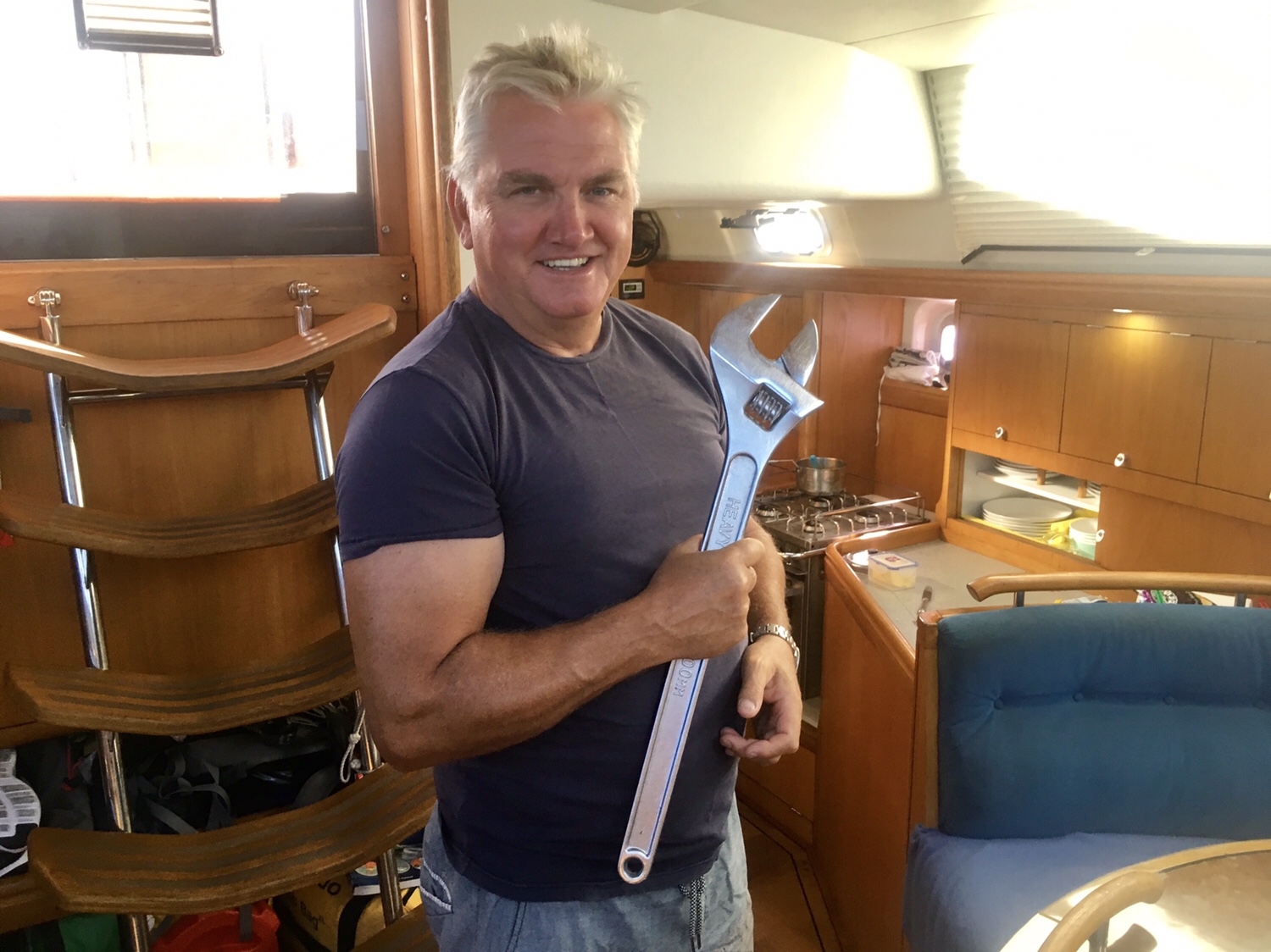 Ricks new spanner
Ricks new spanner Dinner with old friends
Dinner with old friends Motoring down the Coomera River in the torrential rain.
Motoring down the Coomera River in the torrential rain. Ready to be lifted back onto the water
Ready to be lifted back onto the water Walking on Main Beach with Elaine and Roy from Paw Paw
Walking on Main Beach with Elaine and Roy from Paw Paw Dirty hull!
Dirty hull! Watching the life raft being checked
Watching the life raft being checked View of the harbour from the top of Mutton Island.
View of the harbour from the top of Mutton Island. Rick enjoying the view
Rick enjoying the view Miles of beaches run South from the harbour
Miles of beaches run South from the harbour Enjoying the tumbling surf
Enjoying the tumbling surf Newcastle city centre
Newcastle city centre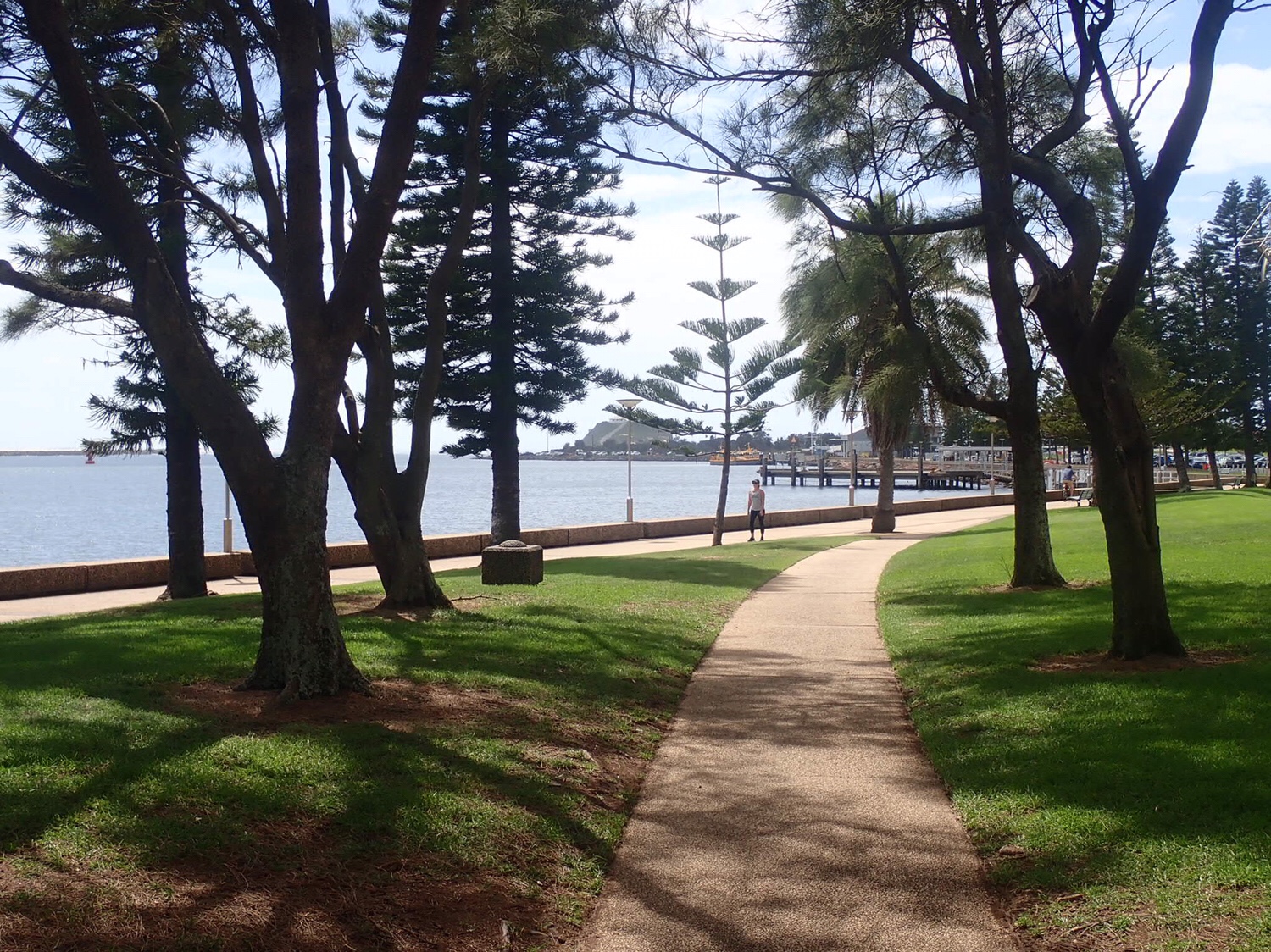 Foreshore walkway
Foreshore walkway
 Nobby’s Beach, Newcastle
Nobby’s Beach, Newcastle Sunsetting behind the big swell
Sunsetting behind the big swell Sayonara Sydney
Sayonara Sydney Jerusalem Bay, early morning calm
Jerusalem Bay, early morning calm Sheridan on the Great North Walk, in the Ku-ring-gai Chase National Park.
Sheridan on the Great North Walk, in the Ku-ring-gai Chase National Park. Nice to see the evening sunshine finally glinting off the tower blocks.
Nice to see the evening sunshine finally glinting off the tower blocks.

 Amazing street art in Fremantle
Amazing street art in Fremantle Peking Duck night
Peking Duck night Thanks Taryn and Greg for a great break
Thanks Taryn and Greg for a great break The stunning beach at Injidup
The stunning beach at Injidup Watching the kite surfers at Yallingup
Watching the kite surfers at Yallingup Taryn out on the edge of the Canal Rocks.
Taryn out on the edge of the Canal Rocks. Taryn and Rick enjoying the natural spa bath
Taryn and Rick enjoying the natural spa bath Boranup Forest
Boranup Forest The Smiths at Smith Beach
The Smiths at Smith Beach City Beach, Perth
City Beach, Perth Trees in the Botanical Gardens in Kings Park, Perth
Trees in the Botanical Gardens in Kings Park, Perth Kangaroos in Pinnaroo Park
Kangaroos in Pinnaroo Park Fixing a fuel leak on the generator
Fixing a fuel leak on the generator Pillars of rock known as the Three Sisters
Pillars of rock known as the Three Sisters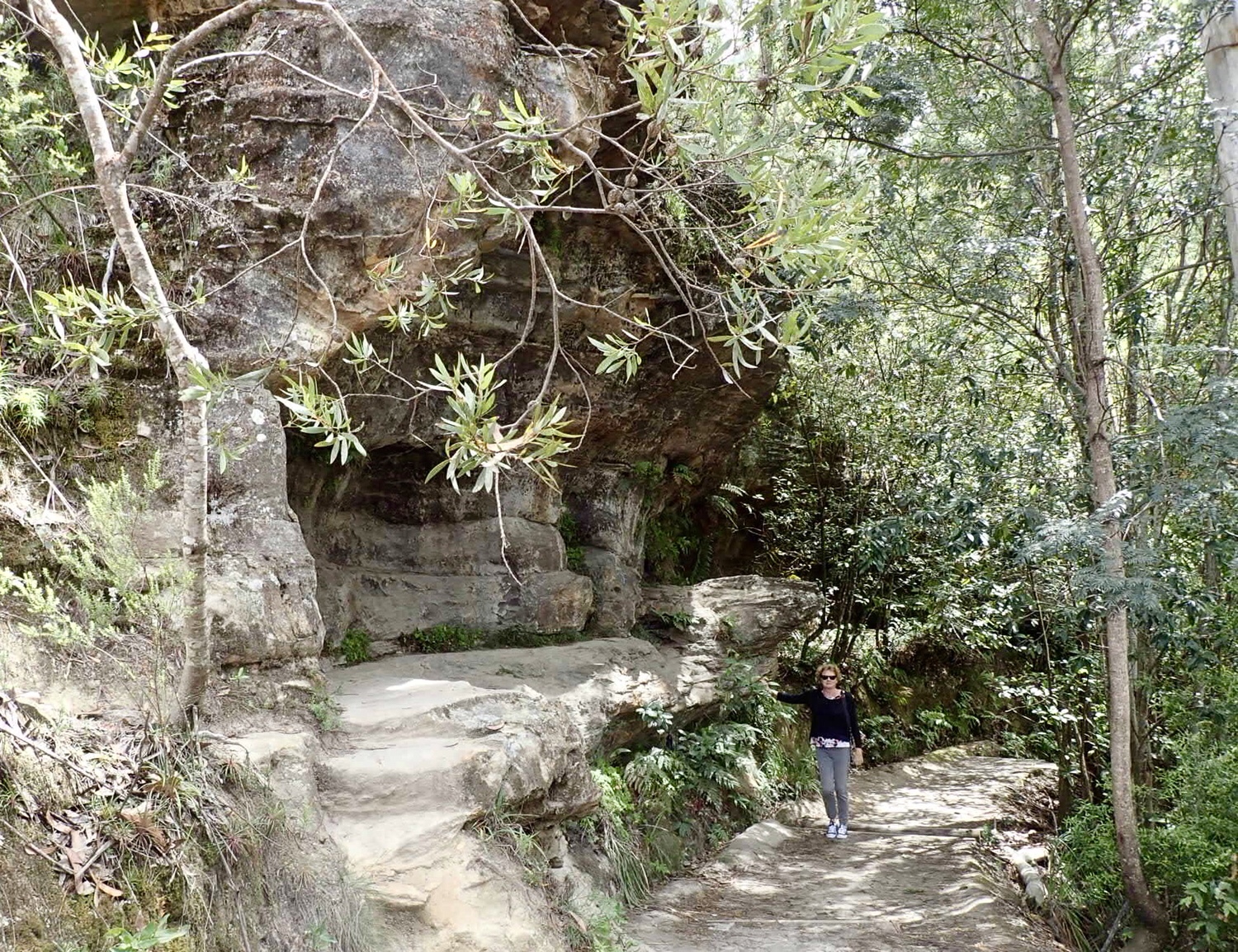 Walking along the Prince Henry Cliff
Walking along the Prince Henry Cliff Wonderful tops of the tree ferns
Wonderful tops of the tree ferns Servicing the primary winch motor
Servicing the primary winch motor Spring Cove Saturday afternoon.
Spring Cove Saturday afternoon. Huge fig tree in the Royal botanical gardens
Huge fig tree in the Royal botanical gardens Green wall in The Calyx
Green wall in The Calyx Well done Rick, operation rescue camera completed successfully.
Well done Rick, operation rescue camera completed successfully. The Endeavour moored in Darling Harbour.
The Endeavour moored in Darling Harbour. We love the Push-me Pull-you ferries that run every half an hour between Manly and Central quay in the city.
We love the Push-me Pull-you ferries that run every half an hour between Manly and Central quay in the city. Anchored off Store Beach
Anchored off Store Beach Passing through Spit Bridge
Passing through Spit Bridge Pied Cormorant sunning himself
Pied Cormorant sunning himself Pretty boat house in Powder Hulk Bay
Pretty boat house in Powder Hulk Bay Jelly fish swimming in the engine raw water filter!
Jelly fish swimming in the engine raw water filter! First dip for a while
First dip for a while Raked masts and protective awnings of the CYC racing fleet.
Raked masts and protective awnings of the CYC racing fleet.
 Ashley comes to tea
Ashley comes to tea
 Raya dressed with flags for New Years Eve
Raya dressed with flags for New Years Eve

 Good sports John and Deb wearing their cracker paper hats
Good sports John and Deb wearing their cracker paper hats Local favourite Wild Oats battling out through Sydney Heads
Local favourite Wild Oats battling out through Sydney Heads Spectator fleet
Spectator fleet Manly Beach
Manly Beach Our Current View for the fireworks, let’s keep our fingers crossed nothing too big comes in to block the view.
Our Current View for the fireworks, let’s keep our fingers crossed nothing too big comes in to block the view.
 The Opera House from the land.
The Opera House from the land.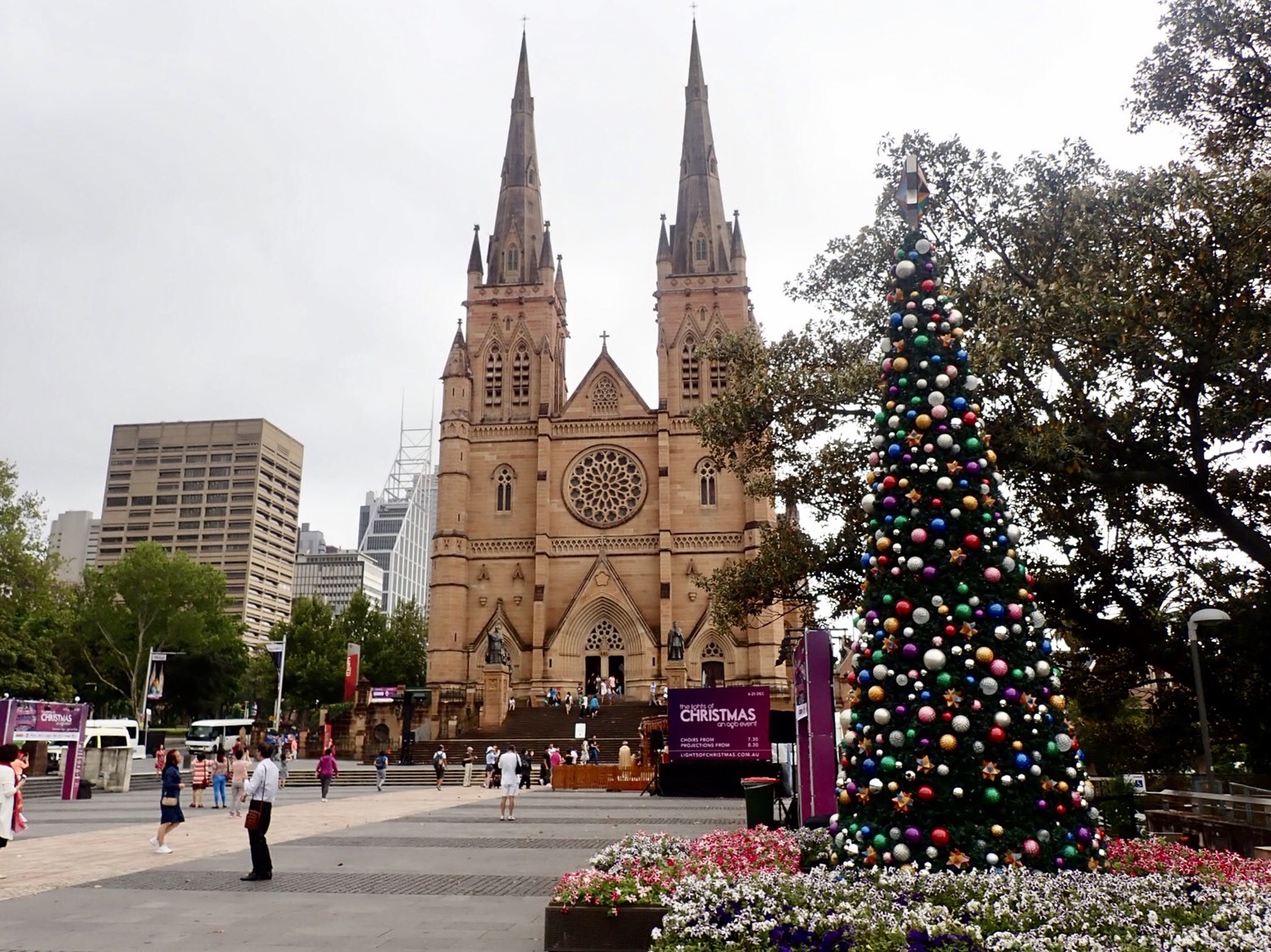 Sydney Cathedral with its modern backdrop and it’s Christmas tree surrounded by summer flowers.
Sydney Cathedral with its modern backdrop and it’s Christmas tree surrounded by summer flowers.
 First glimpse of the centre of Sydney
First glimpse of the centre of Sydney Celebratory “got here beer”
Celebratory “got here beer” Turneresque scene as the storm closes in
Turneresque scene as the storm closes in Raya anchored in Jerusalem Bay
Raya anchored in Jerusalem Bay Sea Eagle takes flight
Sea Eagle takes flight Raya from the top of the mast
Raya from the top of the mast Stormy weather
Stormy weather Jelly Fish the size of basket balls
Jelly Fish the size of basket balls

 A forest of masts fills our view south
A forest of masts fills our view south Foreshore in Careel Bay, Pittwater
Foreshore in Careel Bay, Pittwater
 Four knots of current as we sailed south down the Australian East Coast.
Four knots of current as we sailed south down the Australian East Coast.
 Pelican fishing around the back of the boat
Pelican fishing around the back of the boat Moonshadow bathed in the amazing light of the setting sun
Moonshadow bathed in the amazing light of the setting sun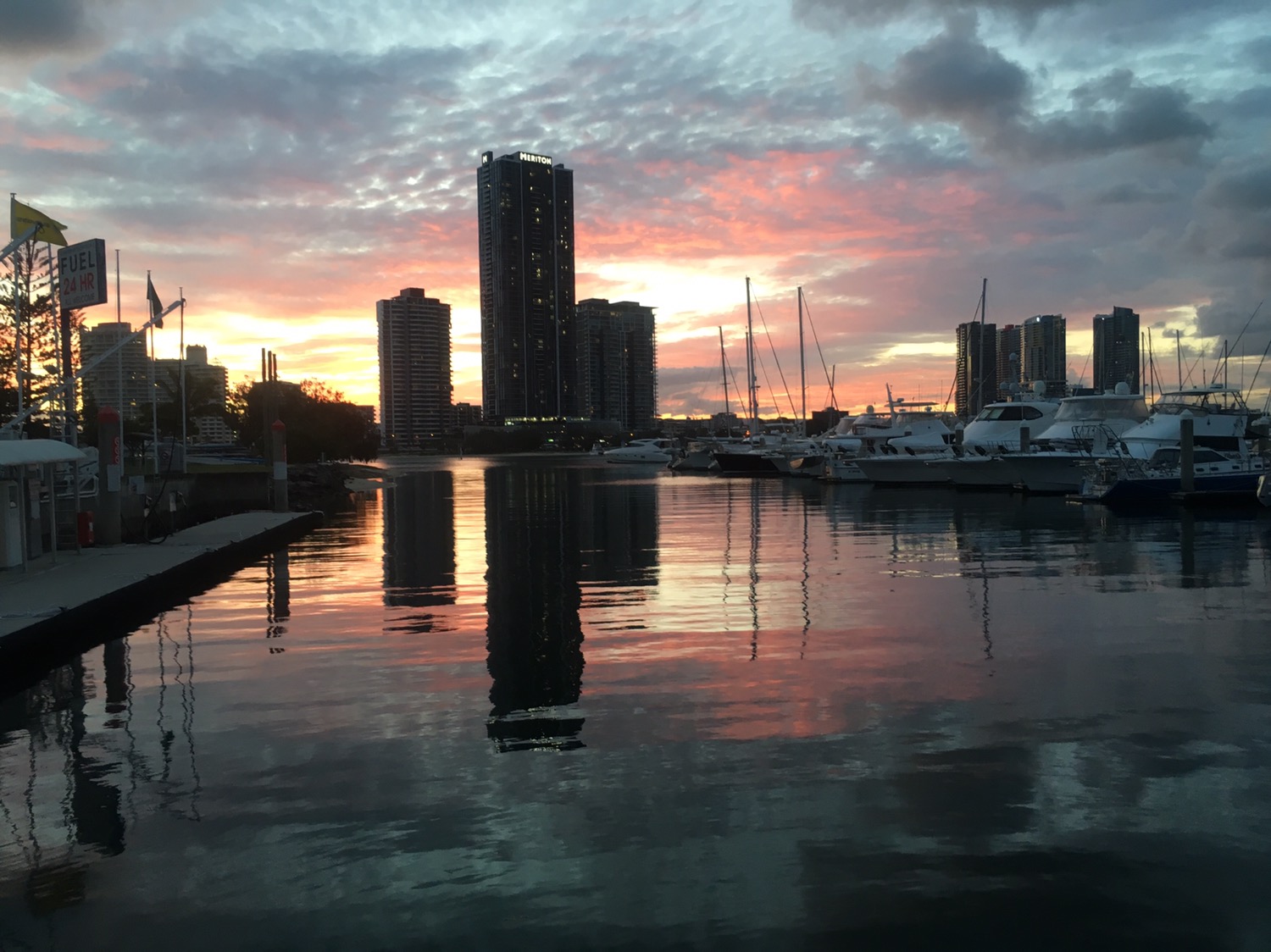 Sun setting behind the tower blocks
Sun setting behind the tower blocks Singing chefs
Singing chefs Manicured Streets behind Mainbeach
Manicured Streets behind Mainbeach Silent chef
Silent chef View towards Surfers Paradise
View towards Surfers Paradise View from the cockpit
View from the cockpit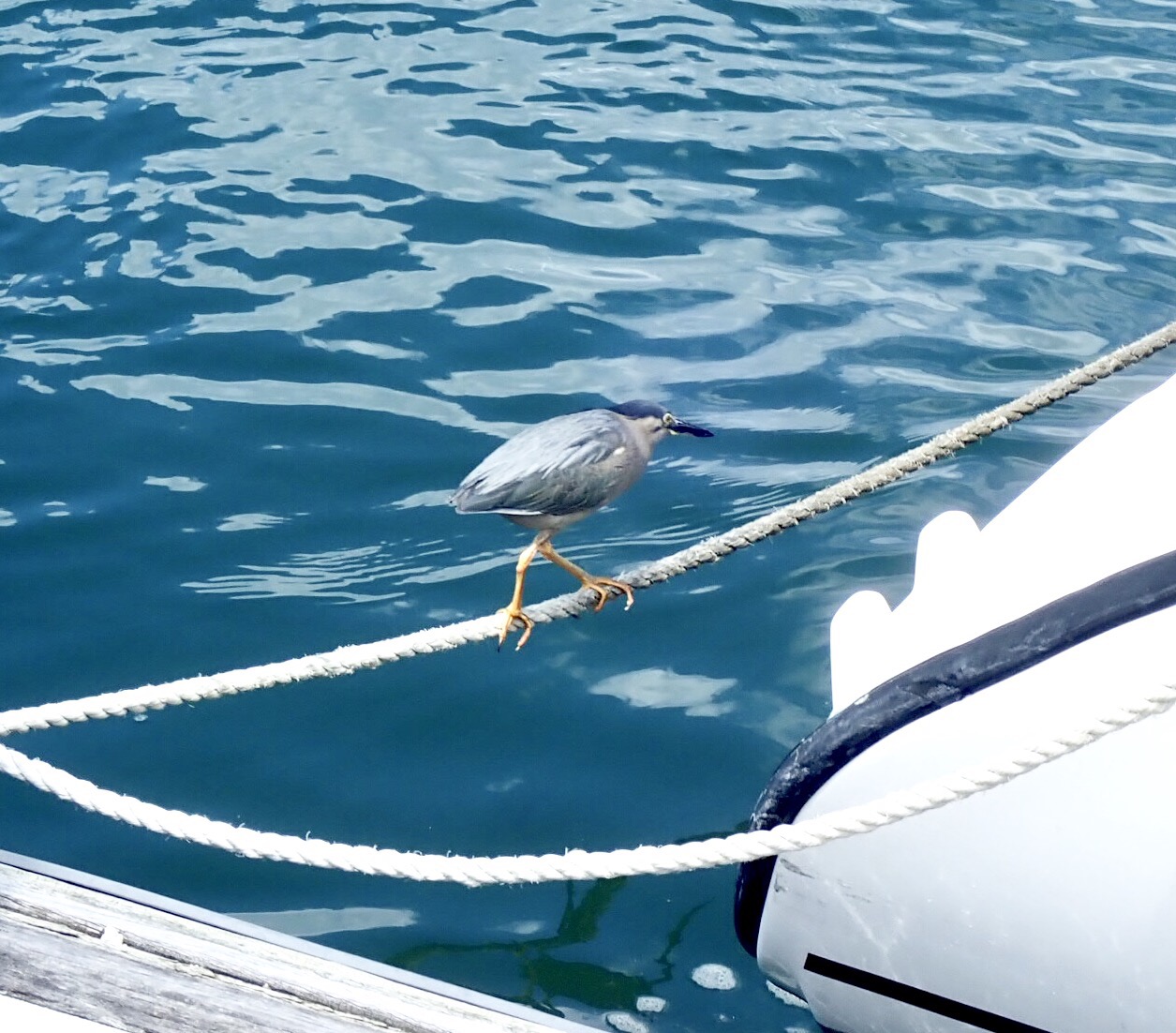 Tight rope walking
Tight rope walking Ibis in the park
Ibis in the park
 Tied up at the custom dock
Tied up at the custom dock Early Monday morning the log registered 20,000nm sailed
Early Monday morning the log registered 20,000nm sailed Whoops, I may have been a little over enthusiastic as I wiped down one of the water triggered life jackets.
Whoops, I may have been a little over enthusiastic as I wiped down one of the water triggered life jackets. Full moon rise 250 miles out at sea
Full moon rise 250 miles out at sea Sunset in Baie Papaye
Sunset in Baie Papaye Rick checking the steering quadrant
Rick checking the steering quadrant Brown Noddy’s on Signal Island
Brown Noddy’s on Signal Island An island of our own
An island of our own Osprey takes flight
Osprey takes flight Snake crossing our path
Snake crossing our path Anchored off Signal Island
Anchored off Signal Island
 Beach on Ile de Casy
Beach on Ile de Casy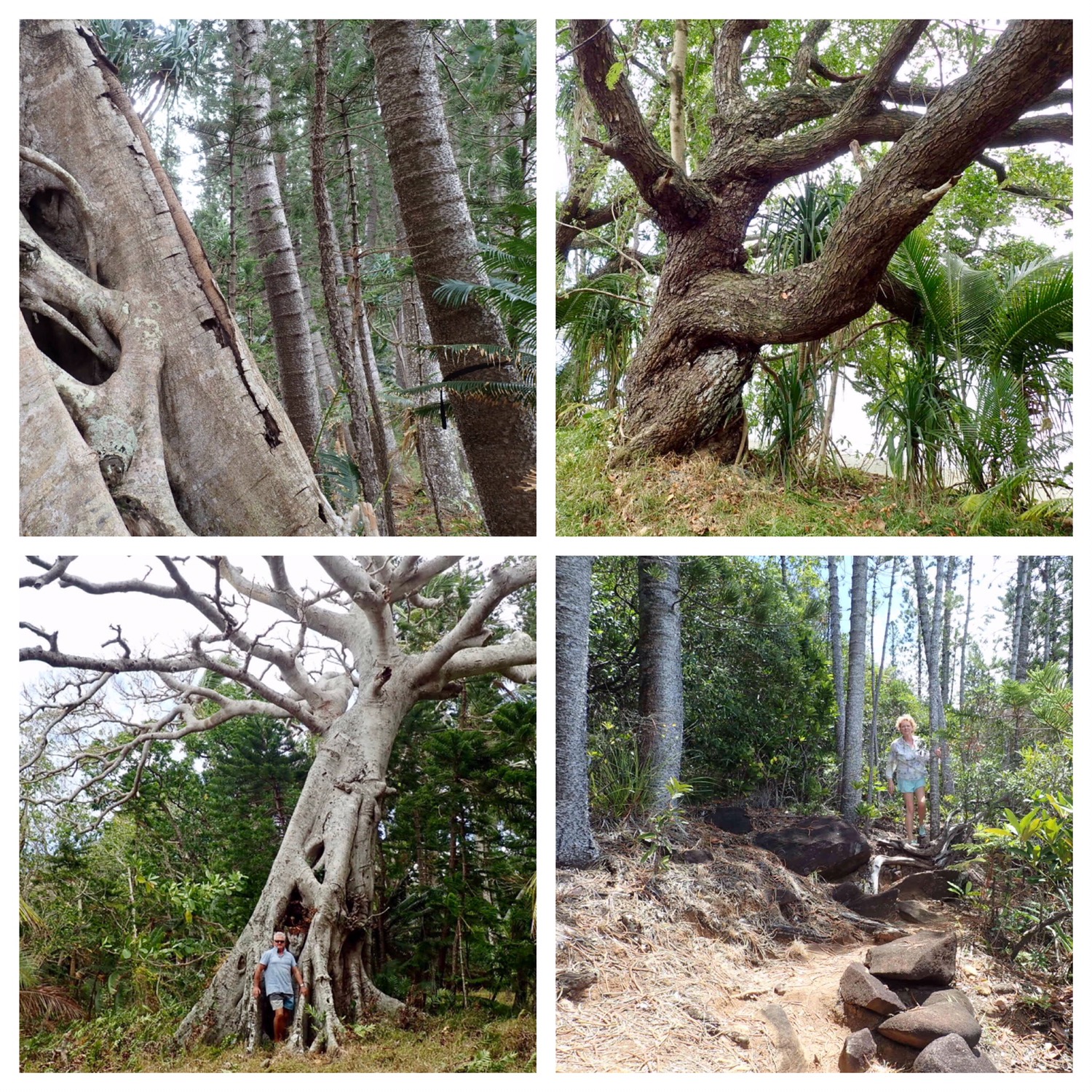
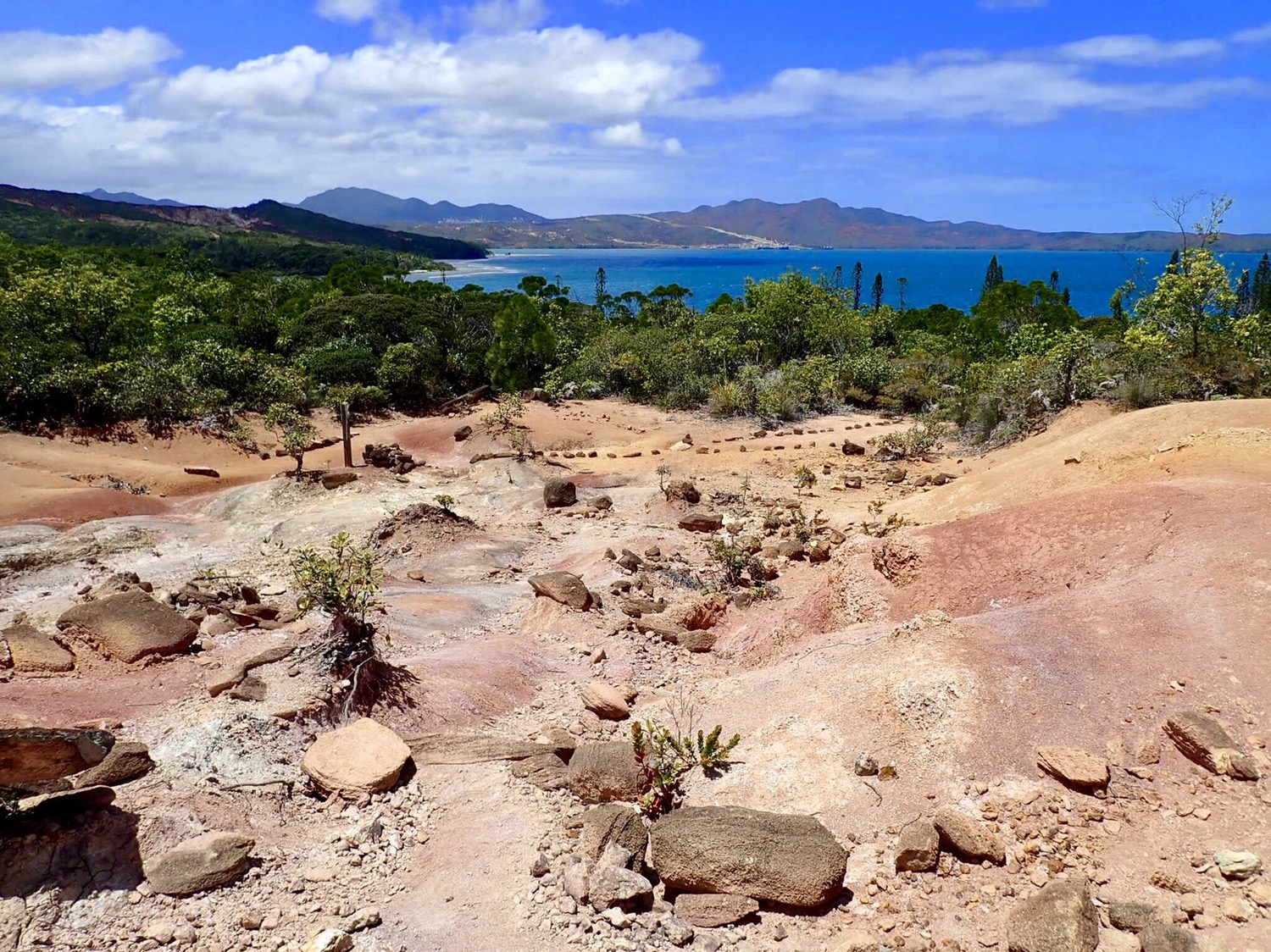 View from the top of Ile de Casy
View from the top of Ile de Casy Early morning view from the cockpit
Early morning view from the cockpit Beach at Kuto Bay
Beach at Kuto Bay Kanumera Bay
Kanumera Bay Giant cruise ship dwarfs the yachts in the anchorage
Giant cruise ship dwarfs the yachts in the anchorage Mermaid obviously
Mermaid obviously Dugong, not quite as pretty as a mermaid.
Dugong, not quite as pretty as a mermaid.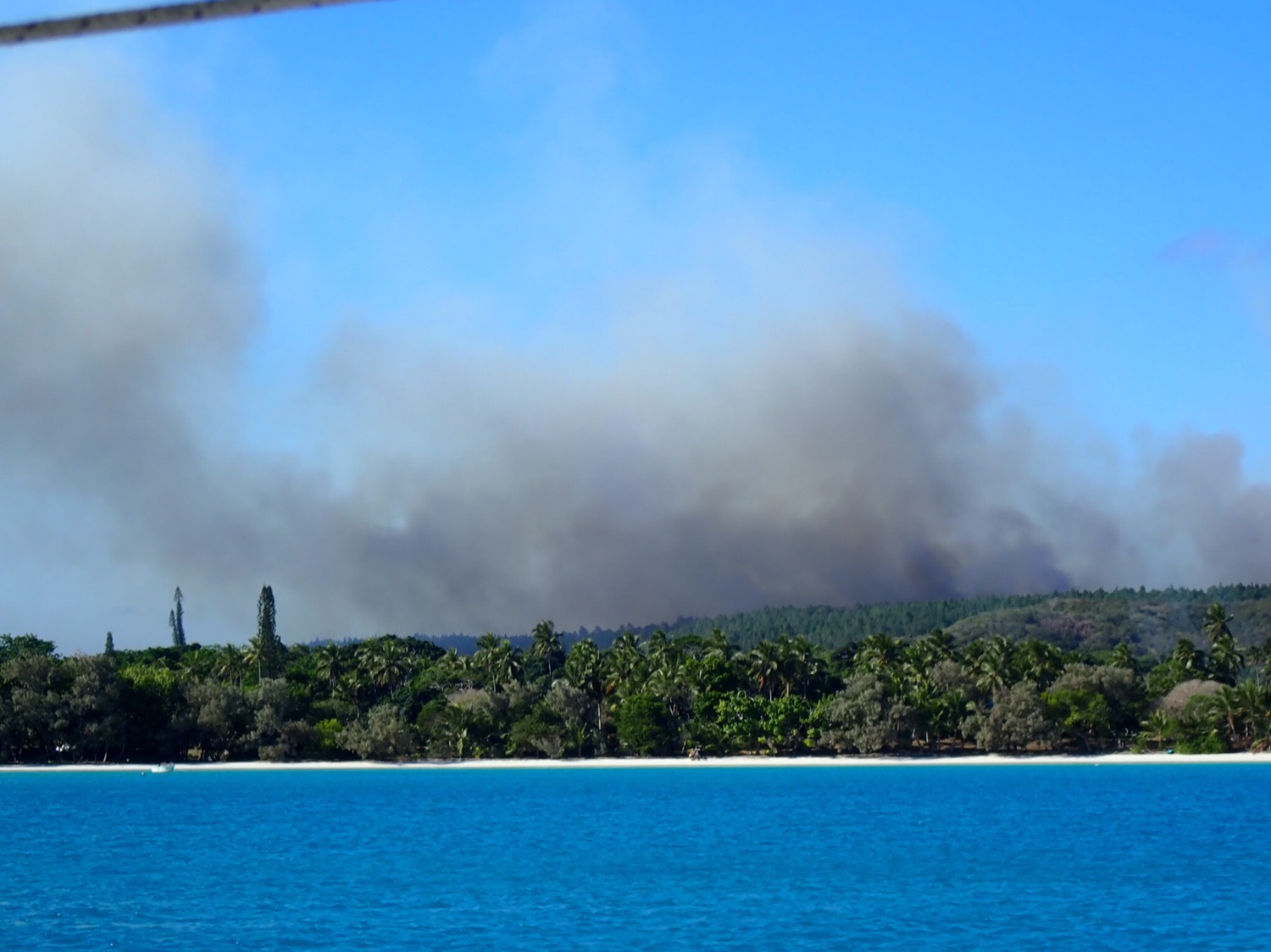 Forest fire
Forest fire Kite surfers enjoying the high winds, off the beaches to the South of Noumea
Kite surfers enjoying the high winds, off the beaches to the South of Noumea
 La Rivière Bleue
La Rivière Bleue Ghost Trees
Ghost Trees Cagou
Cagou Red Footed Booby hitches a ride
Red Footed Booby hitches a ride Mirror like silky seas
Mirror like silky seas Got here beer in blowy New Caledonia
Got here beer in blowy New Caledonia Crystal clear waters at beautiful Navandra
Crystal clear waters at beautiful Navandra Motoring out of Vuda Marina
Motoring out of Vuda Marina Sailing into the sunset
Sailing into the sunset
 Excellent snorkelling off Manta Ray Island Resort
Excellent snorkelling off Manta Ray Island Resort Team Raya on the sand bank at Musket Cove
Team Raya on the sand bank at Musket Cove
 Sawa I Lau
Sawa I Lau Blue spotted Ray
Blue spotted Ray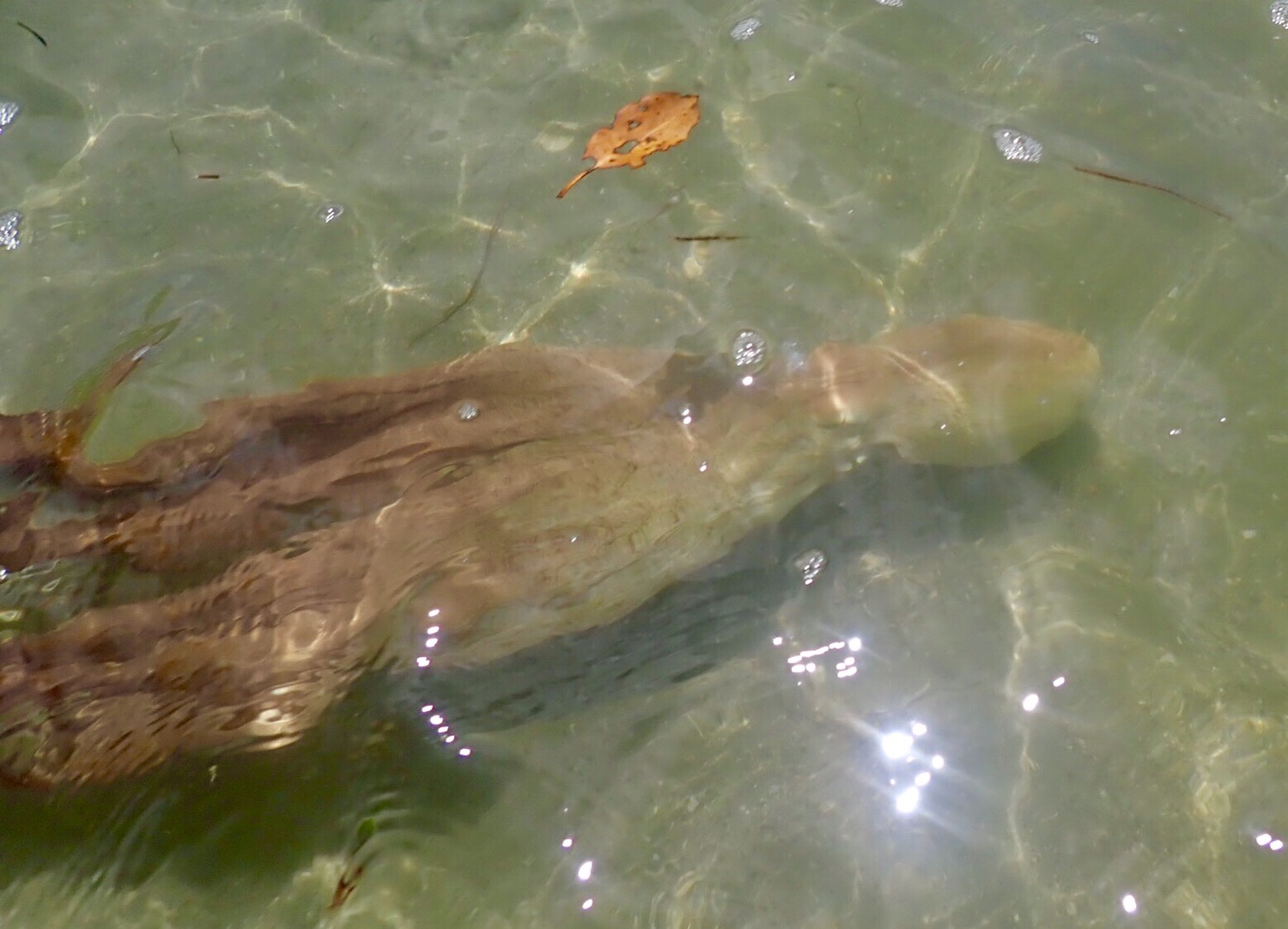 Octopus on the beach at Waitui Basecamp
Octopus on the beach at Waitui Basecamp Windward side of Nanuya
Windward side of Nanuya Intrepid explorers
Intrepid explorers The journey so far.
The journey so far. Basic route back to Europe
Basic route back to Europe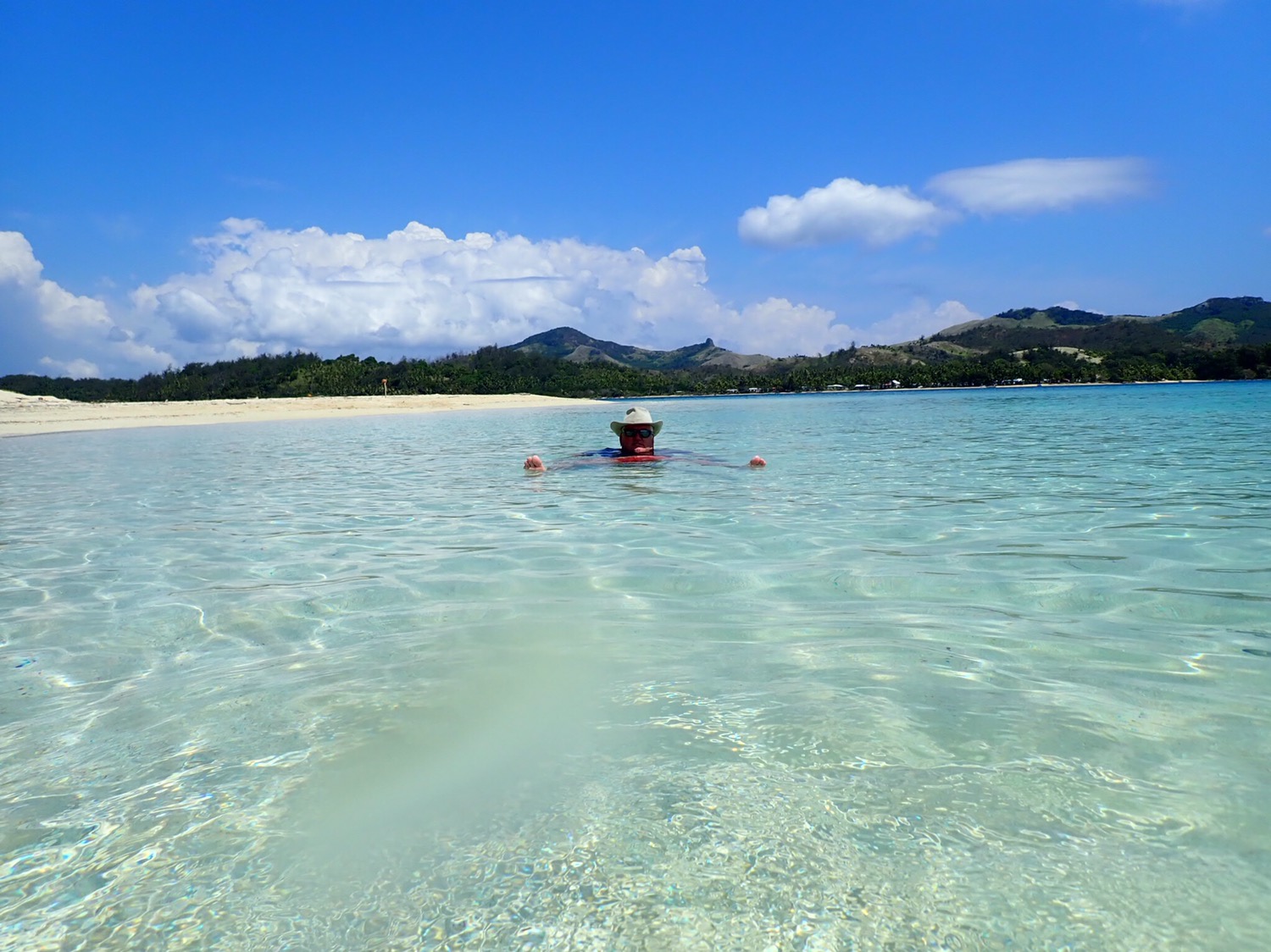 Rick contemplating the future.
Rick contemplating the future. Sasha and Julia enjoying the calm sea.
Sasha and Julia enjoying the calm sea. Water spout just a mile behind us
Water spout just a mile behind us
 Trim for Rick
Trim for Rick Ash in control
Ash in control Scooping up the krill has he comes to the surface.
Scooping up the krill has he comes to the surface. Back flips exposing the white underbelly and two remora.
Back flips exposing the white underbelly and two remora.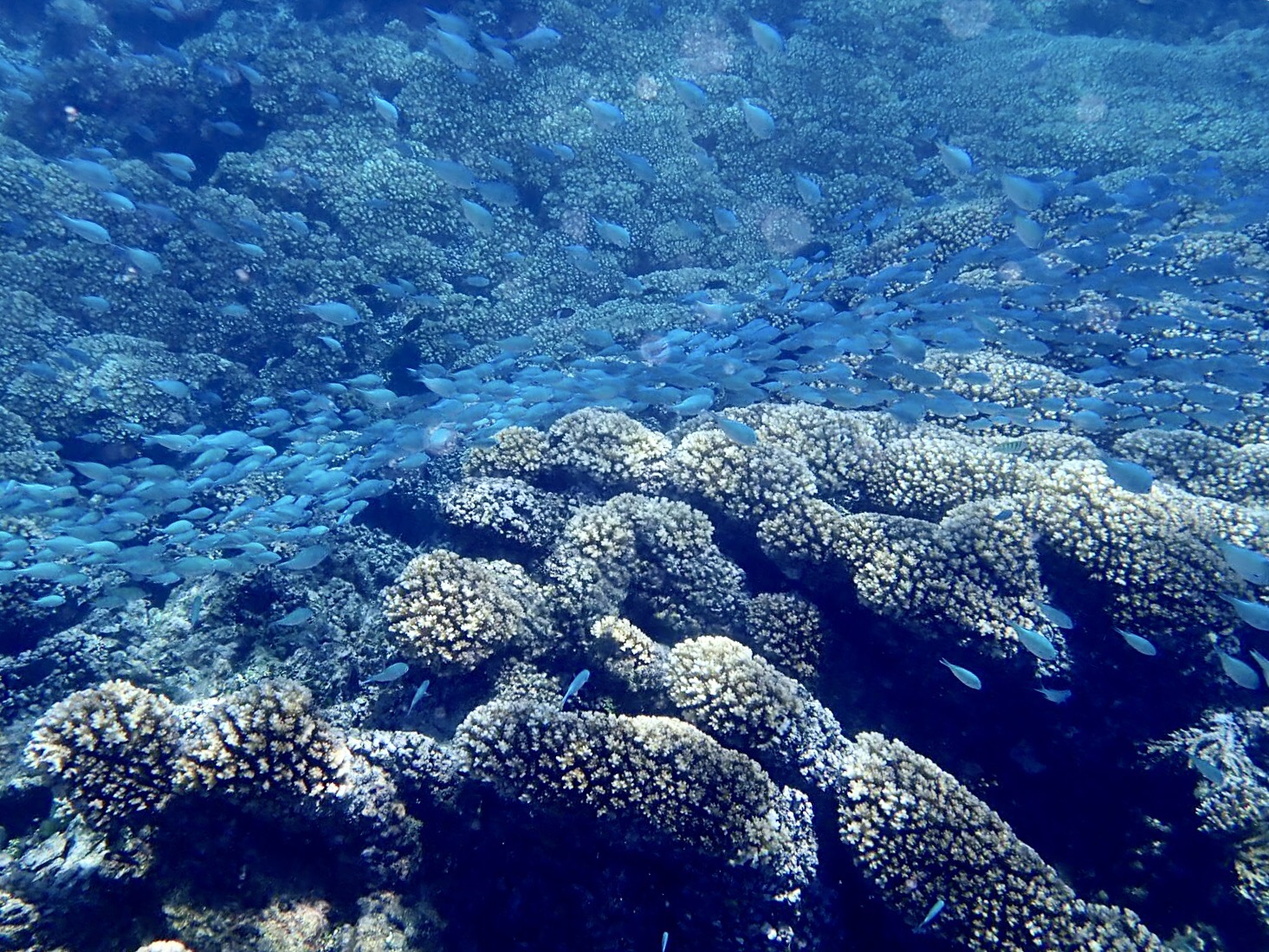 Rivers of Chromis sweep over the coral
Rivers of Chromis sweep over the coral At anchor off Sandy Cay
At anchor off Sandy Cay The extreme beer drinking experiment was not really a success
The extreme beer drinking experiment was not really a success Pretty place to tie up to the dock – Musket Cove Marina
Pretty place to tie up to the dock – Musket Cove Marina Charlie and George on the sandbank, Musket Cove
Charlie and George on the sandbank, Musket Cove  Picasso Trigger Fish
Picasso Trigger Fish
 Raya at anchor in the Blue Lagoon
Raya at anchor in the Blue Lagoon Fridge delivery
Fridge delivery The larger of the two landing craft keeping the islands supplied with goods.
The larger of the two landing craft keeping the islands supplied with goods. The Yasawa Flyer
The Yasawa Flyer Not the best time to chose to take out the kayak.
Not the best time to chose to take out the kayak. Snorkelling in Navandra Bay
Snorkelling in Navandra Bay
 Tony and Gilly enjoying the snorkelling
Tony and Gilly enjoying the snorkelling Great having Matt onboard
Great having Matt onboard


 . Gilly feeding the Sargent Major's
. Gilly feeding the Sargent Major's Limestone caves at Saw-I-Lau
Limestone caves at Saw-I-Lau



















































































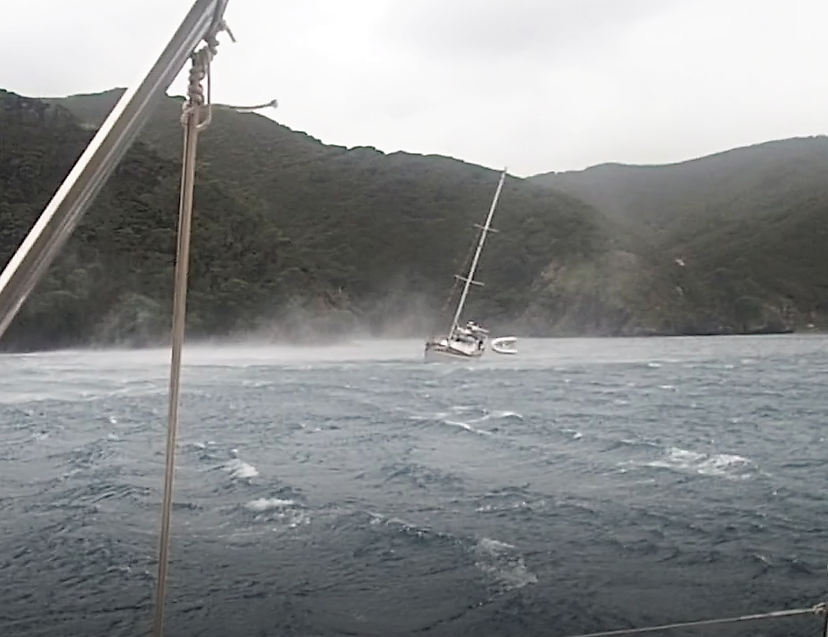













































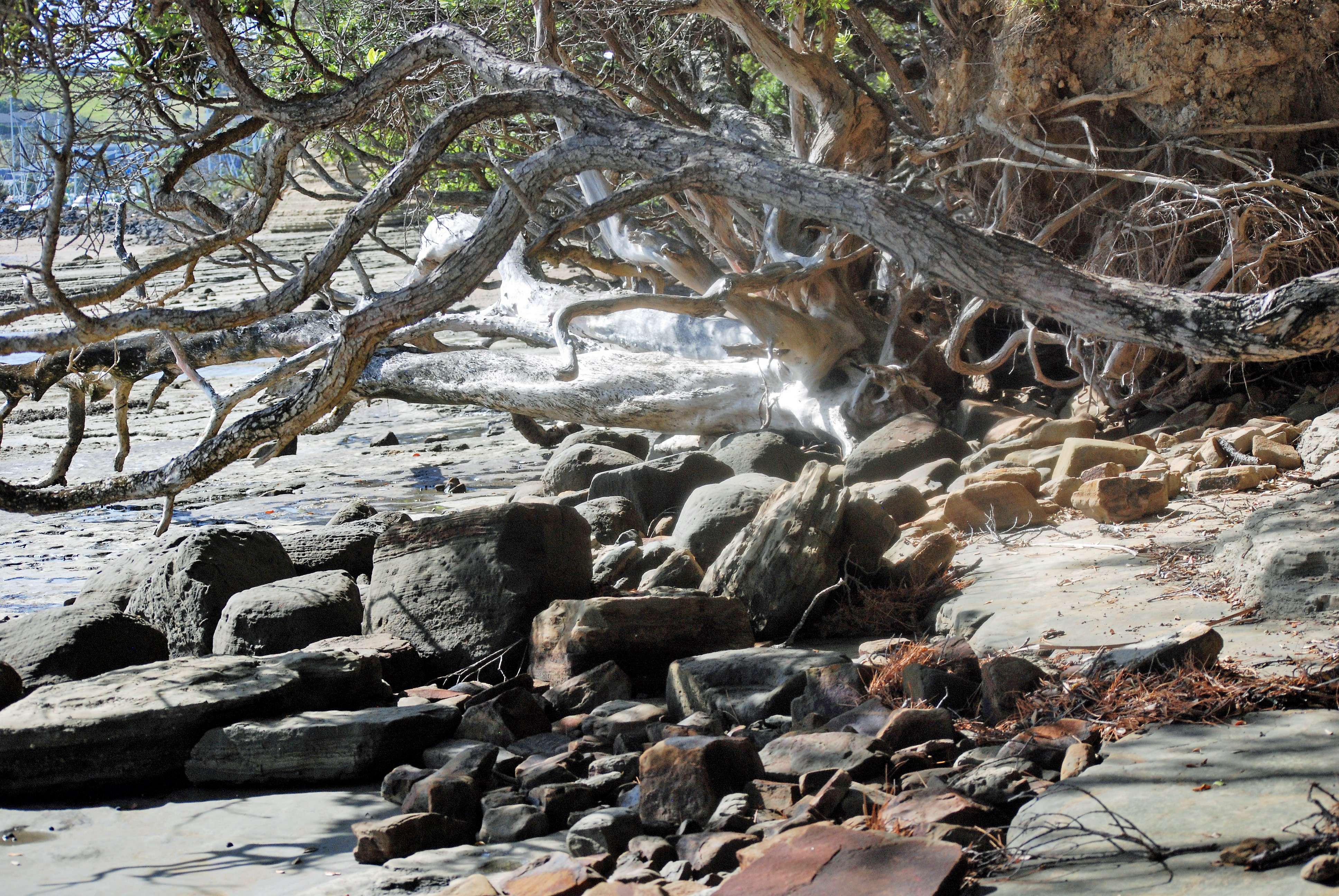
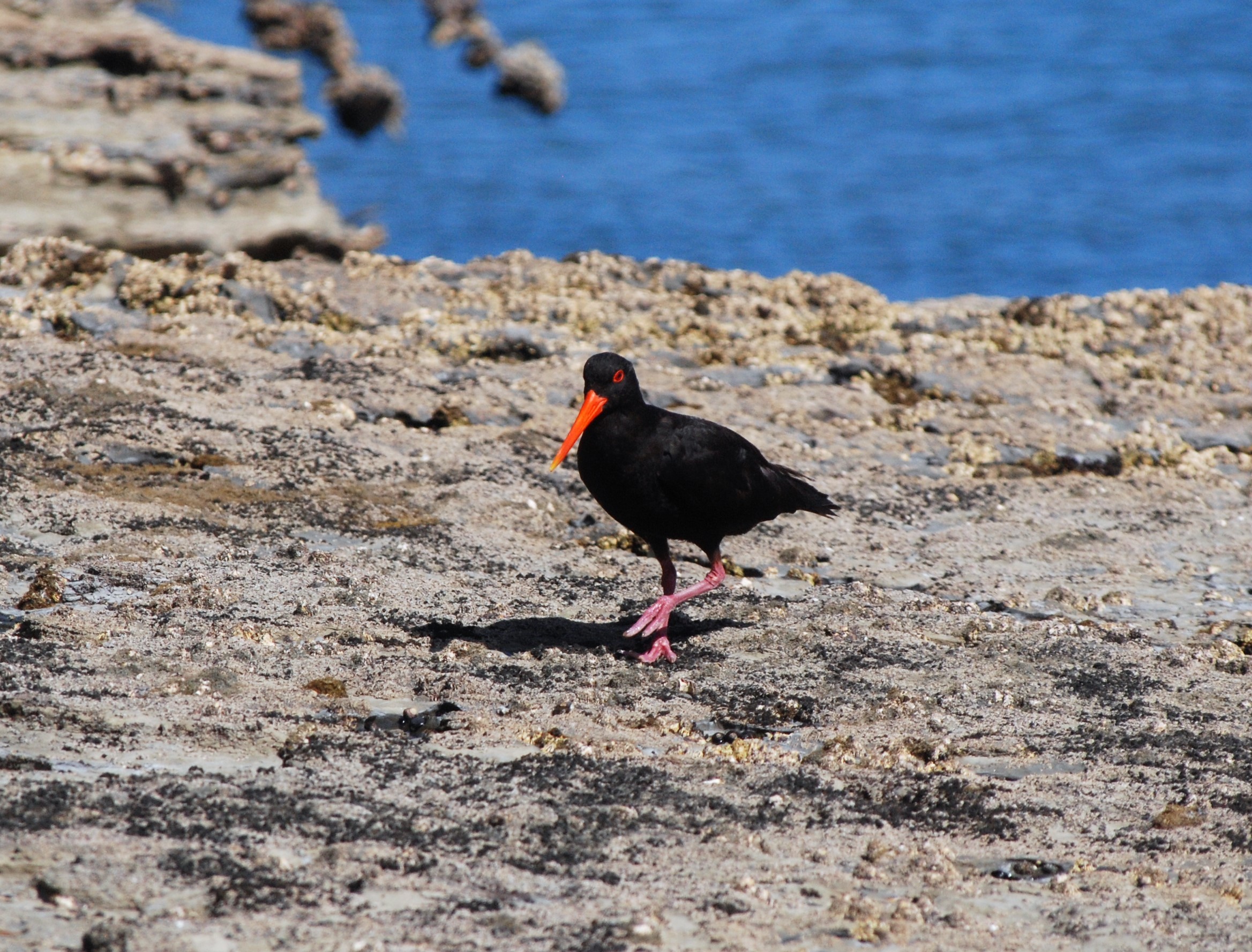






























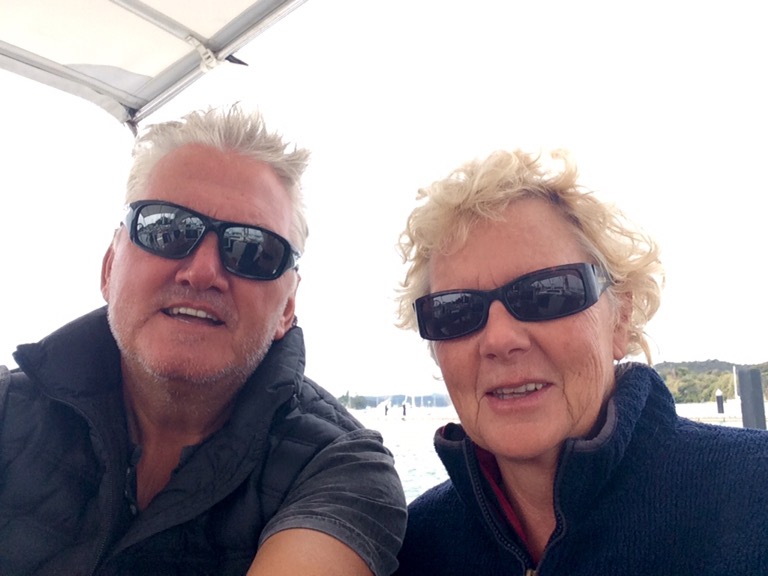




















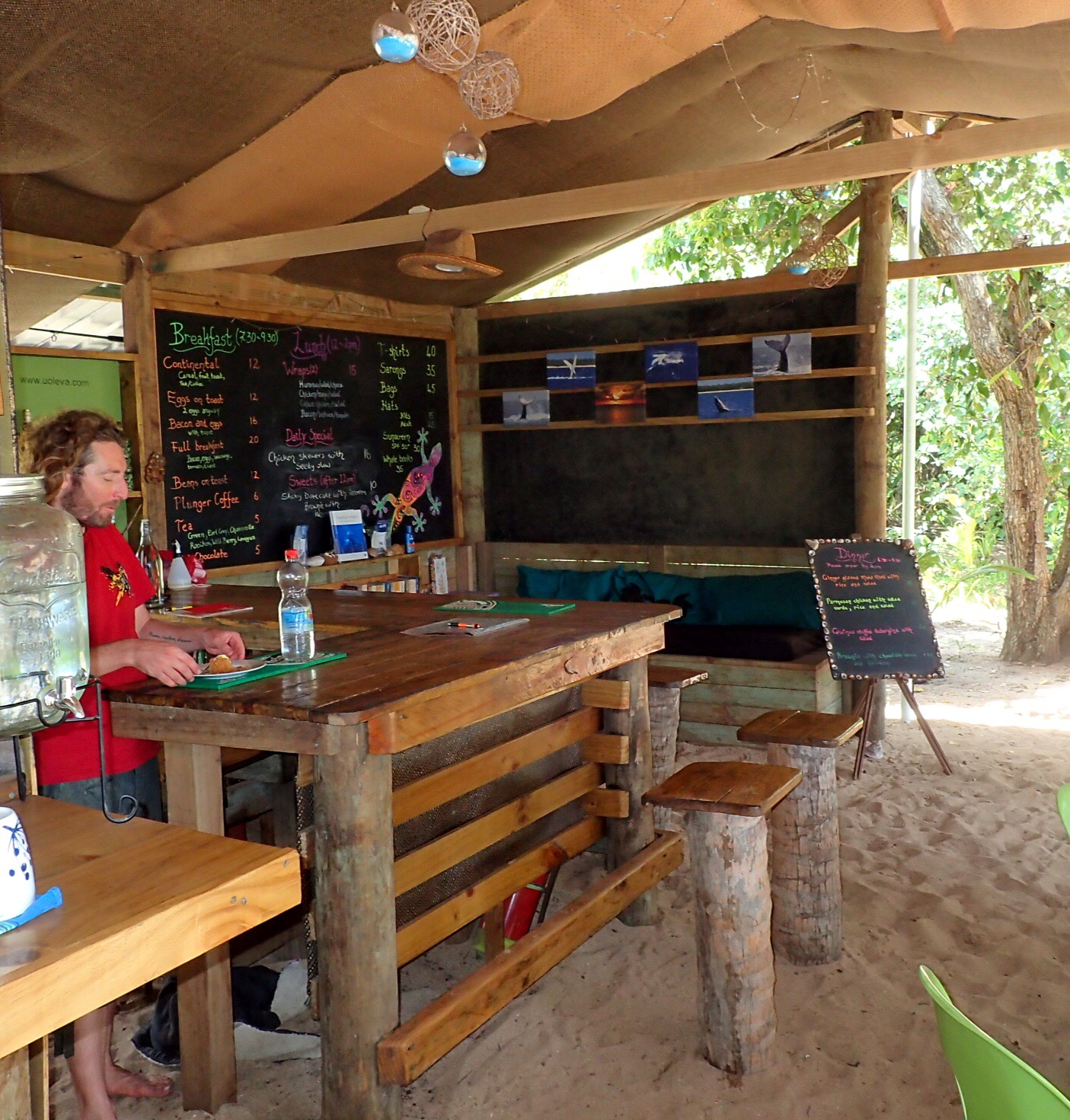

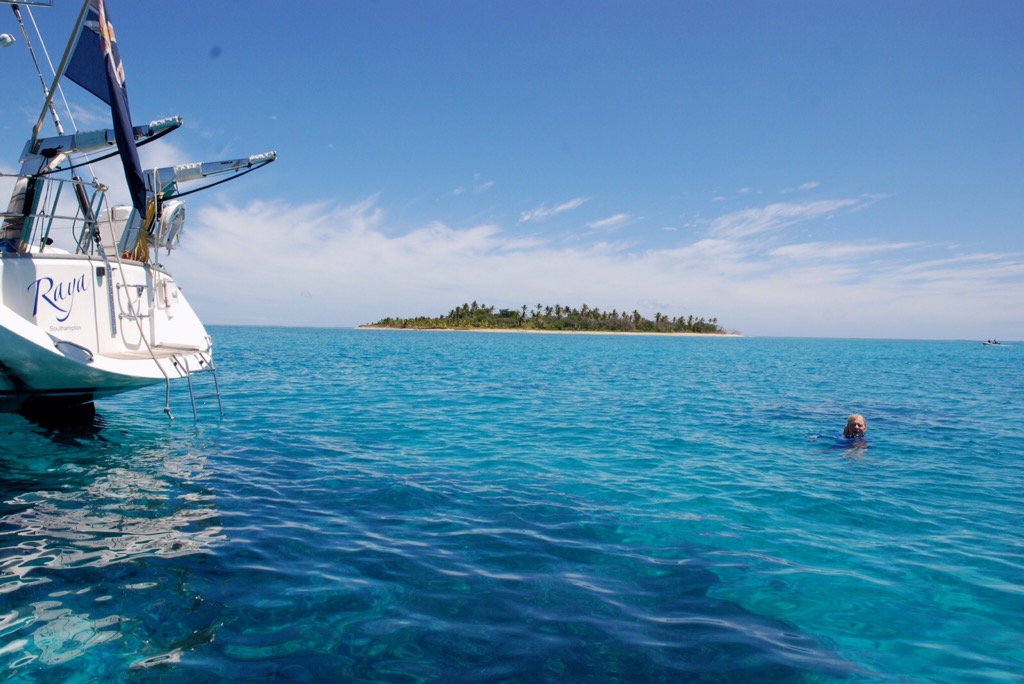



































































































































































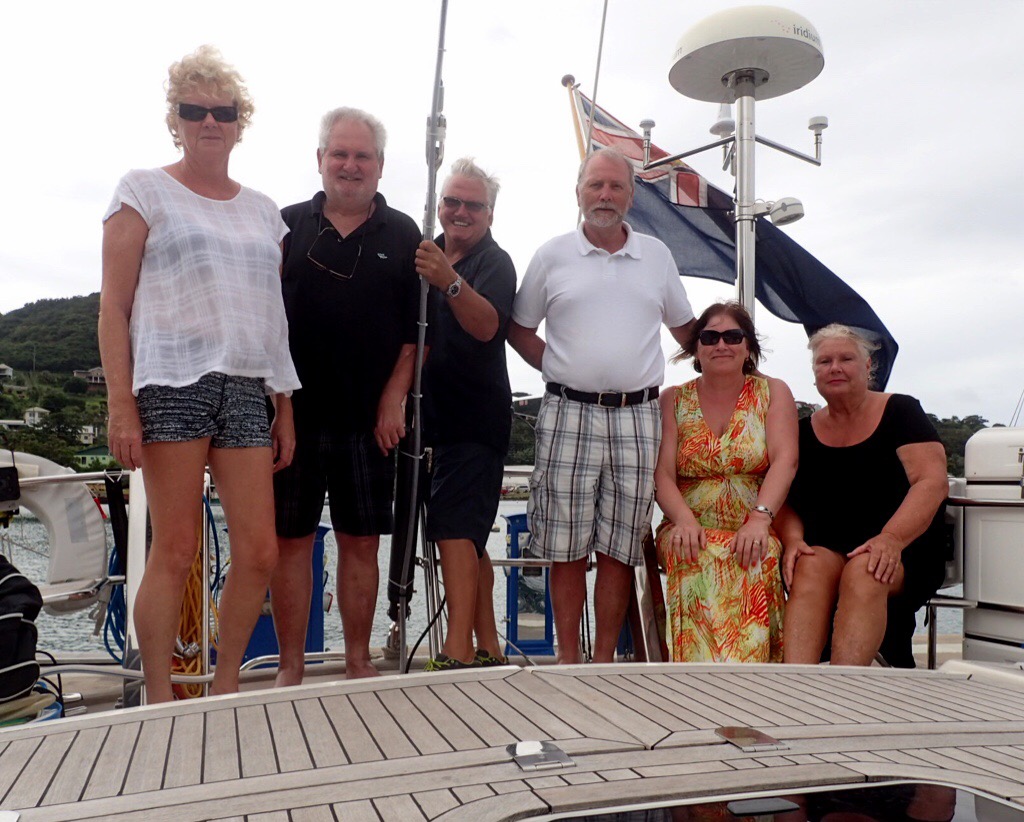






























































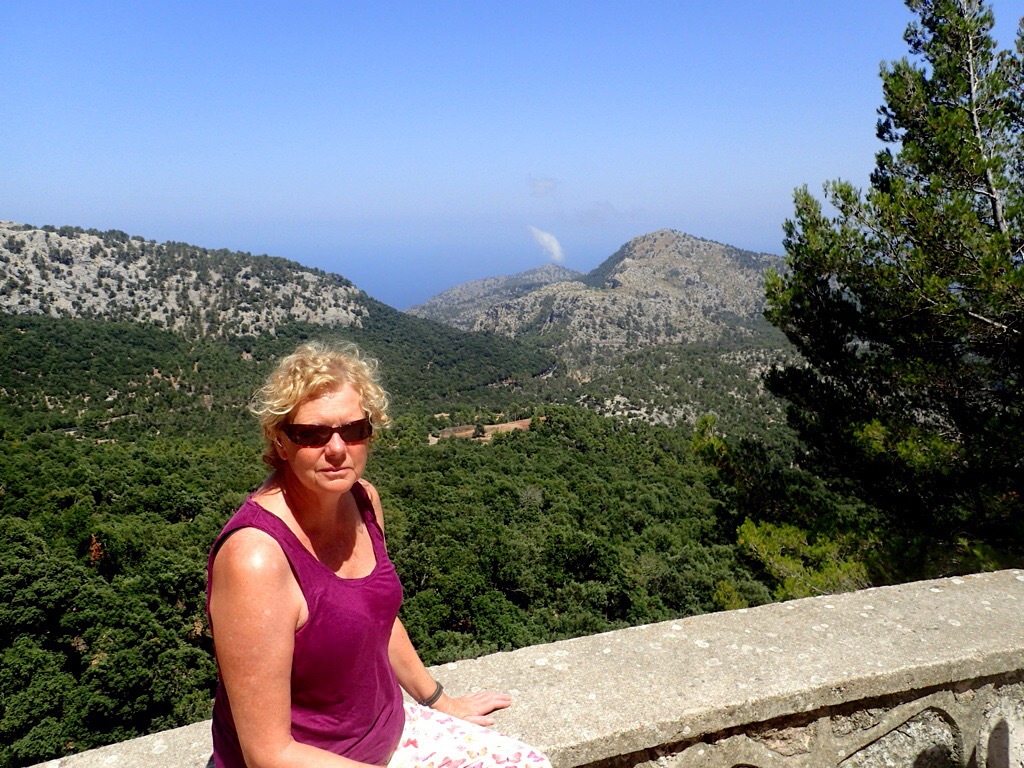




























 As we now find ourselves tied up, on show, right outside the restaurant and bar of the Real Club Nautico, where by the amount of flags around they obviously are into such things, we decided to put it up and as it turns out it does looks rather good, dare I note – that it really goes well with the blue color scheme.
As we now find ourselves tied up, on show, right outside the restaurant and bar of the Real Club Nautico, where by the amount of flags around they obviously are into such things, we decided to put it up and as it turns out it does looks rather good, dare I note – that it really goes well with the blue color scheme. 

 So every couple of marinas we visit we have the delight of spending hours and Euros in the laundry facilities. We do have a small washing machine onboard but not a tumble dryer and Rick takes some persuading to let me hang it out over the boat. Here in our prominent position in the marina even I agree that we couldn’t really cover the decks and rigging with our freshly washed bedding – luxury yacht or Chinese laundry?
So every couple of marinas we visit we have the delight of spending hours and Euros in the laundry facilities. We do have a small washing machine onboard but not a tumble dryer and Rick takes some persuading to let me hang it out over the boat. Here in our prominent position in the marina even I agree that we couldn’t really cover the decks and rigging with our freshly washed bedding – luxury yacht or Chinese laundry?

















 But what a difference a day makes. We are now sitting in the boat feeling rather down hearted. The forecast storm has been battering us all day, we have had sustained winds of 30kts, with gusts of 50kts. There are proper waves in the marina!
But what a difference a day makes. We are now sitting in the boat feeling rather down hearted. The forecast storm has been battering us all day, we have had sustained winds of 30kts, with gusts of 50kts. There are proper waves in the marina!
 It has been a mammoth task trying to decide exactly what to take with us and I have to thank our Doctor friend Peter and his colleagues for all the work they have put into getting everything together for us. We all feel that we have probably far too much stuff and hope that we will never need any of it, but nobody will be able to accuse us of not being prepared. I have to also say a big thanks to Peters wife Joanna who must have spent hours bagging and labelling everything up, the First Aid boxes are definitely the most organised part of the boat. No pressure with all the spares then Rick!
It has been a mammoth task trying to decide exactly what to take with us and I have to thank our Doctor friend Peter and his colleagues for all the work they have put into getting everything together for us. We all feel that we have probably far too much stuff and hope that we will never need any of it, but nobody will be able to accuse us of not being prepared. I have to also say a big thanks to Peters wife Joanna who must have spent hours bagging and labelling everything up, the First Aid boxes are definitely the most organised part of the boat. No pressure with all the spares then Rick! We have had plenty of visitors over the last couple of weeks and with all this warm weather have been eating on deck, from our laps, off towels as table cloths and from Ricks work bench. Typically the moment we have a proper table the temperature has dropped and today we ate lunch below. Never mind it looks great and will be in full use very soon.
We have had plenty of visitors over the last couple of weeks and with all this warm weather have been eating on deck, from our laps, off towels as table cloths and from Ricks work bench. Typically the moment we have a proper table the temperature has dropped and today we ate lunch below. Never mind it looks great and will be in full use very soon. together. Unfortunately the weather didn’t live up to the occasion, the sun struggled and broke through the clouds occasionally but it was decidedly chilly, note the interesting head wear, and there was barely a breath of wind. Luckily we had nowhere particular to be and so could go where the best of the light winds took us.
together. Unfortunately the weather didn’t live up to the occasion, the sun struggled and broke through the clouds occasionally but it was decidedly chilly, note the interesting head wear, and there was barely a breath of wind. Luckily we had nowhere particular to be and so could go where the best of the light winds took us. d in the front of our minds, we left out and cleaned the poles for the Bimini so we could test the new canvas cover. It took a couple of hours to work it all out, amusing those around us as we struggled with poles, ropes and canvas, but we got it up eventually and great it looked too, Dolphin sails have done a fantastic job.
d in the front of our minds, we left out and cleaned the poles for the Bimini so we could test the new canvas cover. It took a couple of hours to work it all out, amusing those around us as we struggled with poles, ropes and canvas, but we got it up eventually and great it looked too, Dolphin sails have done a fantastic job.  We are just back from a three day cruise to test out Raya post refit and work out the best way to sail her with just the two of us. We were accompanied by Oyster guru and font of all knowledge Andy Willet from Stella Maris where she has been all winter. We had a fantastic time, she sailed really well, the weather despite a dodgy forecast was superb and the crew (Rick and I) did OK. It was great to be out on the water, especially for the first time with a full set of sails and we used them all, in every configuration possible. The boy likes his boat.
We are just back from a three day cruise to test out Raya post refit and work out the best way to sail her with just the two of us. We were accompanied by Oyster guru and font of all knowledge Andy Willet from Stella Maris where she has been all winter. We had a fantastic time, she sailed really well, the weather despite a dodgy forecast was superb and the crew (Rick and I) did OK. It was great to be out on the water, especially for the first time with a full set of sails and we used them all, in every configuration possible. The boy likes his boat.  Then we sailed into the Solent to practice gybing and tacking, our first time not only in such a large boat but with fully electric winches and hydraulic furlers. So for my part at least, as instructions were given, there was plenty of brain crisis as I had to decide not only which sheet or halyard to use but which button to press. We dropped Chris in Cowes and with tide and time against us we headed up the Beaulieu River and tied up at Bucklers Hard. Time for a glass of fizz, we had successfully completed our first day.
Then we sailed into the Solent to practice gybing and tacking, our first time not only in such a large boat but with fully electric winches and hydraulic furlers. So for my part at least, as instructions were given, there was plenty of brain crisis as I had to decide not only which sheet or halyard to use but which button to press. We dropped Chris in Cowes and with tide and time against us we headed up the Beaulieu River and tied up at Bucklers Hard. Time for a glass of fizz, we had successfully completed our first day. 
 Andy was keen that we got in some night sailing so we continued out into The Channel until darkness fell and then turned back to face the challenge of sailing up the Needles Channel and into Yarmouth harbour in the dark. As we turned the confusing backdrop of the lights of the Solent faced us, we had seen the breaking waves over the shallows either side of the channel as we had passed through an hour ago and just to add a little spice a 200 ton tanker conspired to be at the red marker buoy at exactly the same moment as us. However we made it through and were safely tied up in Yarmouth Harbour by eight thirty, tired, cold and hungry but with smiles on our faces.
Andy was keen that we got in some night sailing so we continued out into The Channel until darkness fell and then turned back to face the challenge of sailing up the Needles Channel and into Yarmouth harbour in the dark. As we turned the confusing backdrop of the lights of the Solent faced us, we had seen the breaking waves over the shallows either side of the channel as we had passed through an hour ago and just to add a little spice a 200 ton tanker conspired to be at the red marker buoy at exactly the same moment as us. However we made it through and were safely tied up in Yarmouth Harbour by eight thirty, tired, cold and hungry but with smiles on our faces.  Finally back up the Itchen we finished our day with a bit of stern to parking, a good opportunity for Rick to practice his boat handling skills and for me to perfect my rope work. Thanks Chris for being target practice for my rather dodgy throwing. A busy few days with two exhausted sailors, but invaluable. We have come away with another frighteningly long “to do list” but nothing major went wrong and Raya performed brilliantly.
Finally back up the Itchen we finished our day with a bit of stern to parking, a good opportunity for Rick to practice his boat handling skills and for me to perfect my rope work. Thanks Chris for being target practice for my rather dodgy throwing. A busy few days with two exhausted sailors, but invaluable. We have come away with another frighteningly long “to do list” but nothing major went wrong and Raya performed brilliantly. the sunshine by working on jobs outside.
the sunshine by working on jobs outside. Eventually, cleaned up and one more roll of paper towel down, the innards of the winch lay polished and gleaming on the salon table, let’s hope Rick can remember how to get it back together!
Eventually, cleaned up and one more roll of paper towel down, the innards of the winch lay polished and gleaming on the salon table, let’s hope Rick can remember how to get it back together!

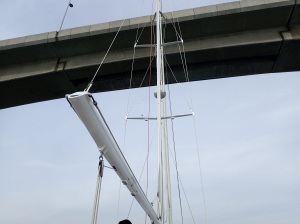 from experience that the optical illusion of the angles means that you can’t see the gap, we have Andy on board who has done this a thousand times reassuring us but it still appears impossible that we will fit beneath, in the end you have to trust in the calculations and just, very slowly, go for it. Scarily, even as you pass under it, it still doesn’t appear that you will fit!
from experience that the optical illusion of the angles means that you can’t see the gap, we have Andy on board who has done this a thousand times reassuring us but it still appears impossible that we will fit beneath, in the end you have to trust in the calculations and just, very slowly, go for it. Scarily, even as you pass under it, it still doesn’t appear that you will fit!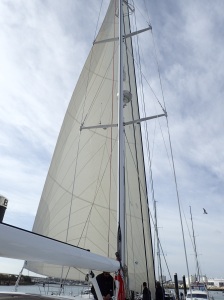 orning with the help of Andy and Chris from Stella Maris we bent on the staysail and genoa, both went on smoothly and for a few minutes as they bellowed in the gentle breeze we got a glimpse of how Raya was going to look at sea.
orning with the help of Andy and Chris from Stella Maris we bent on the staysail and genoa, both went on smoothly and for a few minutes as they bellowed in the gentle breeze we got a glimpse of how Raya was going to look at sea.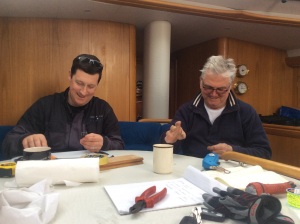 when I left, were on deck sorting out a huge pile of lines, sitting at the table doing what looked on first glance like knitting. Thankfully it wasn’t that Rick had completely lost the plot, the needles were Fids and the yarn Dyneema line, Andy was helping him splice loops for the preventer lines on the boom.
when I left, were on deck sorting out a huge pile of lines, sitting at the table doing what looked on first glance like knitting. Thankfully it wasn’t that Rick had completely lost the plot, the needles were Fids and the yarn Dyneema line, Andy was helping him splice loops for the preventer lines on the boom.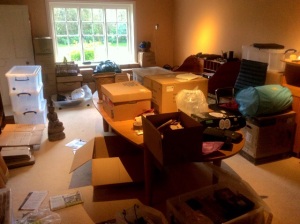 ng mountains of boxes and spending frustrating hours on the computer pleading with BT, British Gas or Sky to remind me of my passwords, because I can’t remember on their new system whether it should have capitals, underscores or whatever and whether the secret word was the last favourite pet or one of the six previous ones. In between times I’m hoovering out cupboards disturbing poor spiders that have been living harmlessly
ng mountains of boxes and spending frustrating hours on the computer pleading with BT, British Gas or Sky to remind me of my passwords, because I can’t remember on their new system whether it should have capitals, underscores or whatever and whether the secret word was the last favourite pet or one of the six previous ones. In between times I’m hoovering out cupboards disturbing poor spiders that have been living harmlessly 







